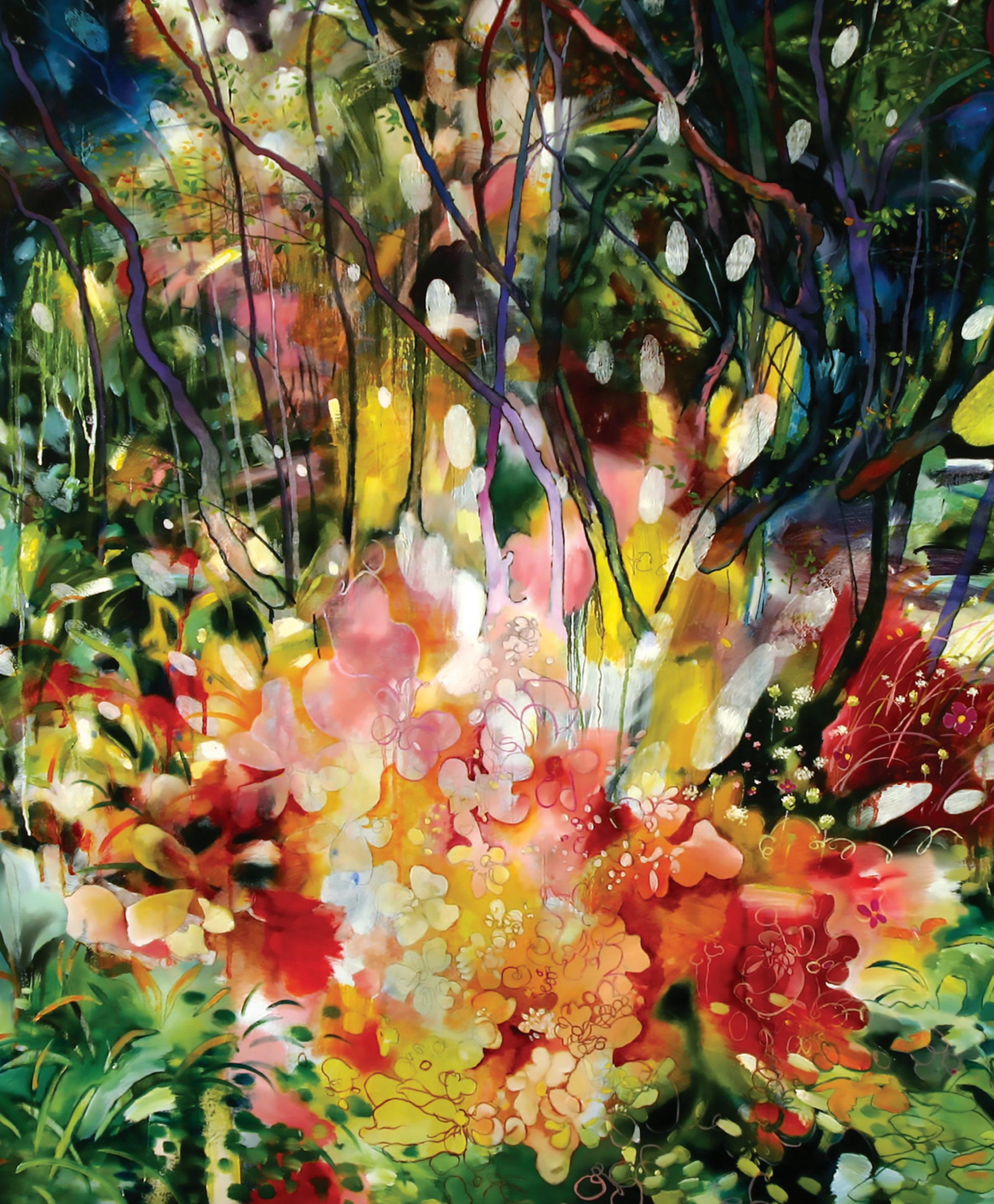
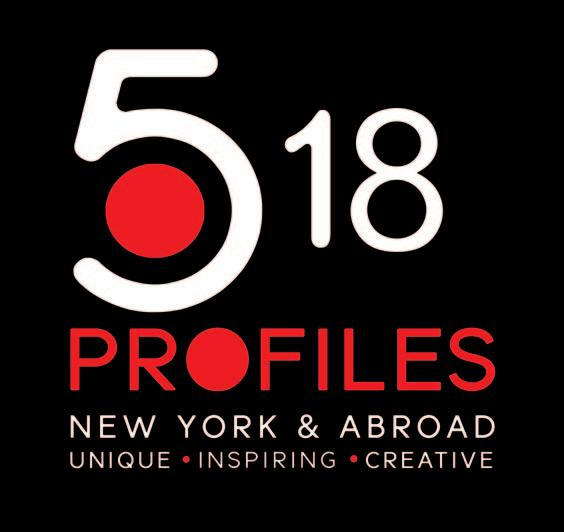
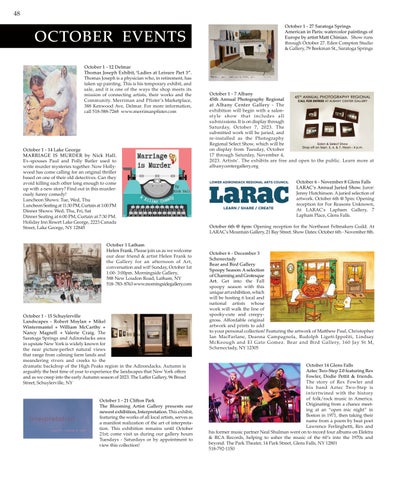


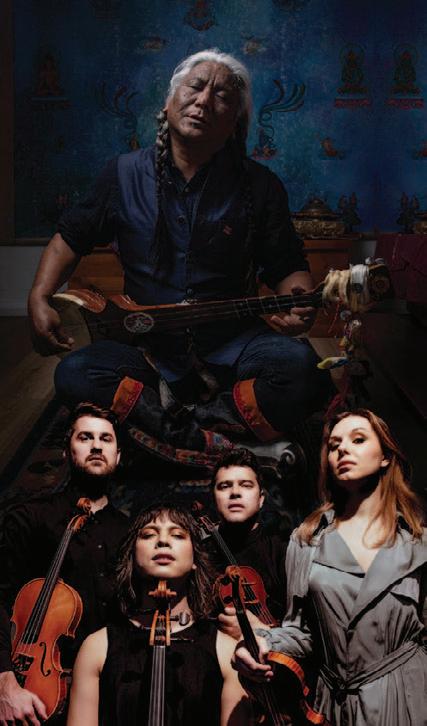
performing in an intimate, state-of-the-art venue, just minutes from downtown Saratoga Springs.


Most events are free and open to the public unless otherwise noted. For more information, including the complete fall program and online ticket sales, please visit: skidmore.edu/zankel
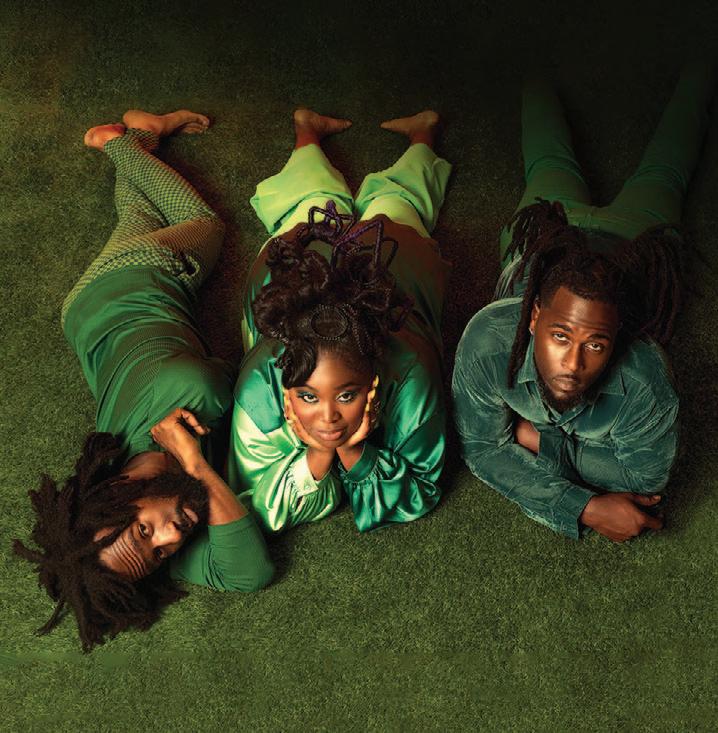
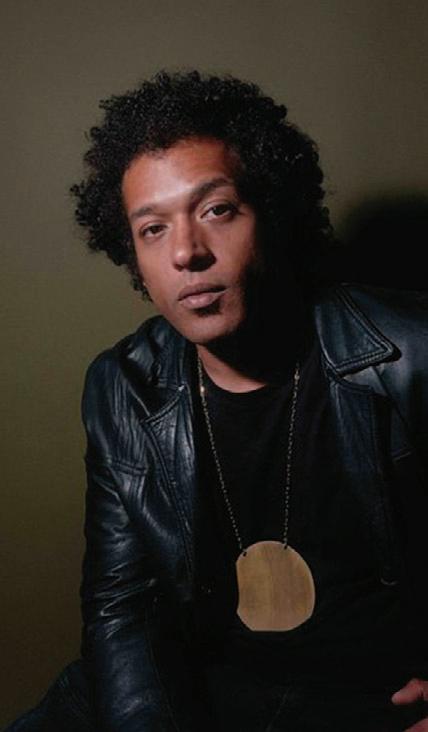
The Benevolent Spirit of Mighty Mount McGregor
pg. 6
PUBLISHER / FOUNDER
Stephanie Sittnick
COPY EDITOR
Elisabeth Allen
WEBMASTER
Tony Graveheart
ADVERTISING SALES
Stephanie Sittnick - Director of Sales
( 860) 227-8199 advertising@518mag.com
CONTRIBUTORS
Carol St.Sauveur Ferris, Karen Richman, Rona Mann
Chandler Stevens, Lawrence White, Kirsten Ferguson, Alan B. Richer, Crystal Cobert Giddens, Nellie Ackerman-Vellano, Kristina Watrobski
Chef Armand Vanderstigchel
COVER
“Heirloom” Christopher Murray
Welcome to the October issue! It’s the height of fall foliage season, and the perfect time to enjoy all that New York has to offer. From hikes to festivals and farm markets, crisp air and crisp apples, amazing hues of orange, yellow, red, and gold, fall somehow makes us all feel more alive. The houses are decked out for Halloween. We’ve already watched Hocus Pocus. It’s the time when we have witches and pumpkins and ghosts on my mind! Whether your pumpkin picking or ghost hunting, We hope you embrace this beautiful time of year.
This month , we had the opportunity to meet and profile wonderful, tal ented and unique artisans and destinations which compliments this October issue to per fection.
As always, our goal at 518 PROFILES, is always to focus on the good, the beautiful and the positive by publishing stories with heart and soul. We str ive each month to deliver authentic and unique content about cre ative people and interesting destinations. Enjoy!
 Stephanie Sittnick Founder / Publisher
Stephanie Sittnick Founder / Publisher
518 PROFILES 587 Grand Ave, Saratoga Springs, NY 12866
The Cultivation and Journey of an Artist/Educator: Christopher Murray
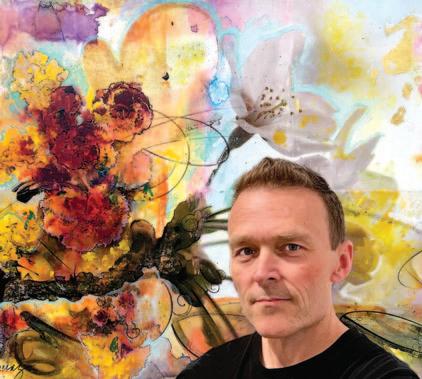

pg. 16
Feel the Magic of “Quilted Alchemy” in Saratoga Springs

Susan Rivers/Greentree Fiber Arts
pg. 26
It’s “Bread and Circus” in the Northeast Kingdom
The Bread and Puppet Theater and Museum

pg. 34
Sweet Nostalgia pg. 42
The Great Halloween Candy Caper of 1955
LIFEspa pg. 44
Aligning With The Moon
Culinary Destinations: pg. 46
Finger Lakes - Part 2
October Events pg. 48
Events throughout the Capital Region

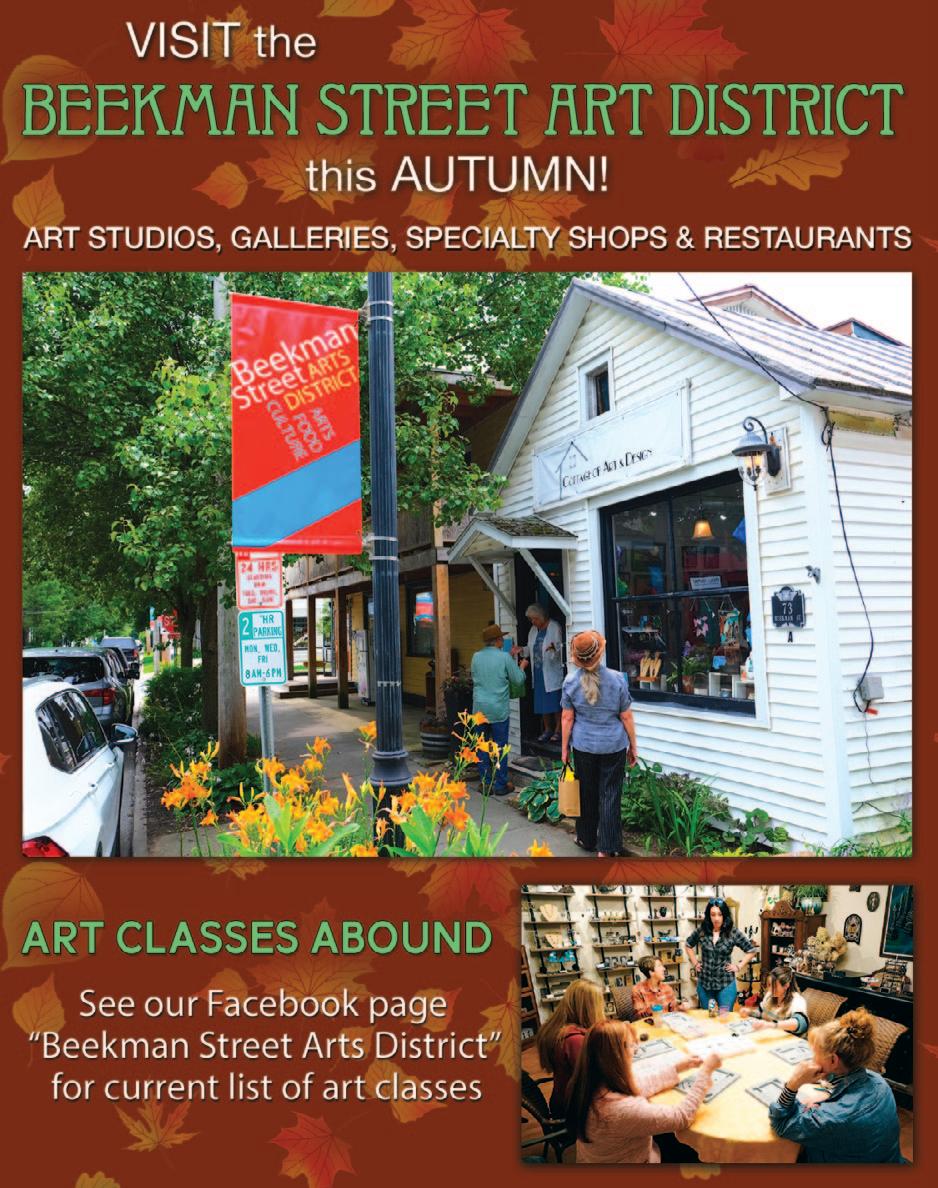
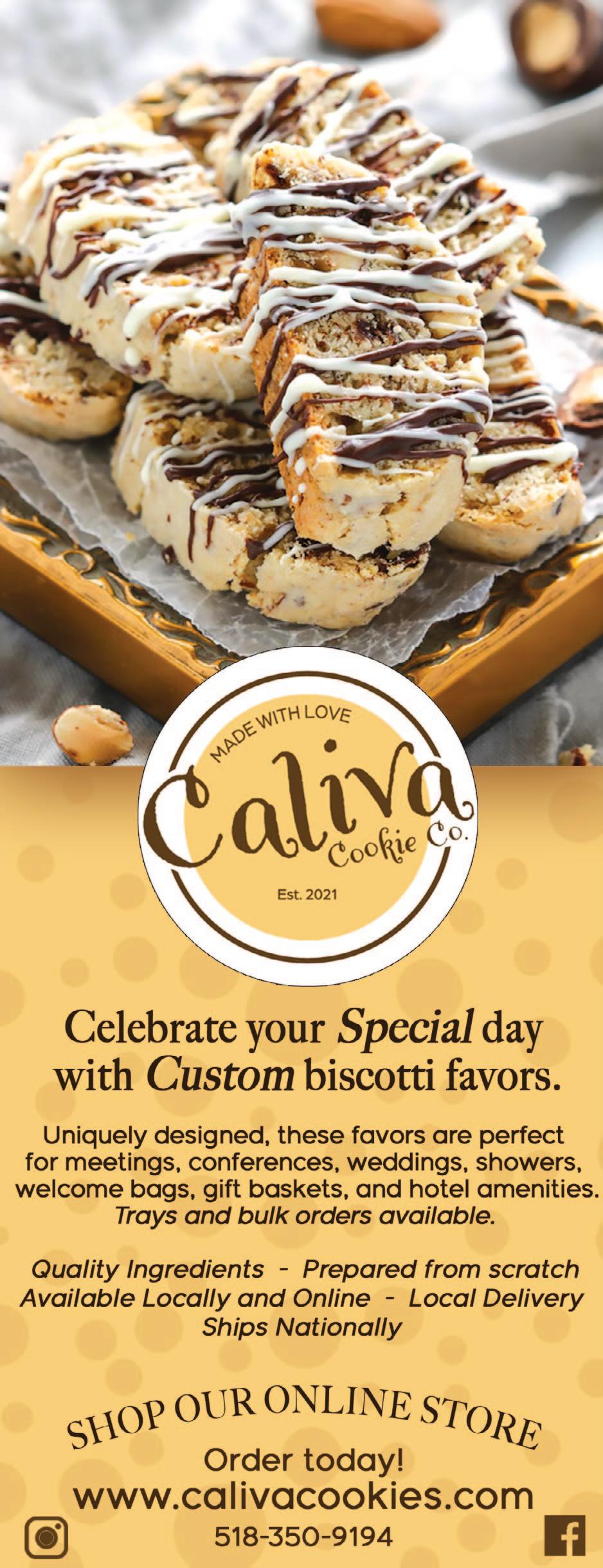
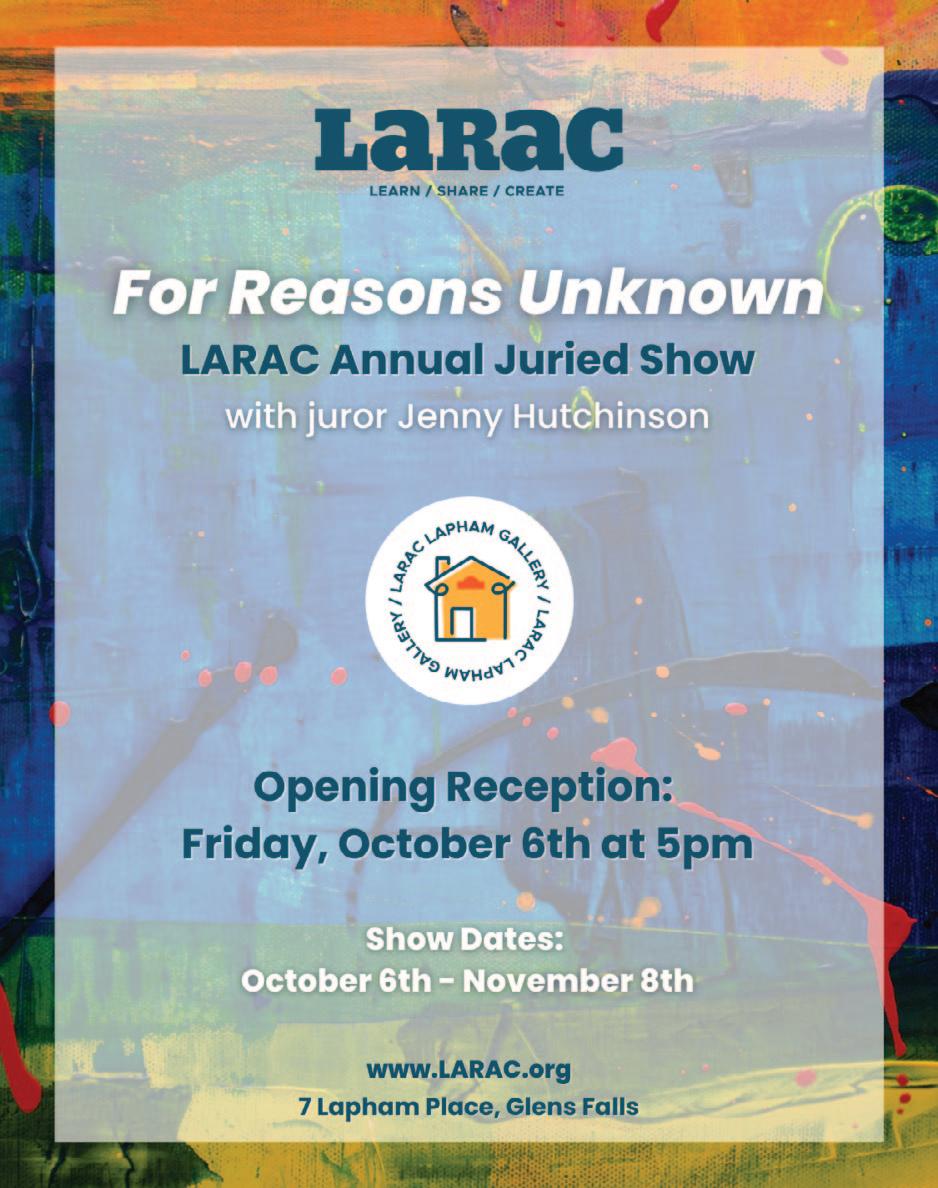

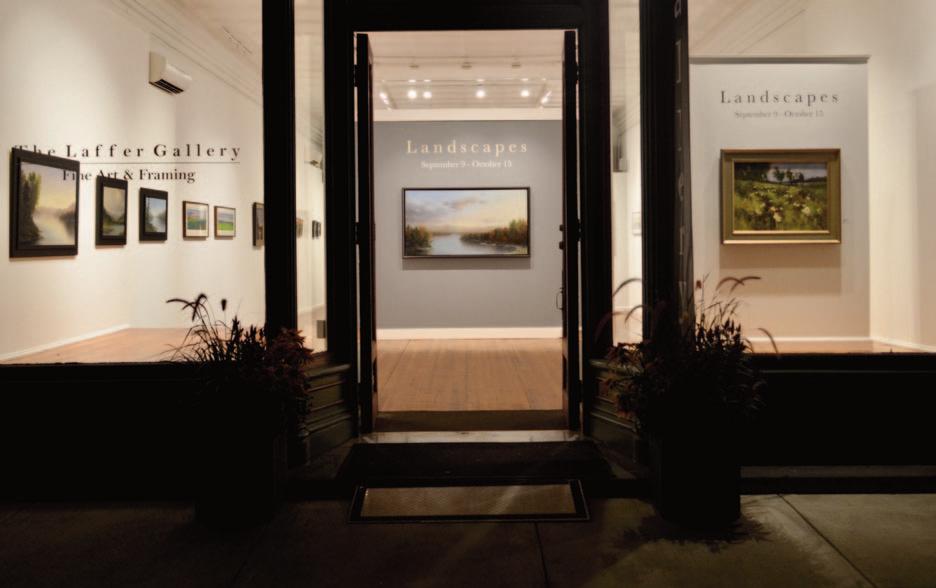

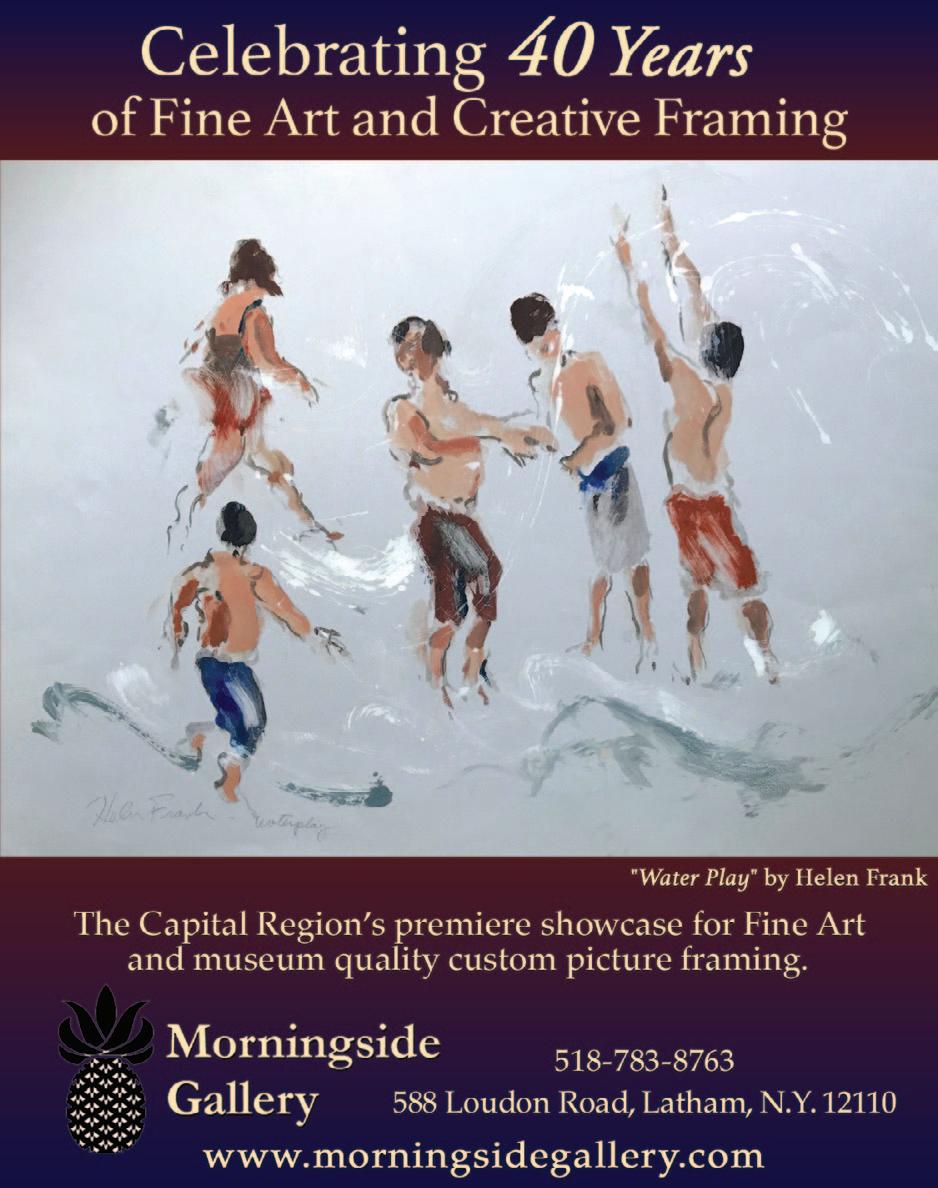
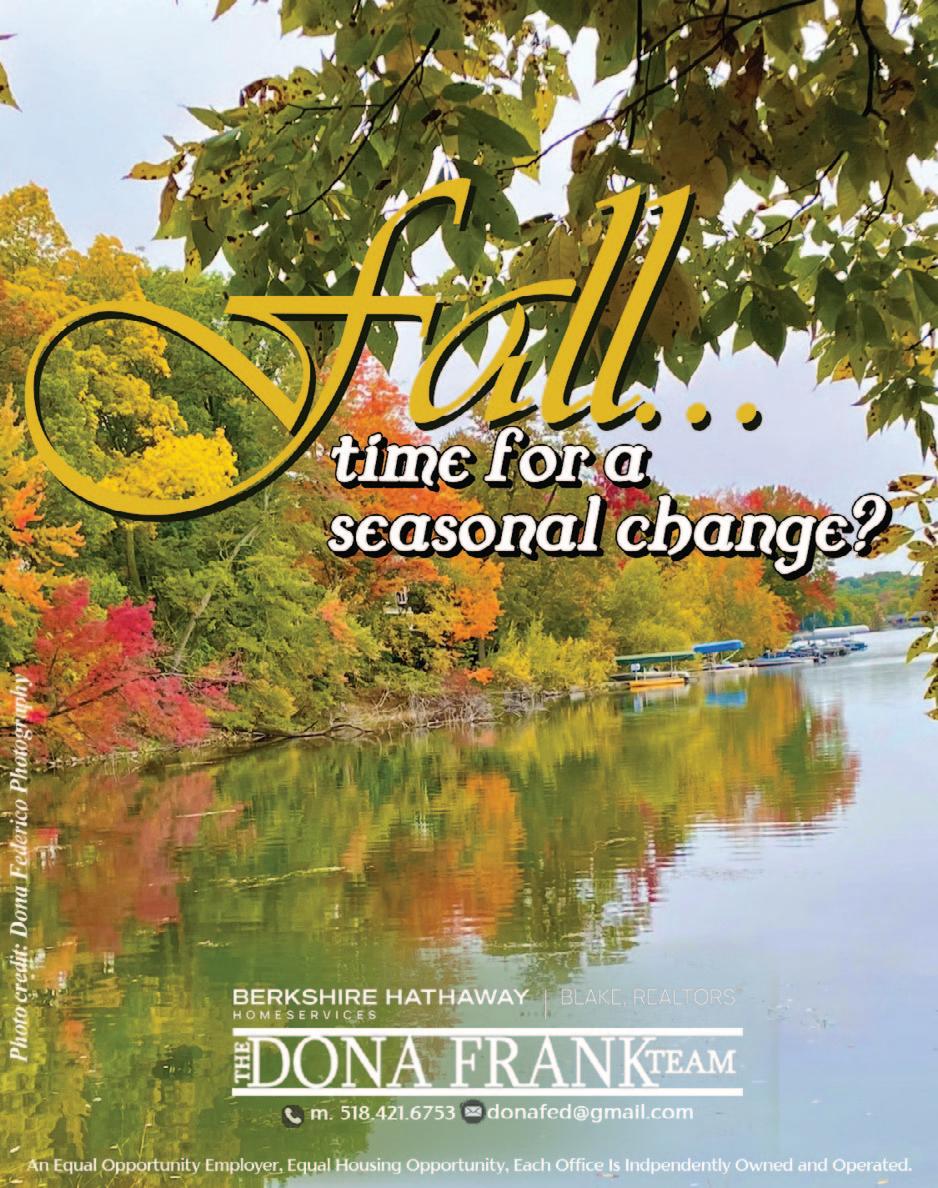
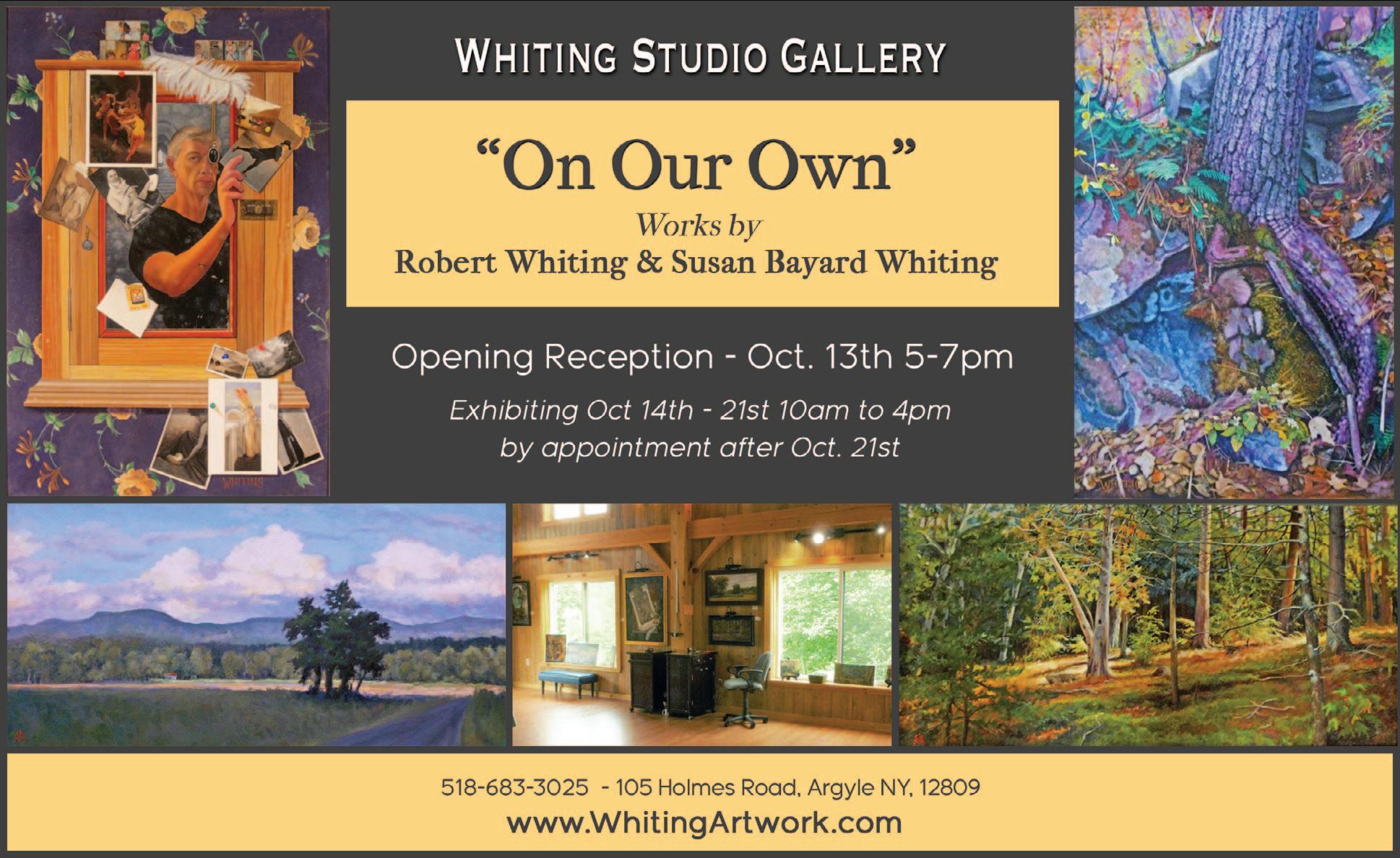


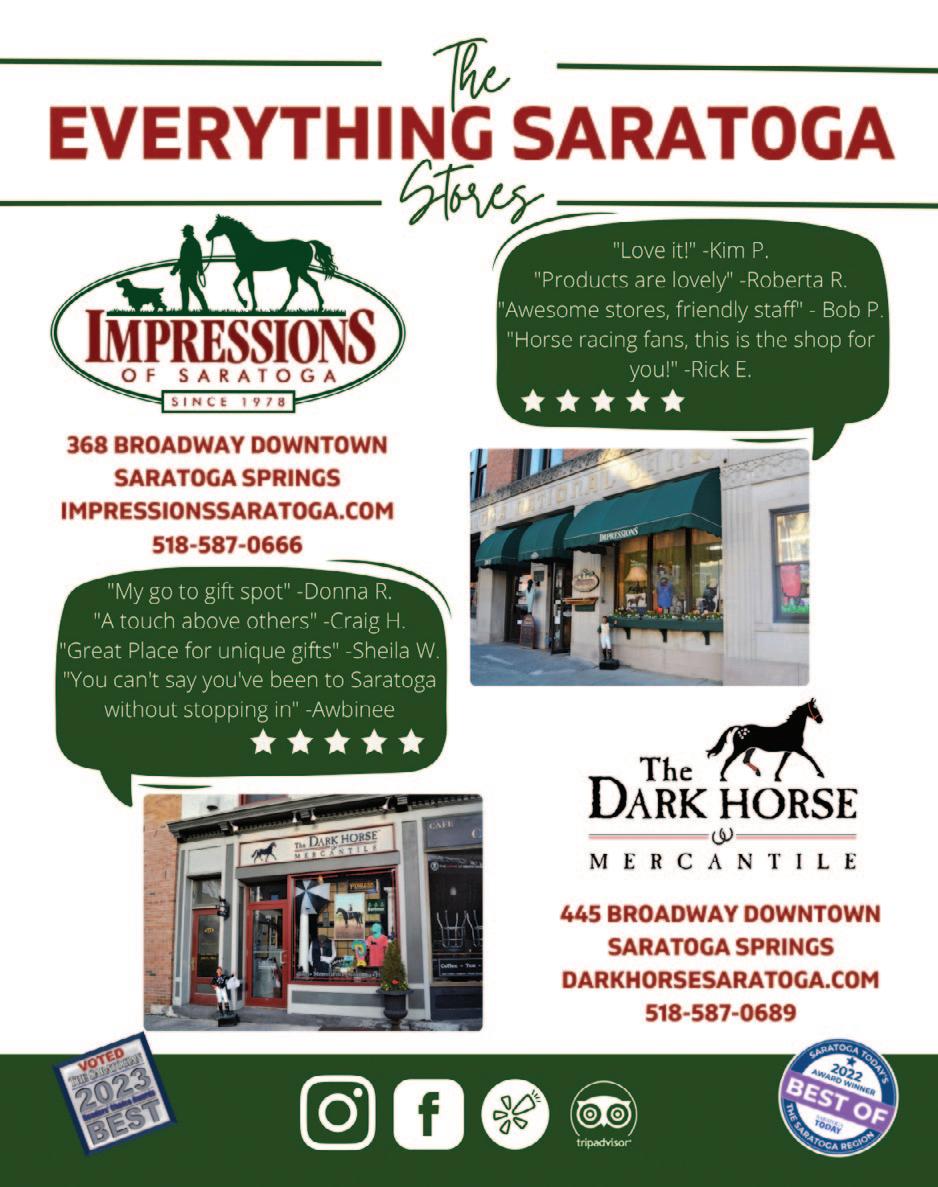 Winslow Homer, The Pumpkin Patch (Husking), 1878
Winslow Homer, The Pumpkin Patch (Husking), 1878
Does a mountain have a spirit? Is there magic in the woods? Do the waters speak? Are the winds guiding us? Does nature heal? According to local history and Saratoga folklore, the answer is yes.
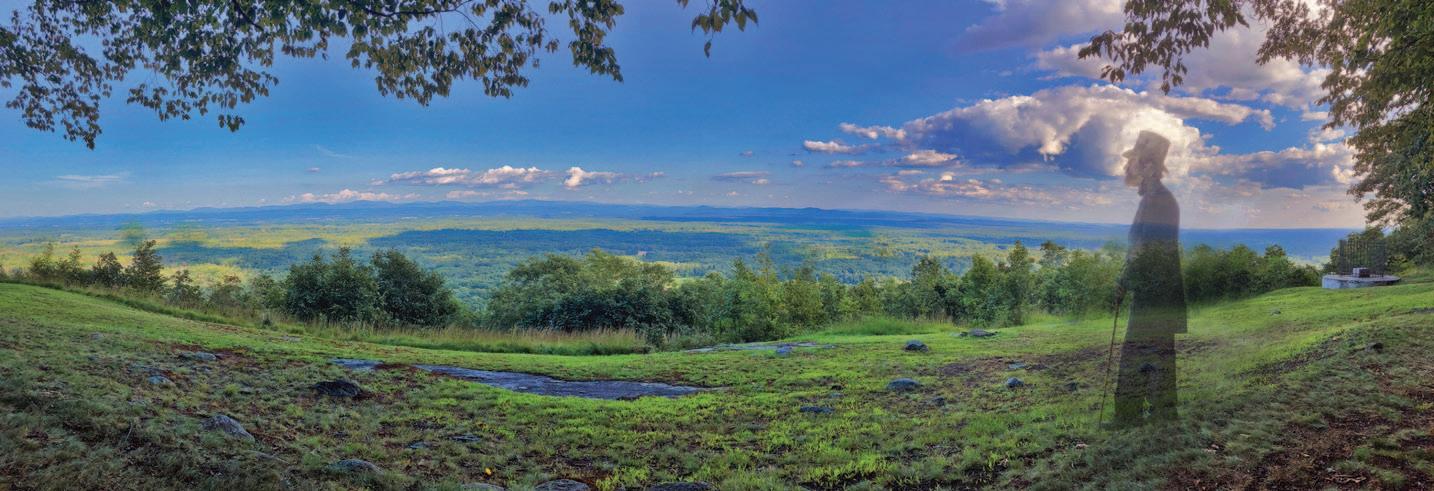
Ghost stories may or may not be true. That is up to the imagination. On the other hand, the essence of greatness, triumph, tragedy, and healing that the people who have made the history of Mount McGregor are very much real and tangible. Anyone who has visited the overlook on Mount McGregor can attest to experiencing this sense of a generous healing spirit.
The distinctive profile of Mount McGregor was formed by glacial advances and receding as part of the Adirondacks. The mountain’s acreage overlaps the towns of Wilton, Moreau, and Corinth and creates a dominant presence in all three. It is one of the main peaks in the
Palmertown Range extending all the way to Lake Champlain, near Ticonderoga.
The area was frequented by Native Americans of various nations and tribes who found ample game in the countryside, fish in the many streams, and safe passage on the Hudson River.
Although there is no record of their visits to the summit of the mountain, the vista surely cap tured their imaginations as it has everyone who has visited since.
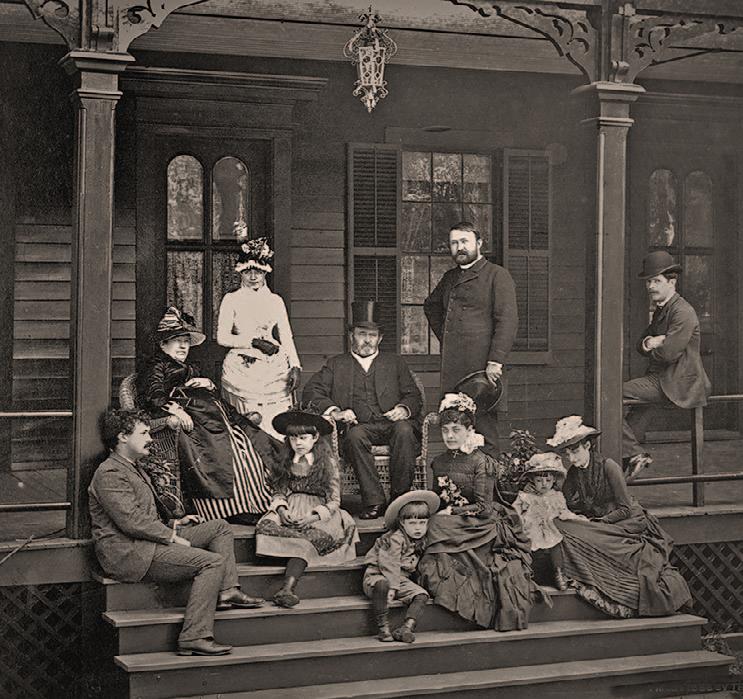
The mountain was originally referred to as Palmertown Mountain. In the mid-1800s, Duncan
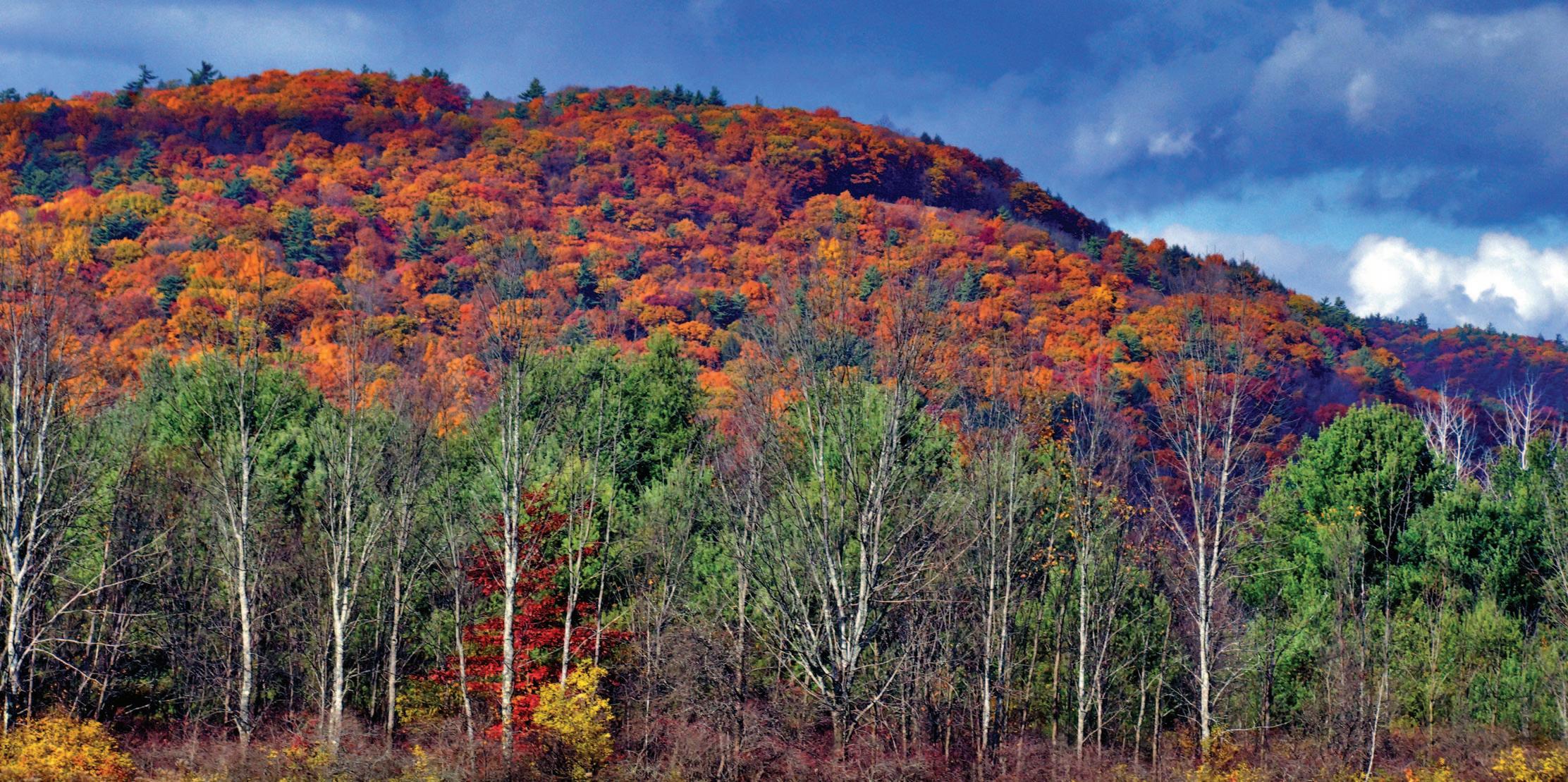
“We are now in the mountains, and they are in us, kindling enthusiasm, making every nerve quiver, filling every pore and cell of us.”
...John MuirGrant and Family Mount McGregor
McGregor, the son of Scottish immigrants, lived in a home at the base of the mountain. He be came a successful businessman and soon purchased the deed to the mountain, giving it his family name.
One of the first structures on the mountain contained an art gallery. One exhibition on the mountain featured McGregor’s sister, Caroline’s unique moss sculptures. Caroline’s was the first recorded death on the mountain, and some claim, that her spirit can be seen in the wooded areas of the terrain, where moss would be growing.

McGregor opened roads up to the mountain summit so that that local residents and large
parties could take advantage of its natural wonders including the magnificent meadows with spectacular views. McGregor received na tional acclaim for his vision to create a mountain resort. One correspondent described the views as “the grandest and most surprisingly beautiful pictures to be seen on earth. Visitors surely will be haunted by that lofty and purifying love of the grandly beautiful.”
Mt. McGregor had developed as a resort after a road and a small hotel (now Grant Cottage) were built by Duncan McGregor in the 1870s. Families would travel from great distances to stay in sturdy tent clusters with magnificent views.

A group of investors recognized the site’s potential, and in 1882, built a railroad line here from Saratoga Springs. Two years later, the luxurious Hotel Balmoral opened to guests ad vertising “No Dew, No Malaria, No Mosquitoes, Certain Relief from Hay Fever.” Saratoga Springs was renowned for its healing waters, but Mount McGregor was also becoming well known its healthy environment.
"The atmosphere here enables me to live in comparative comfort while I am being treated or while nature is taking its course with my disease. I have no idea that I should have been able to come here now if I had remained in the City.”
Signed, U.S. Grant, dated June 30th / 85
In the summer of 1885, while trying to complete his memoirs, Ulysses S. Grant was dying of throat cancer. His doctors recommended Grant leave the urban environment of New York City. Joseph W. Drexel offered the Grants use of his cottage on Mount McGregor. They gladly accepted.
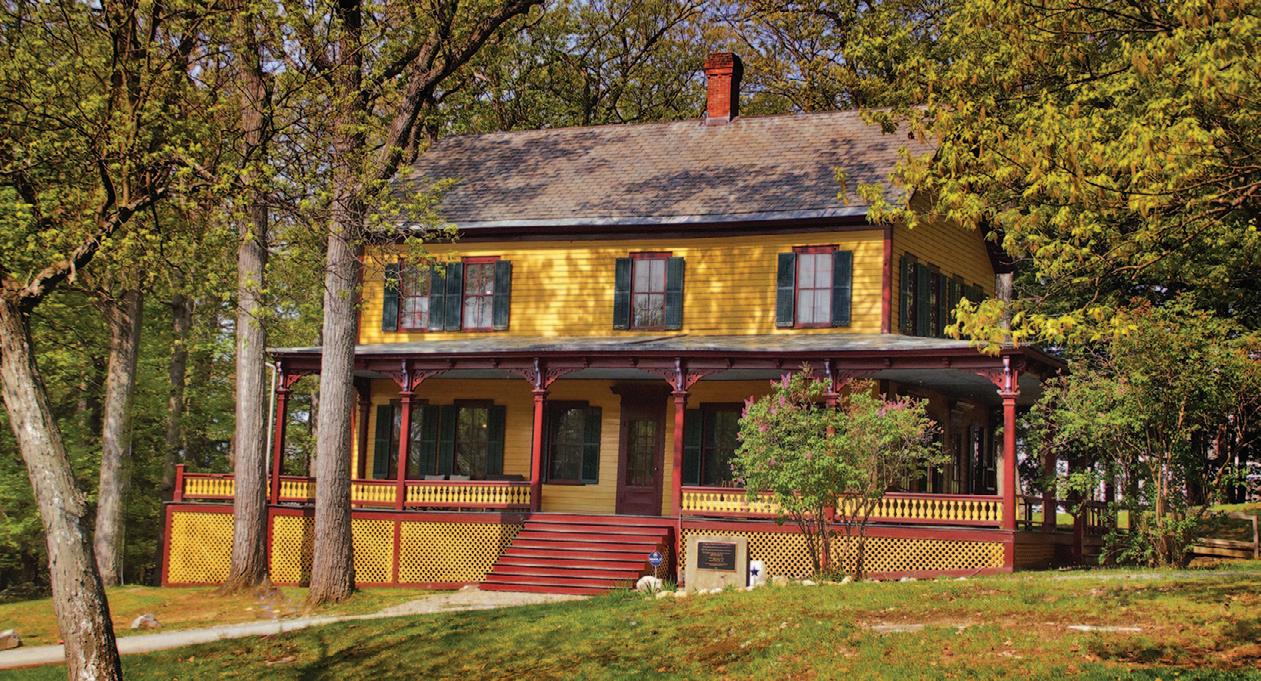
As many as seven trains a day traveled to and from the mountain. The Balmoral provided accommodations for Grant’s
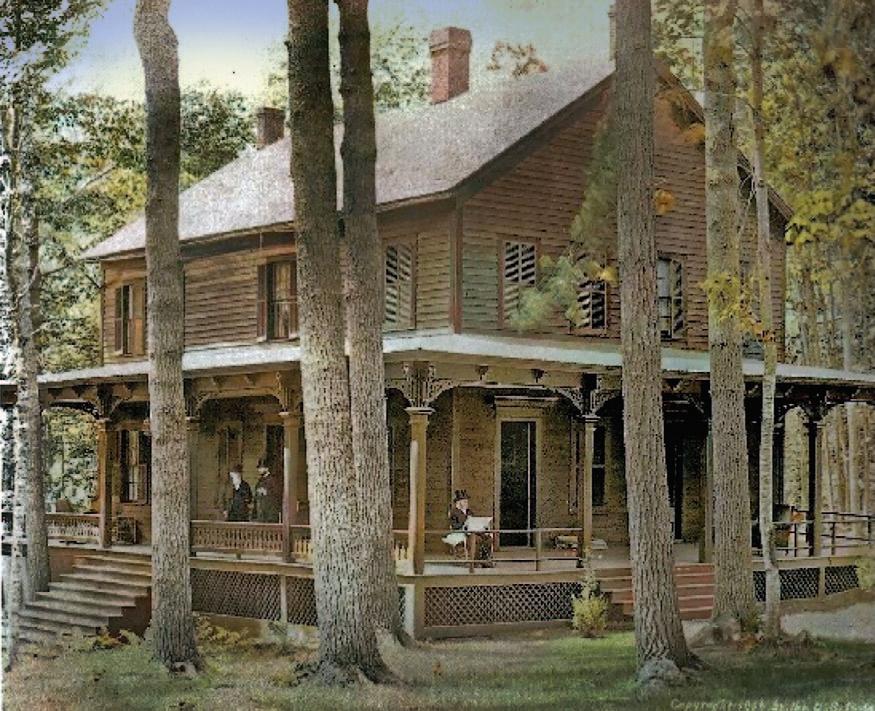 Grant Cottage with Friends
Grant Cottage today
Grant Cottage with Friends
Grant Cottage today
friends and visitors, and for the reporters who kept a constant vigil. Sadly, the hotel burned in 1897, and the railroad was dismantled in 1899.
Grant started writing his memoirs long before living in the Cottage. Samuel Clemens (Mark Twain) agreed to publish the book through his firm, Charles L. Webster & Co. It was hoped that public demand for the book would ensure financial security for Grant’s wife, Julia and the rest of his family. Grant died on July 23, 1885 knowing the memoir he completed days earlier guaranteed secu rity for his family.


In 1913, Metropolitan Life Insurance Company bought the top of the mountain (minus Grant cot tage) and built a large and spacious sanatorium for employees who had been swept up in the tuber culosis epidemic. The tuberculosis sanatorium had a capacity of 350 people with patients remaining for months or years. The grounds were exquisitely landscaped, and those who stayed during that time had the very best of care.
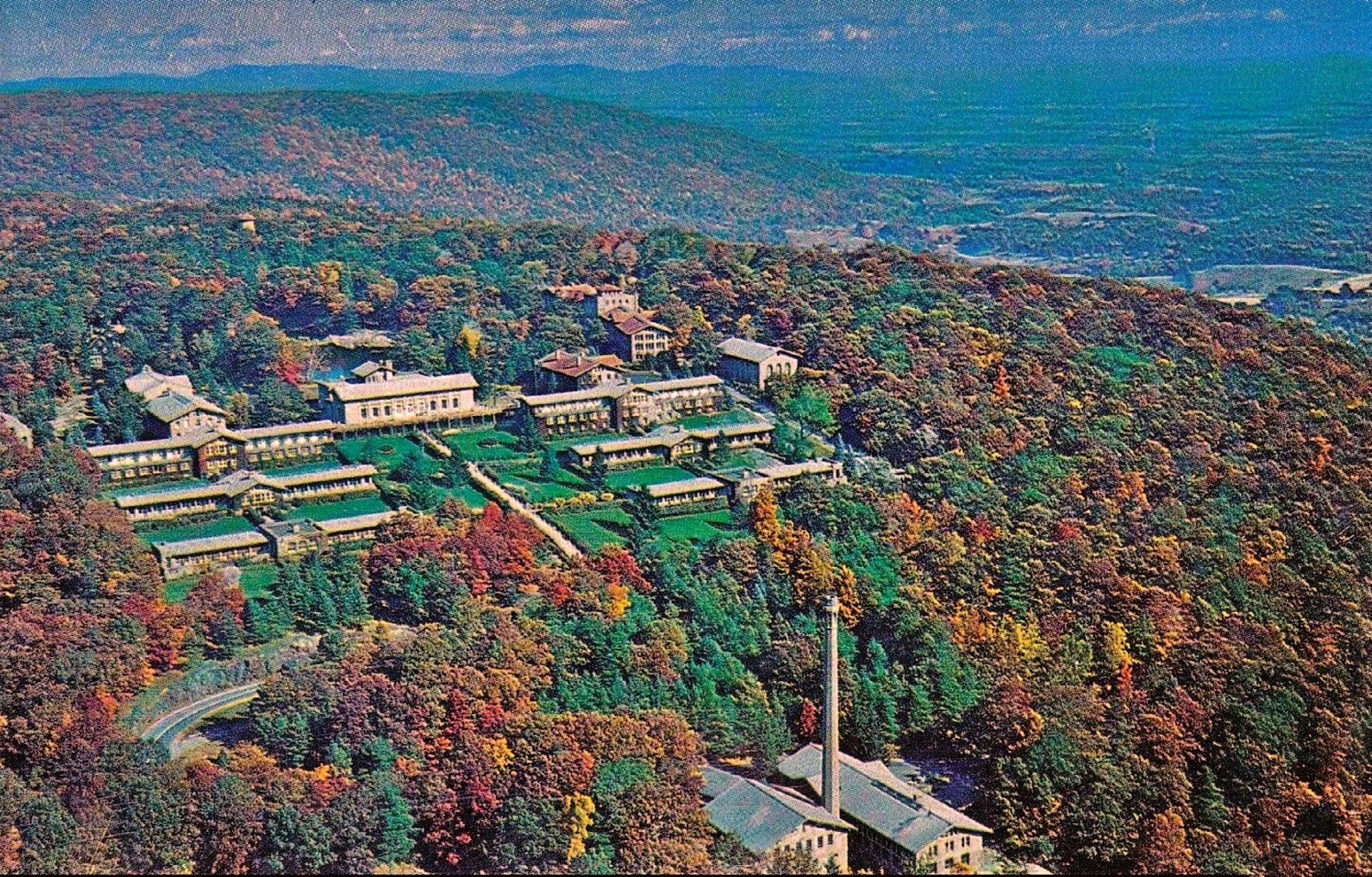
In 1945, the state took control and turned the facility into a retreat for returning World War II and other veterans. In the early 1960s, the site became a facility for the developmentally disabled before being
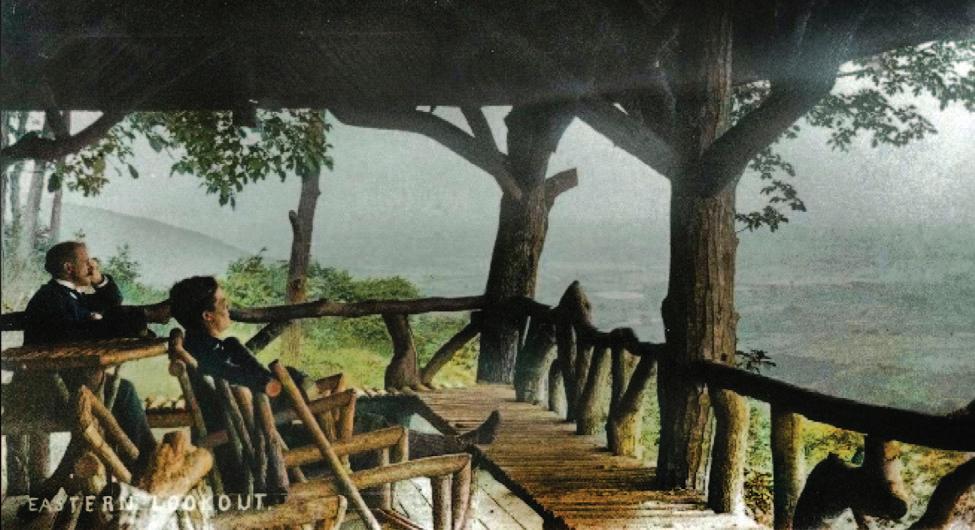
c onverted to a minimum - security prison that opened in 1976. The facility then became a medium-security prison in 1986.

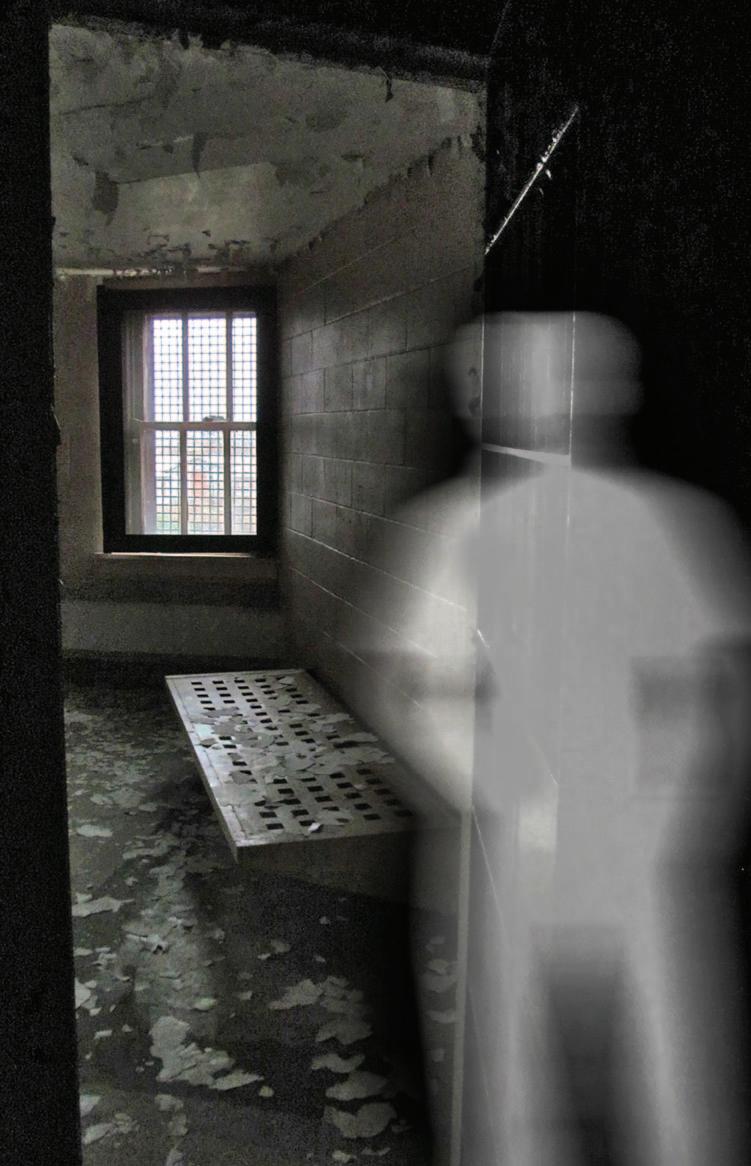
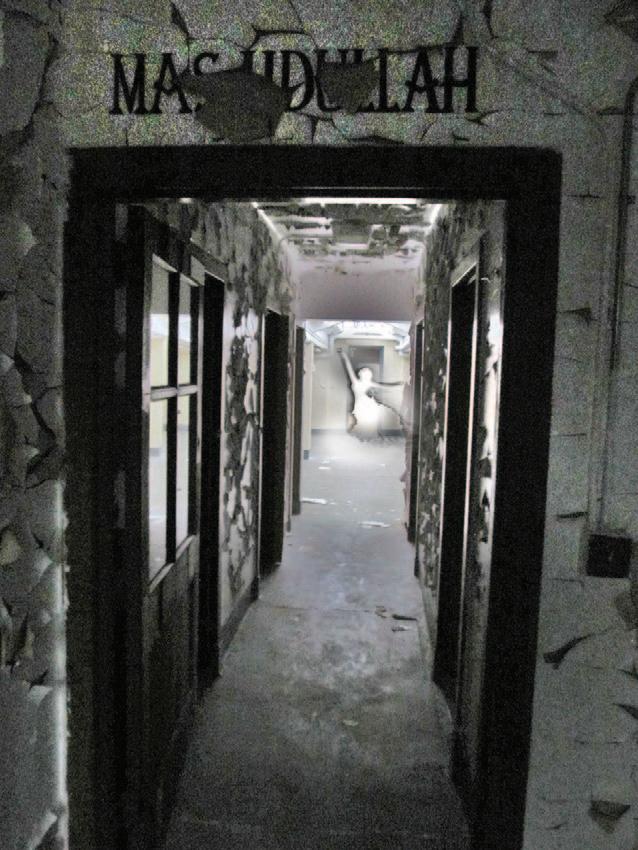

"I came near to going away without knowing about the view from that lookout. I would not have missed it for anything; for, in connection with its historical associations, I consider that it presents the grandest scenery that I know of in America."
...Mark TwainI ask Grant Cottage Operations Manager, Ben Kemp about his impression of the spirit of the mountain and he relates, “Yes, there are some stories from the old prison guards of sightings in the buildings including the figure of a young girl in a Sanatorium building. Some of the past security people have related seeing unusual movement and shadows in the old buildings. The ceiling of the cottage porch was painted a mystical color blue, called Haint Blue to keep away evil
spir its. Some say they have seen Grant’s shadow on the overlook at dusk, but I have not and that is not what people come here for.”

Ben continues, “The great attraction for the early American Natives and first settlers to Mount McGregor was the essence of nature and the beautiful environment. That continues

today. The first word I hear out of everyone’s mouth when they first stand on the overlook is, ‘WOW!’

“It has always been a restorative place whether for a local who came for the natural serenity, or a person suffering from a life-threatening ailment, a war veteran, or a prisoner who experienced significant re habilitation by being housed here for a period of time. Even for Victorian resort guests, it was always about healing. In fact, some of the people who were imprisoned here still come back because the experience was so profound for them. That is an excellent example of how much effect the mountain can have on a person.”
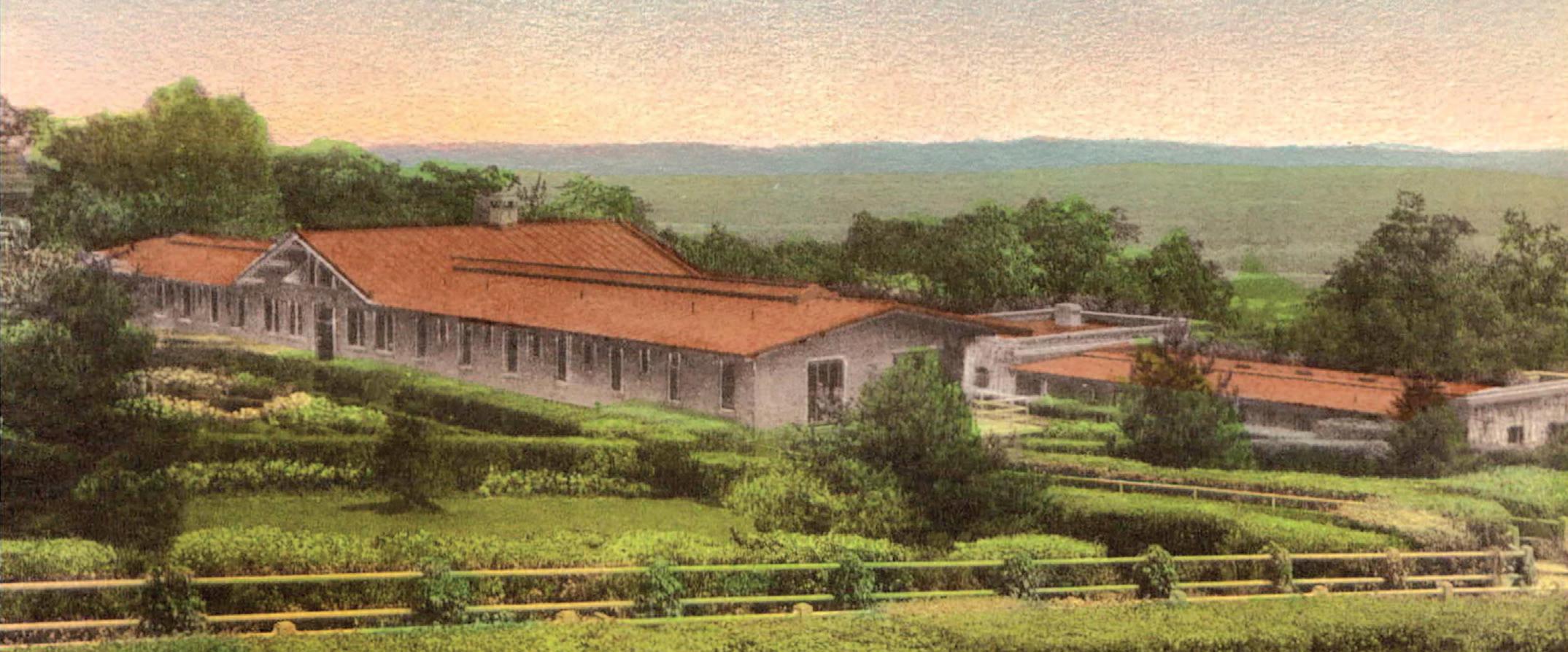
“Since the property backs right up to the Palmertown Range network of hundreds of miles of trails with easy access to two lakes, it is perfect for multi-use, outdoor, family-friendly, all-season activities and
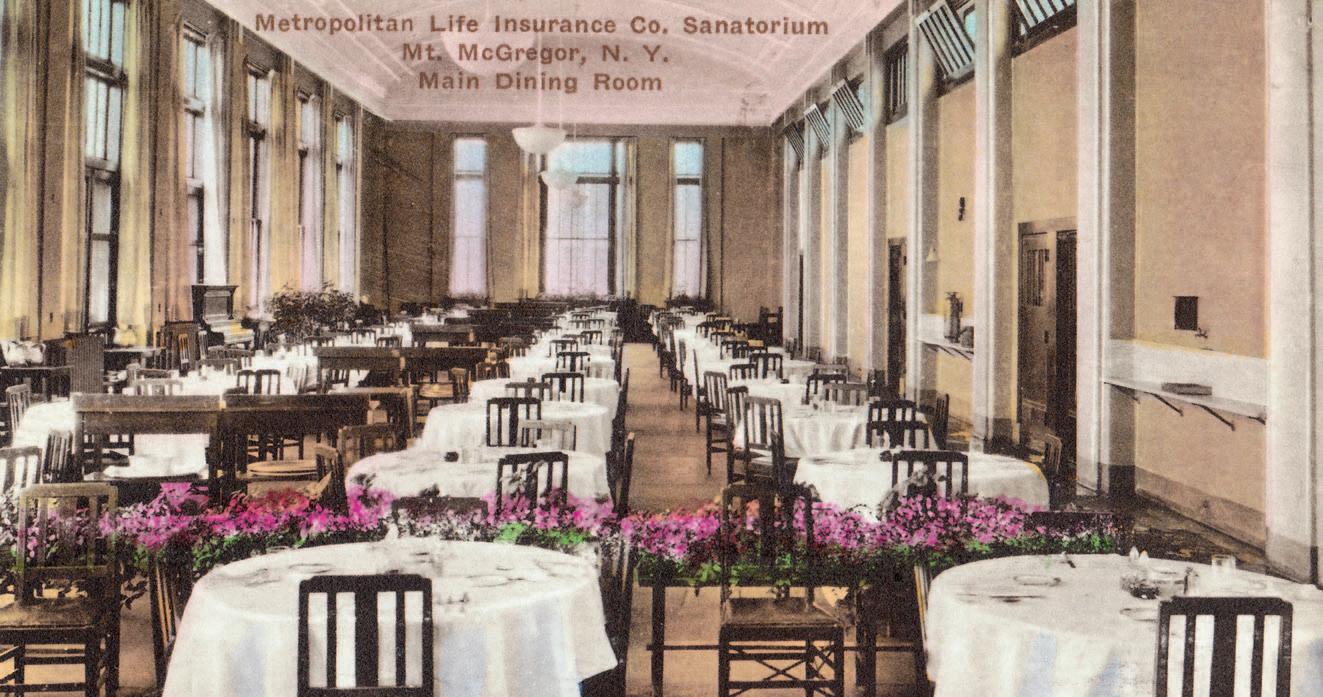
hopefully that will be the planning for the future.”
Ben reflectively continues, “Grant and Clemens experienced that sense of healing during their time here. Grant was suffering horribly from this cancer. Clemens came to the cottage and notified Grant of the great success of his book and to inspire his spirit. Both men ben efitted by their time here as did American history. Grant’s writings are considered perhaps the strongest example of personal military memoirs ever written.”

As Ben and I ended our conversation an out-of-state family, (mother, fa ther, two kids) comes out of the cottage and sits on the wicker furniture on the wraparound porch.
I asked if they visited the overlook, and they said no. I strongly advise they do so, and I notice that they walk in that direction as they leave.
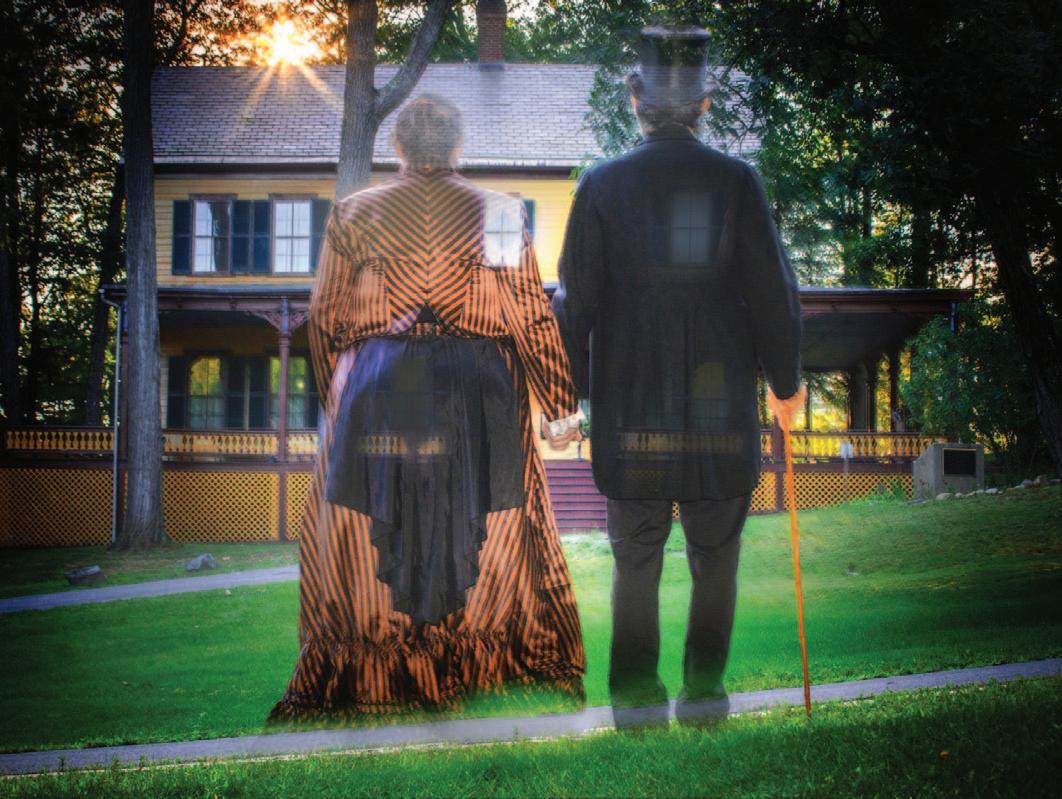
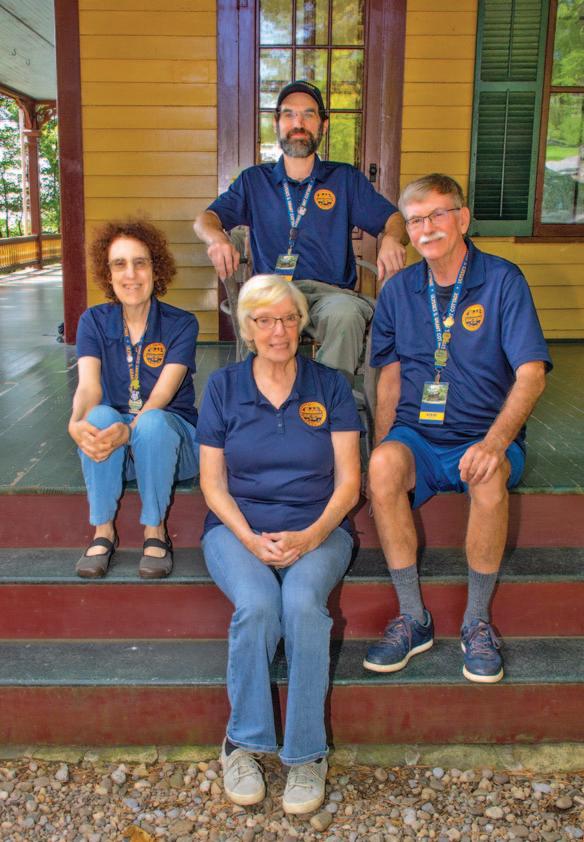
About an hour later as I drive my car down the mountain, I see the family walking back out of the woods on the overlook path. Slowing my car, I shout out, “How was it?”
With a thumbs-up, the father shouts back, “Awesome!” As the kids happily skip on the path, the mother shouts, “We get it now! The mountain is magic! Thank you for telling us.”
I think to myself, “Yes, and now I must tell others.”
Grant Cottage
www.grantcottage.org
Saratoga Plan – Palmertown Range saratogaplan.org/explore-parks-and-trails/palmerton-range/



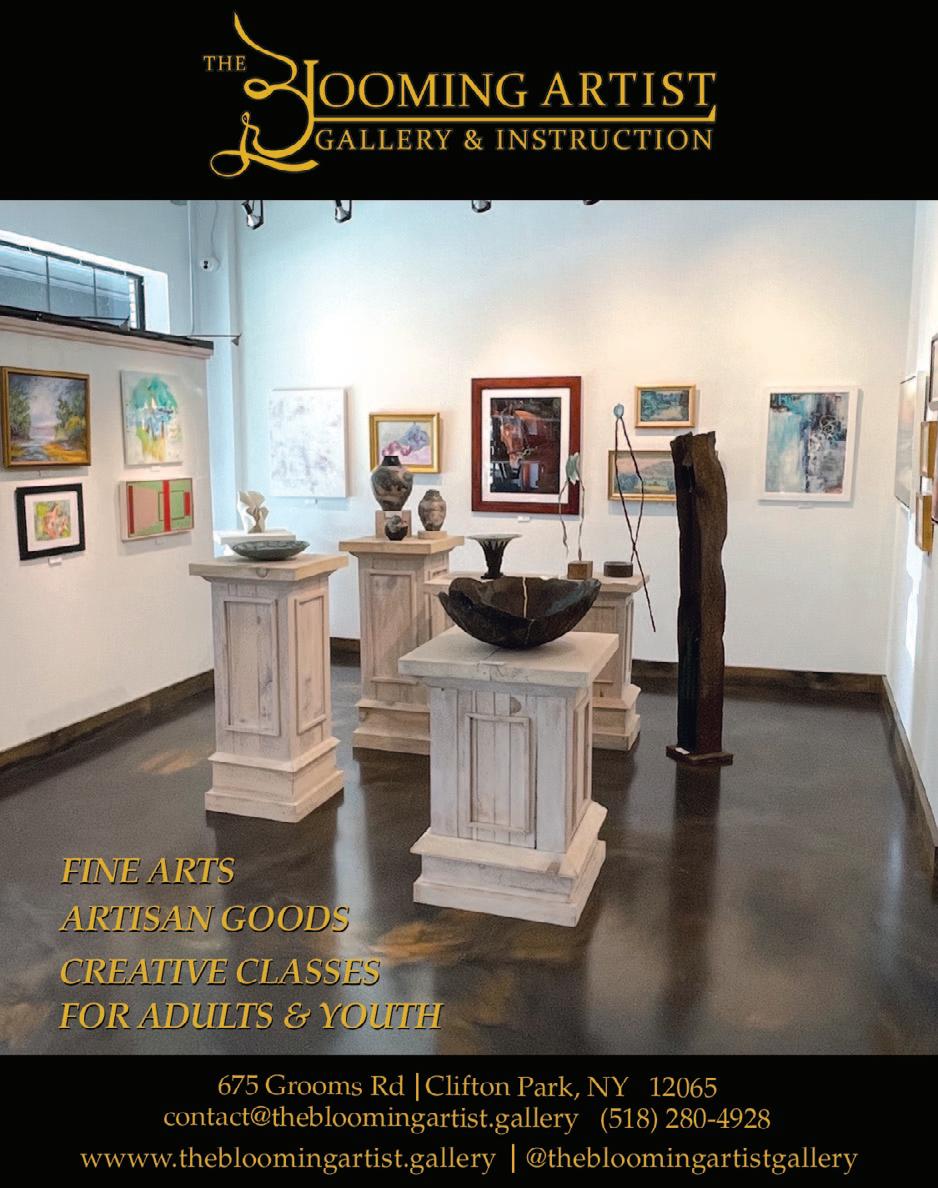
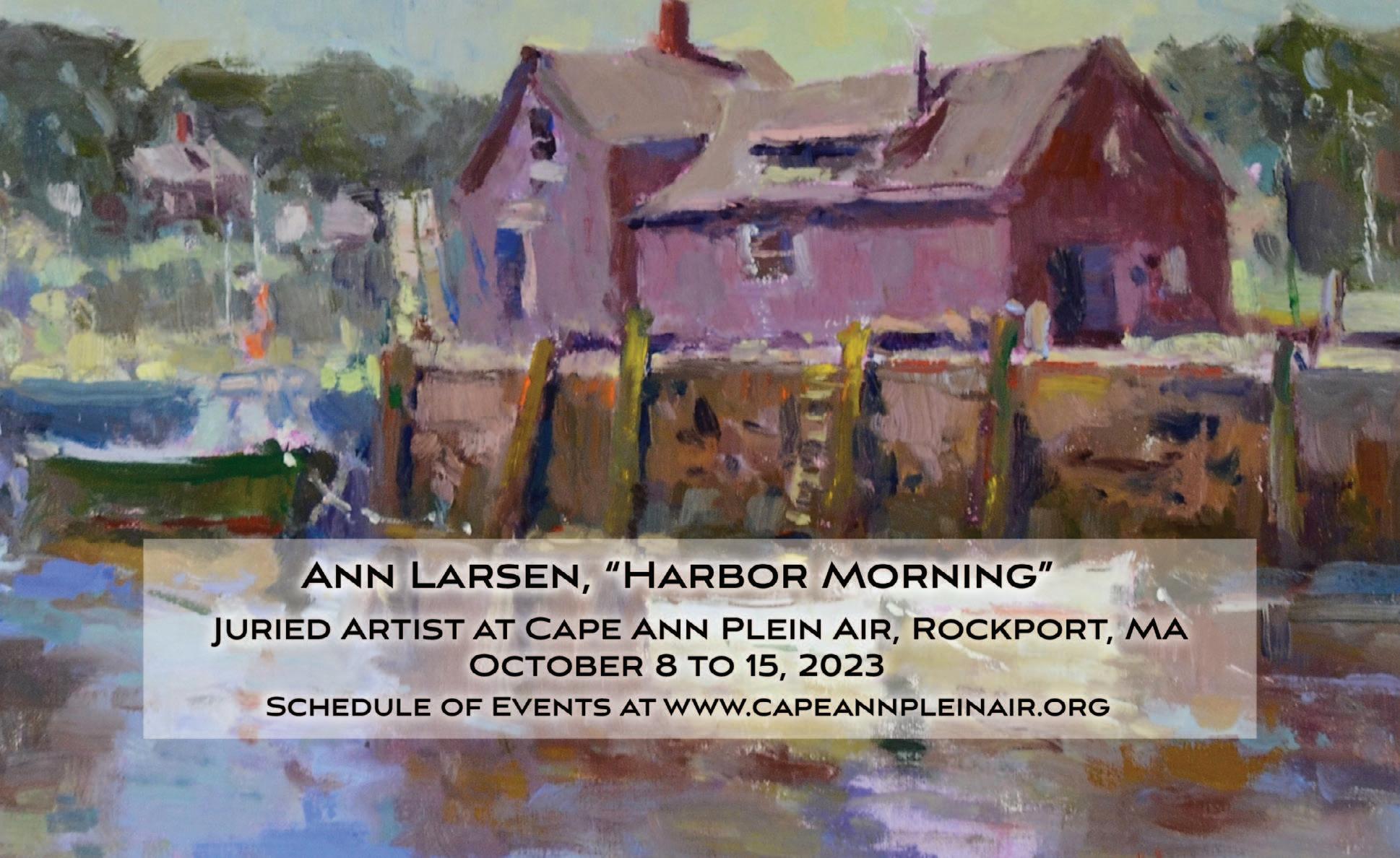


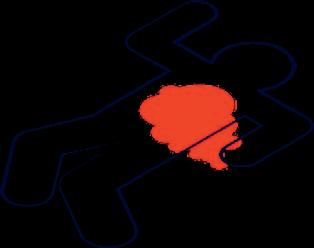
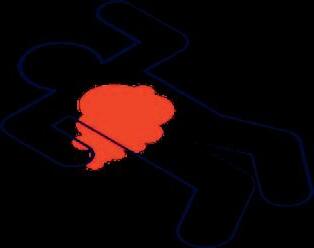


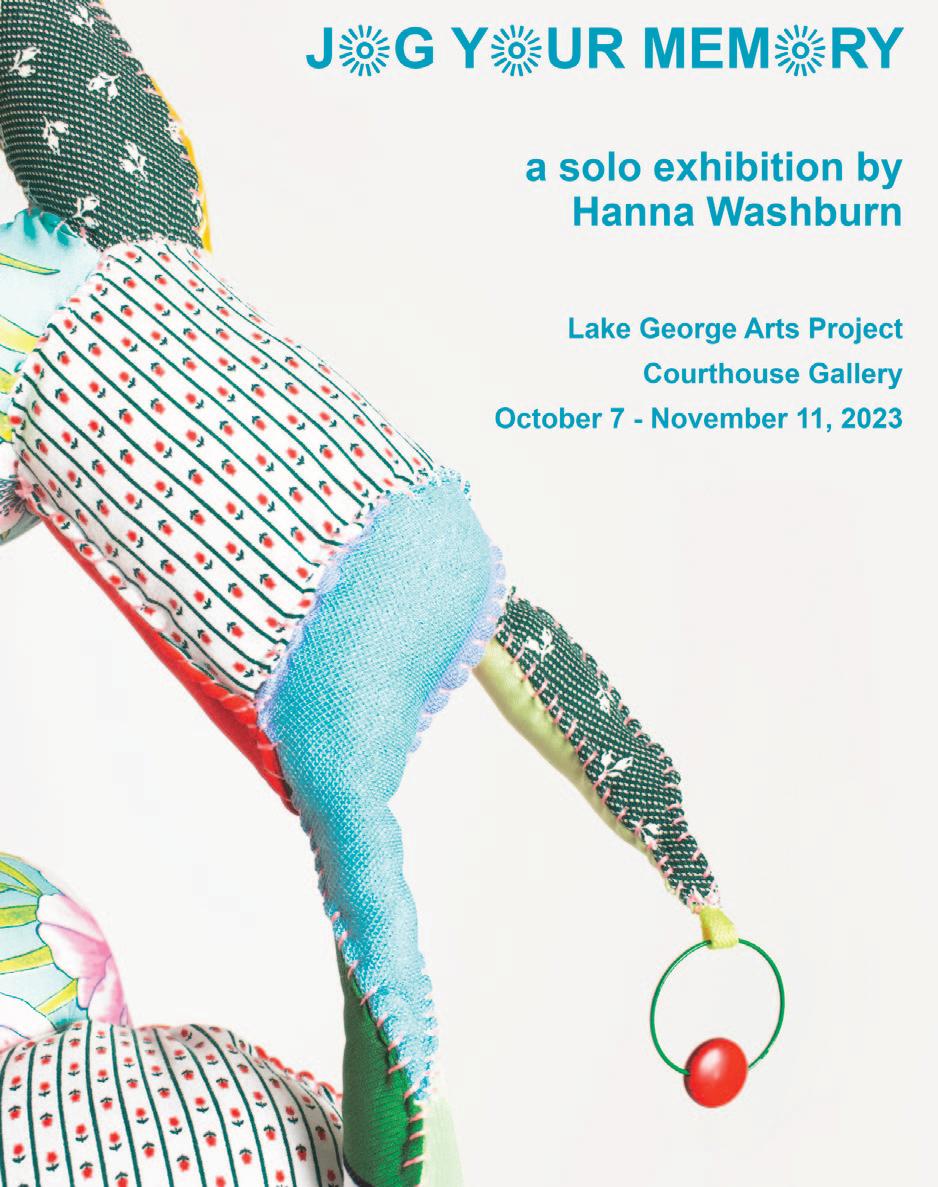


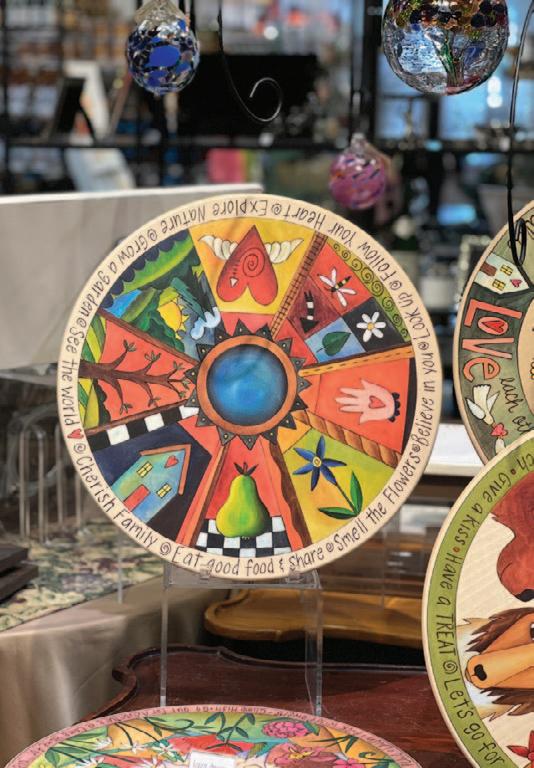
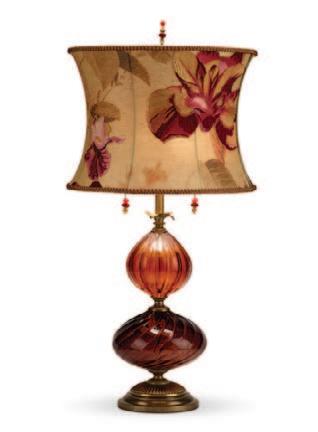

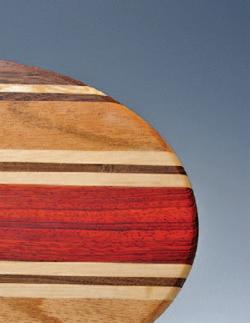
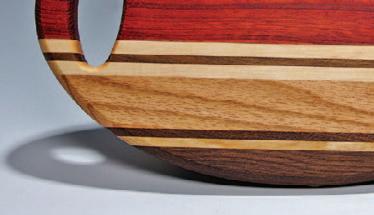


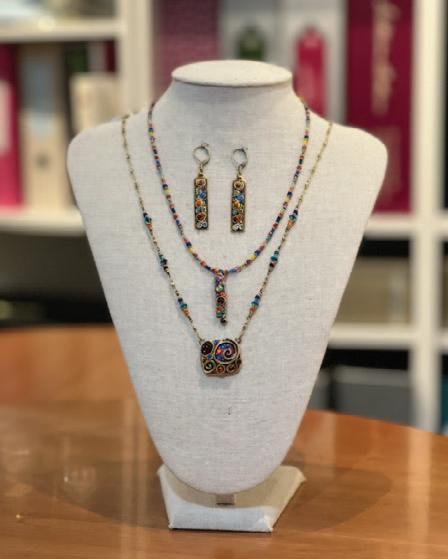
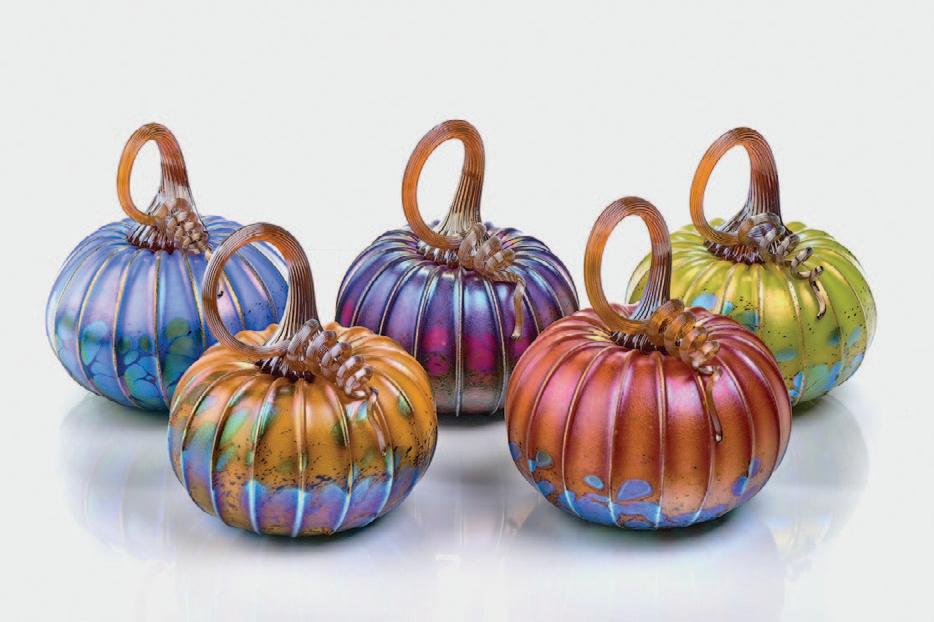



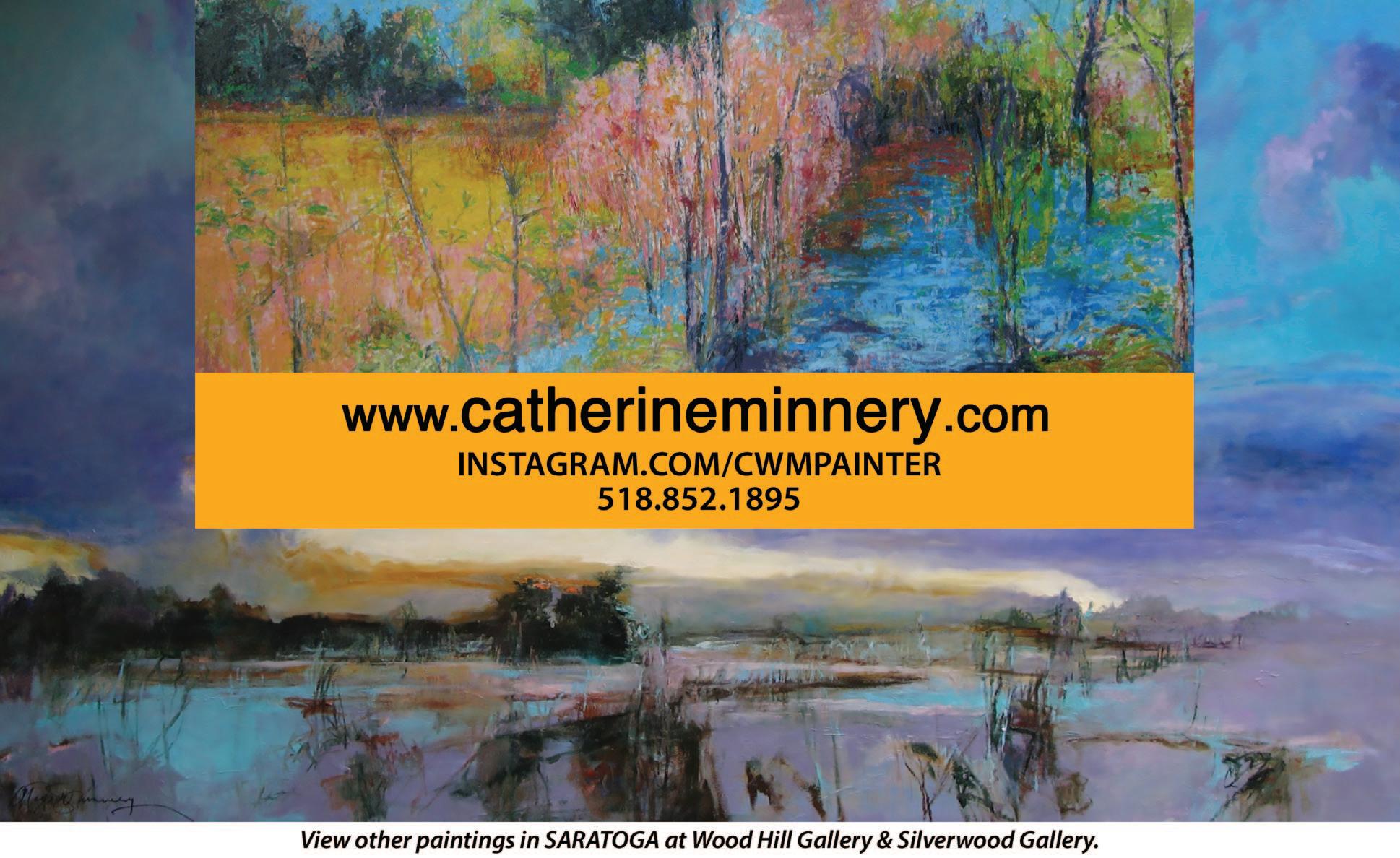

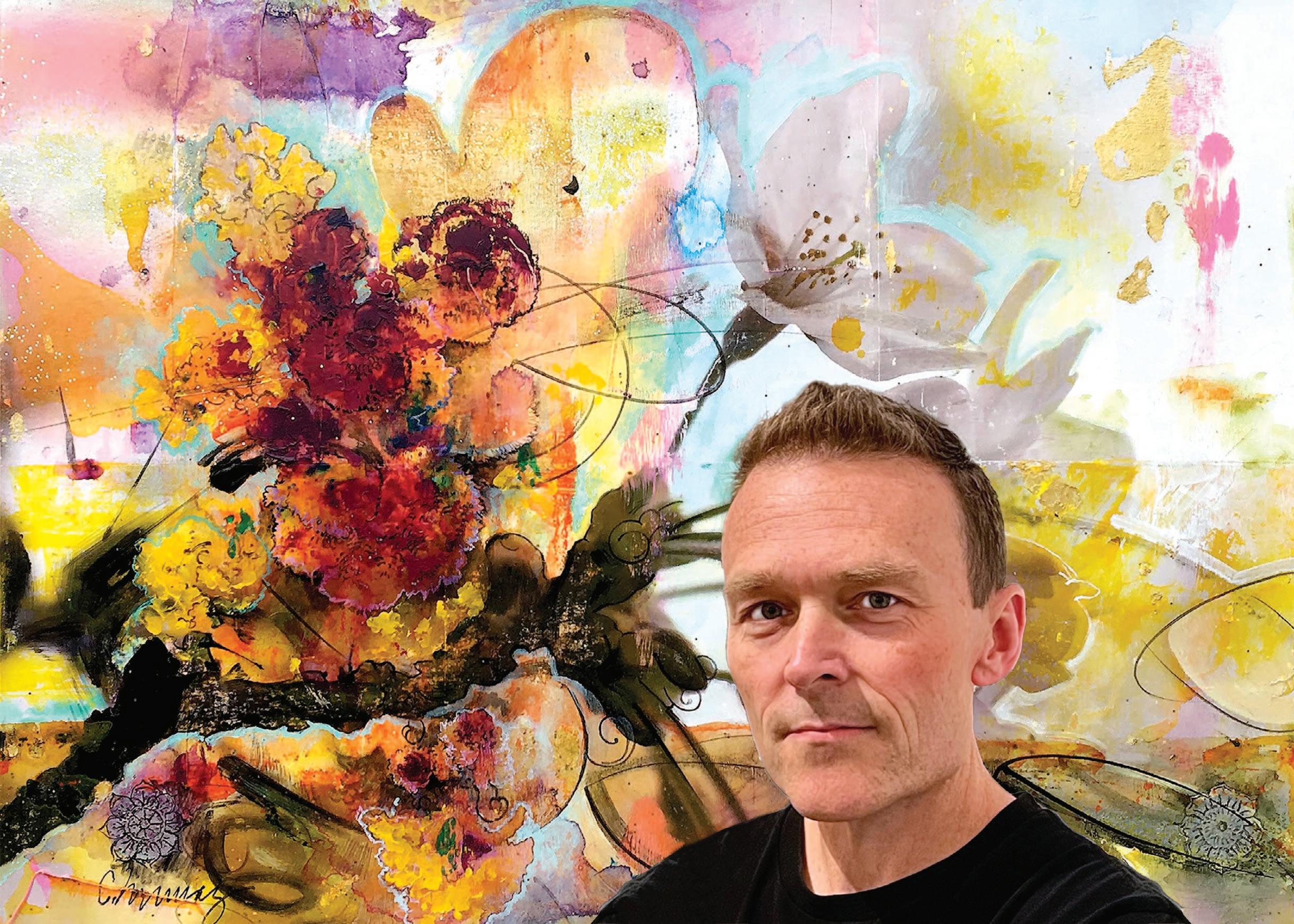 By Alan B. Richer
By Alan B. Richer
Christopher Murray, the oldest of five children, was raised in the Pleasantdale section of North Troy in a home environment perfect for developing a future artist. His parents actively took their children to museums, ballet at SPAC, and other cultural performances. There is a photo of Christopher as a young toddler in his stroller laughing in front of a William-Adolphe Bouguereau painting at the Clark Art Institute in Williamstown, MA.
Both parents encouraged all their children to create. The dining room table was the family’s crafts center. Large poster boards covered the floor in the living room with markers that were used to decorate for birthdays and holidays.
The backyard and their grandfather’s farm were other creativity zones. Murray and his siblings made teepees and forts from scraps of wood and assisted their mom in designing and making flower gardens. They
played with two art drawing toys, Spirograph and Etch-A-Sketch, to make graphic designs.
Other family members influenced the children. Their Aunt Jeanette drew pen and ink and watercolor drawings of famous locations in France, California, and Hawaii that she assembled into books. She had Chinese and other Asian art on the walls of her house that left a lasting impression on her nephew.
Murray’s Uncle Steve did architectural design work for hospitals. He gave Christopher his folding wooden table and supplies such as a T square, triangles, rulers, and an architect’s Leroy lettering set that had etched letters with different writing styles. Murray’s fondest memory was discovering what various tools could do.
In Kindergarten, Murray showed an interest in art. Beginning at the age of seven, his mom and his school both encouraged him to submit drawings for the annual human rights contest in Troy. During the 1980 Winter Olympics in Lake Placid, NY, Murray drew award winners receiving their medals on the podium complete with a banner that lifted off the page.

A summer program in high school at Sage Col lege of Albany exposed Murray to very tal ented fellow students that inspired him to improve his artistic skills. His high school guidance counselor got him a position at the Children’s Museum that was then located in the Lansingburgh section of Troy. There he

worked on murals and installations about ani mal life and Native American culture.
He convinced his parents to buy a computer in high school and started doing computer art. Moving away from handmade art and transi tioning to working with a mouse and a monitor, Murray felt a lack of immediacy with his art. He wanted to touch his art and get his hands dirty. Rather than sitting inside in front of a computer for ten hours a day, Murray wanted to be outdoors to connect with his love of nature.
Murray accepted a full tuition scholarship from the College of St. Rose in Albany for graphic design. During the second semester of his freshman year, he changed his major to art education, the profession of multiple family members.
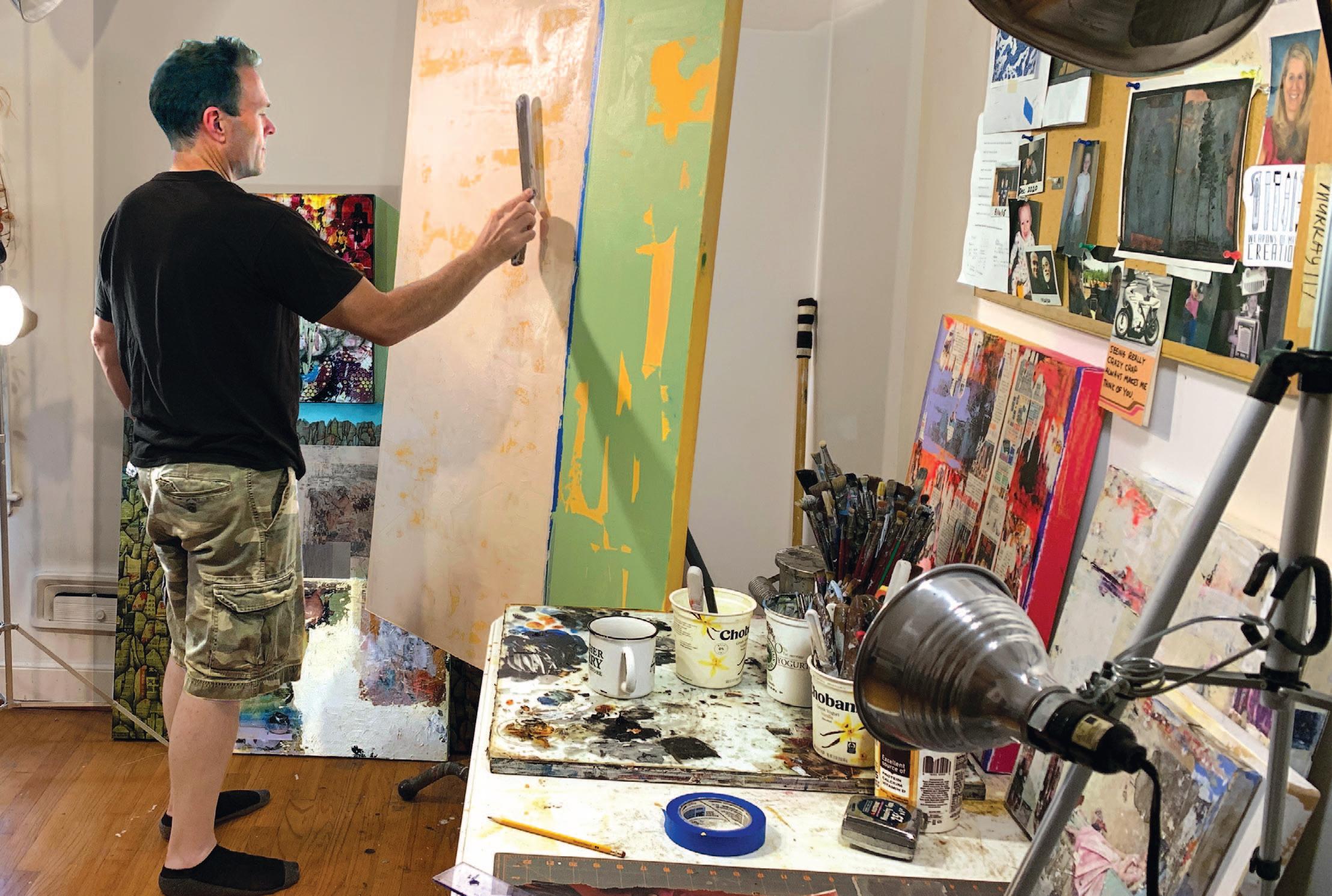
He found a lot of opportunities to develop his teaching method. From his sophomore to senior years, Murray taught at summer pro grams for elementary to high school children. While supplementing his income at a local restaurant, he made connections for
teaching opportunities in both the Cohoes and Lansingburgh School Districts.
To further supplement his income, beginning in high school, Murray chose an entrepreneurial path for his art, designing t-shirts and posters for his friends’ bands, and designing tattoo.
During college, he started doing murals in children’s rooms and bathrooms and developed a talent to do faux finishing to look like marble
or leather. Inspired by his aunt, he began doing house portraits in pen and ink as mementos for people selling their homes. Murray also illustrated children’s’ books.
Just four months after graduating the College of St. Rose in May of 1995, Murray began teaching art to middle and high school students at the Shenendehowa School District in Clifton Park. He initially taught five forty-minute classes a day, starting with the non-advanced classes.
Since the College of St. Rose was the only school in the Capital District that offered night classes which allowed him to continue teaching dur ing the day, Murray returned there to earn his Master’s in Art Ed ucation. It took him two and a half years to earn his degree, doing the requisite studio artwork from 4pm to 11pm.
An educator for twenty-eight years, Murray uses stories to teach his students to be independent and have a vision about wanting to make art. Over time, teaching has changed from teaching traditional sequen tial more complexed levels to less traditional exploratory, ex periential, and experimental processes.
Murray focuses his art on nature and the environment, and his layers represent the connection between parts.

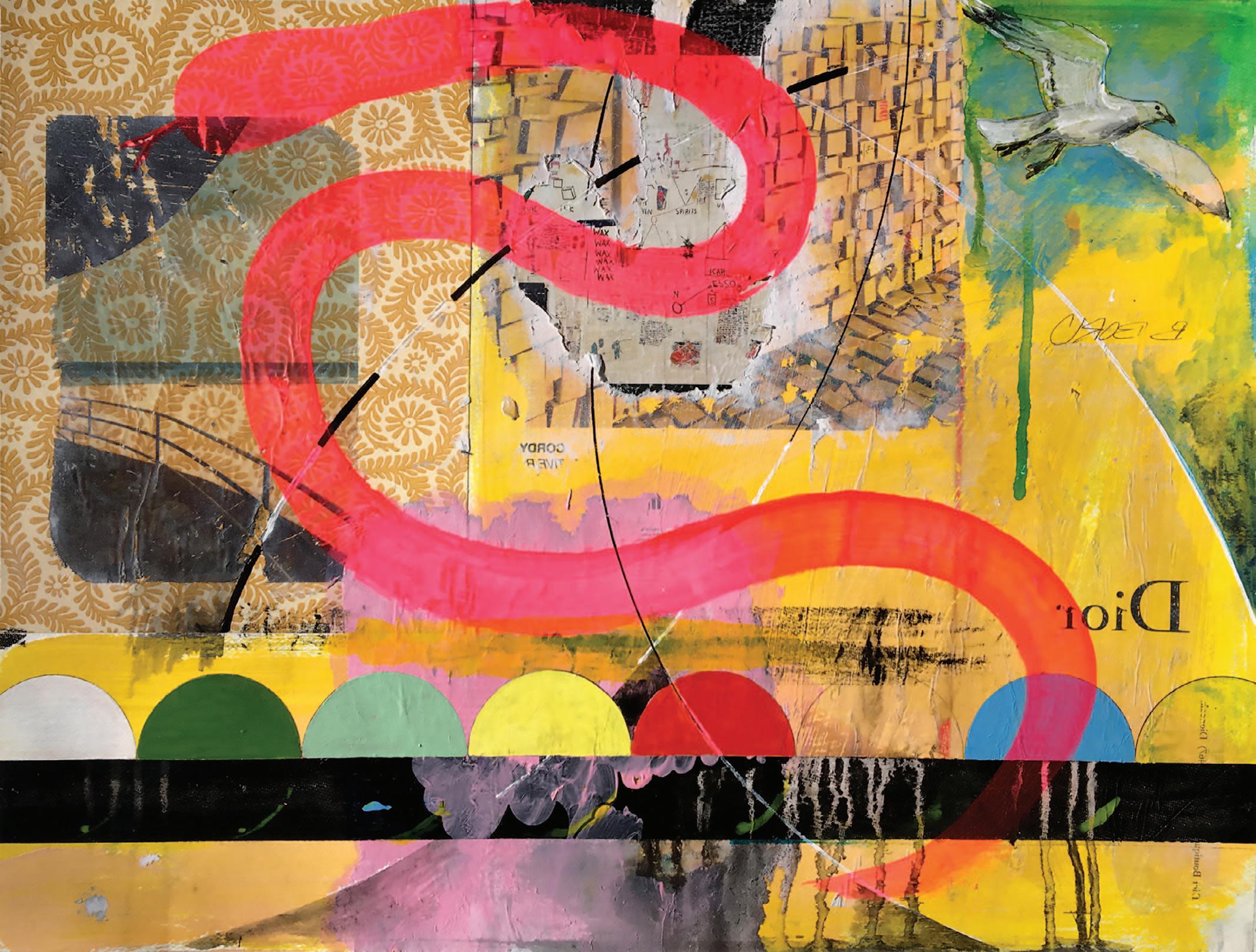
“I get inspired and think about how I can create an artwork that embodies the feeling and beauty of an experience, event, or place. The process of building and digging up layers of paint and collage allows me to imbed all my creative concerns into the canvas. “
Digging reminds him of his childhood when he would dig holes in his backyard for his toy army soldiers or matchbox cars. Scrapping and rebuilding is part of the process of making art.
In most of his artworks, he uses collage to build up layers. Early pieces con sisted mostly of Chinese newspapers scraps due to his appreciation of Asian art. Recent work incorporates the use of his digital photog rap hy, printed and torn into the shapes he needs for his co n structions. Oil paint follows, adding form and color to the developing surface. He compares the process to planting seeds in a garden.
“Sometimes they grow into something beautiful. Other times they produce something to eat. If they have limited sunlight, you need to move them.”
His website includes his longest developed series of Mountain paintings. They are made from collaged paper that is hand torn and assembled to look like rocks. Other materials include photographs of flower pedals, such as brown and pink hydrangea, and aluminum foil. Over the years he has used different designs and different layers of colors.

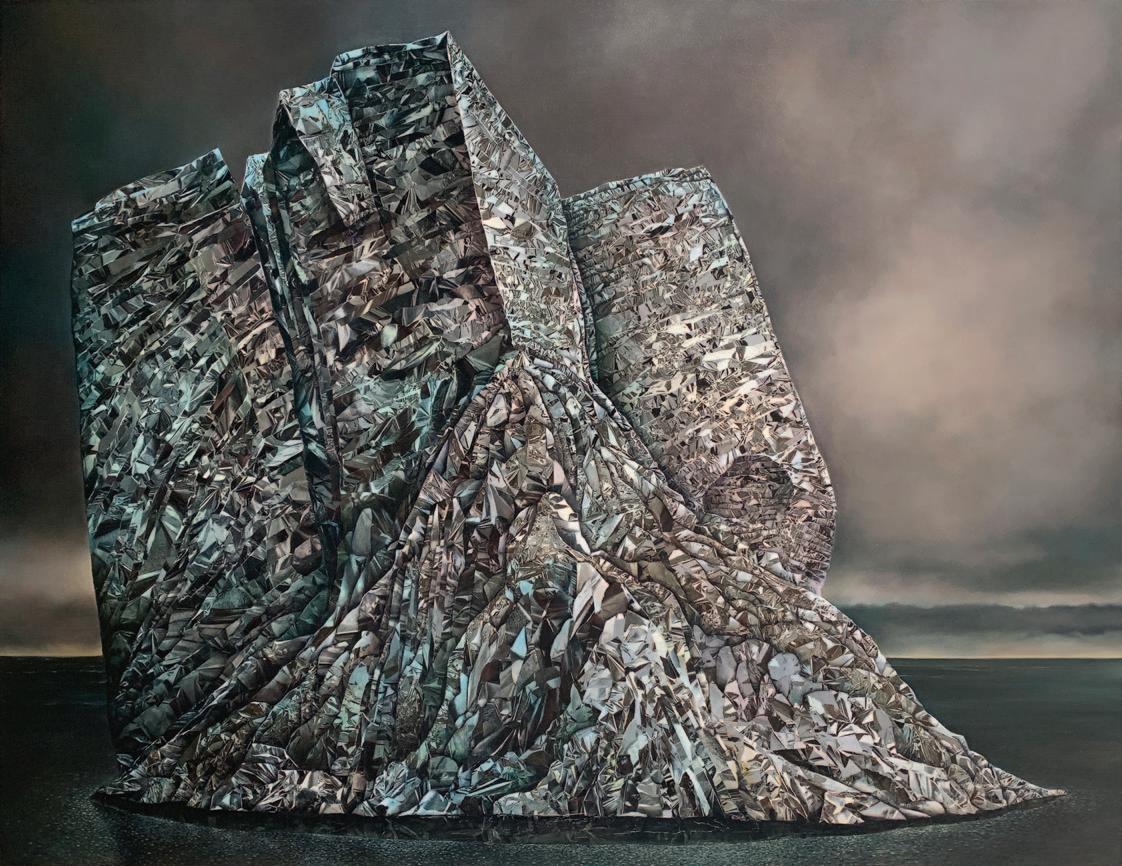
Some of Murray’s paintings are based on places he has been. Others are completely made up. Still others are inspired by musical lyrics, poetry, or even words. Some of his paintings involve sculptural mediums that include painted chunks of wood and decoupage (the art or craft of decorating objects with paper cutouts), and the gluing of material onto surfaces. Others involve integrating a collage with drawings over digital photography. Murray uses different tech niques including pressing, squishing, and rubbing paint on
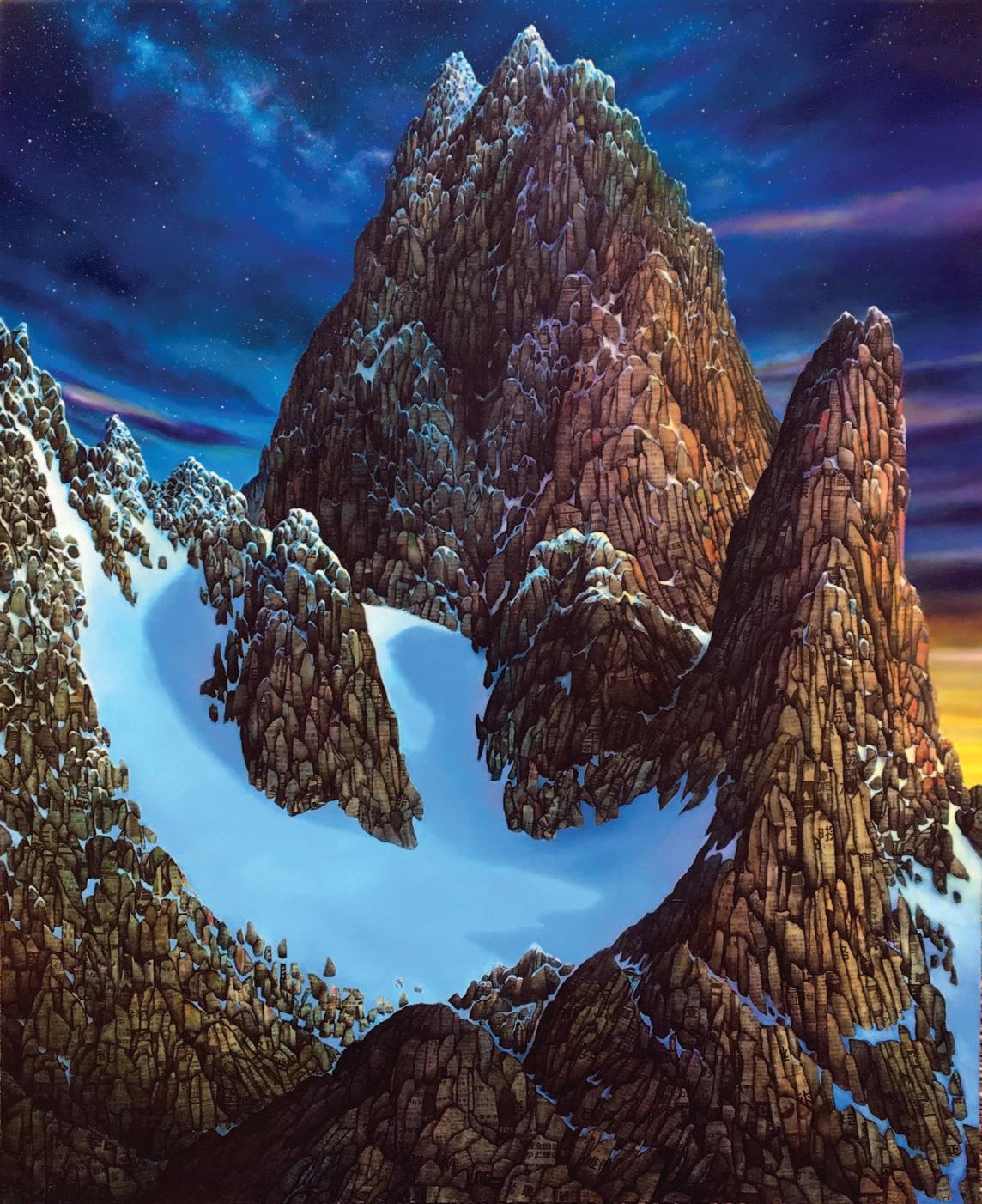
dif ferent works. An interesting painting is Religare based on the root word for religion. It means bringing parts back together. His painting Religare is partly based on Kintsugi, the art of mending broken pottery. This process involves sealing broken parts with precious metal depicted by gold paint. The distinct wood and broken pieces now come together.

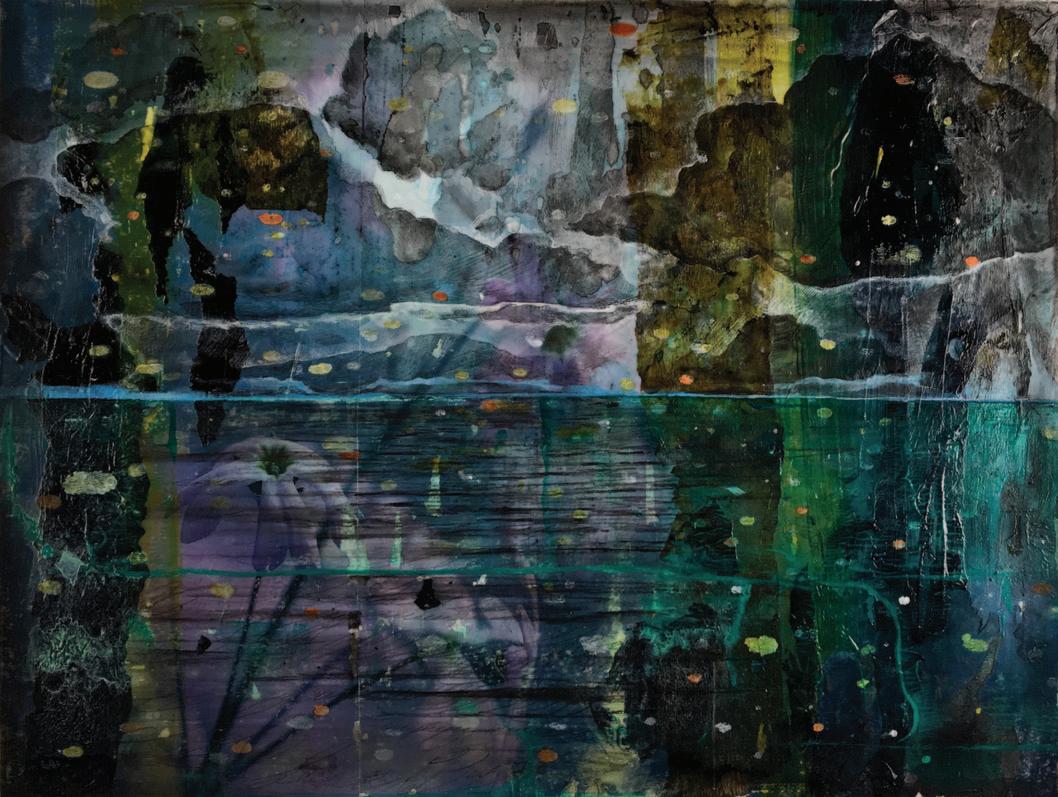
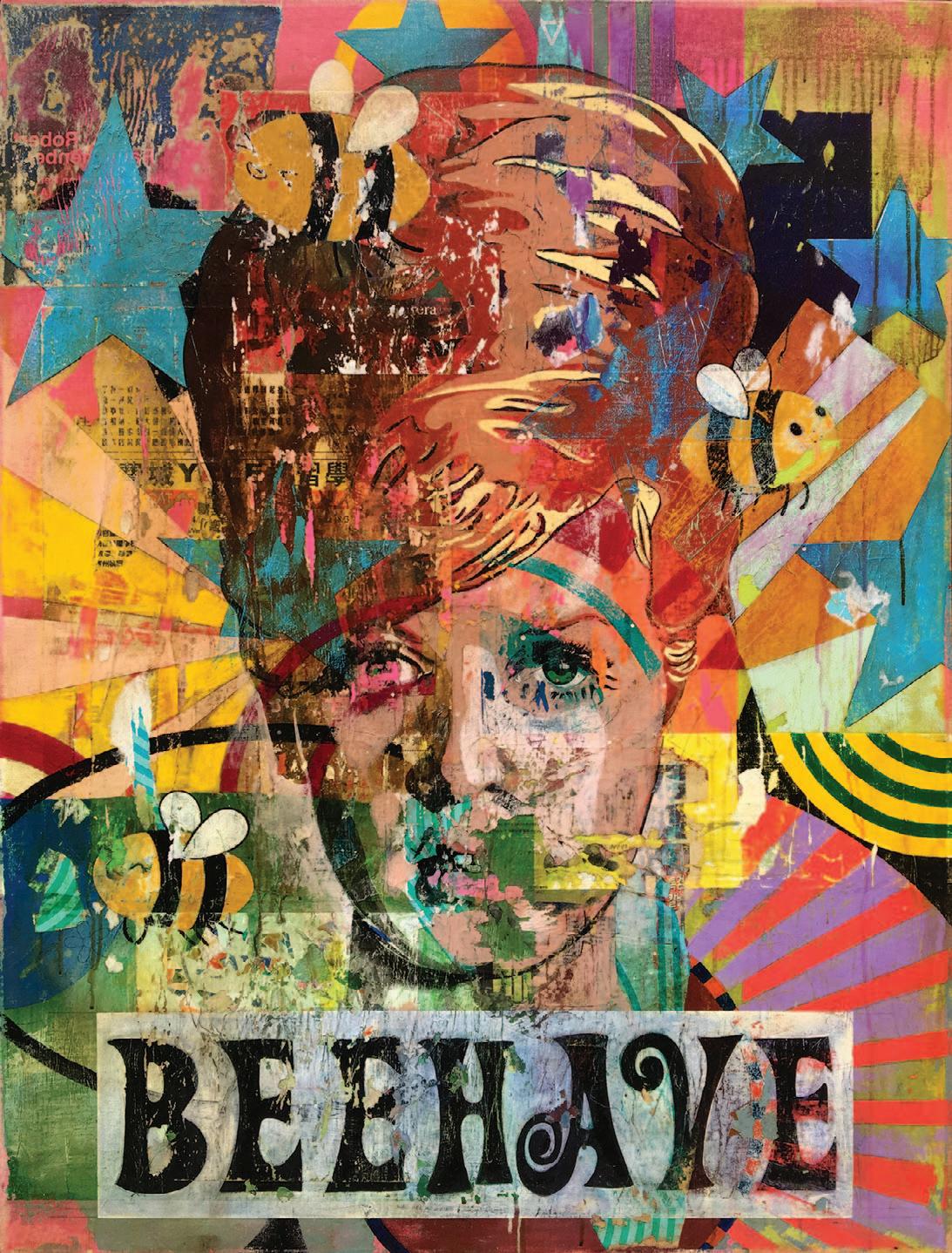
Murray’s painting Waterfall is reminiscent of lungs. Depression Cherry is based on a song and uses colors to denote emotions. Wade Out is based on a poem and depicts a person walking into a sea of flowers. The Smell of Marigolds is inspired by his childhood memory of the time to return to school in September when summer vacation is over.
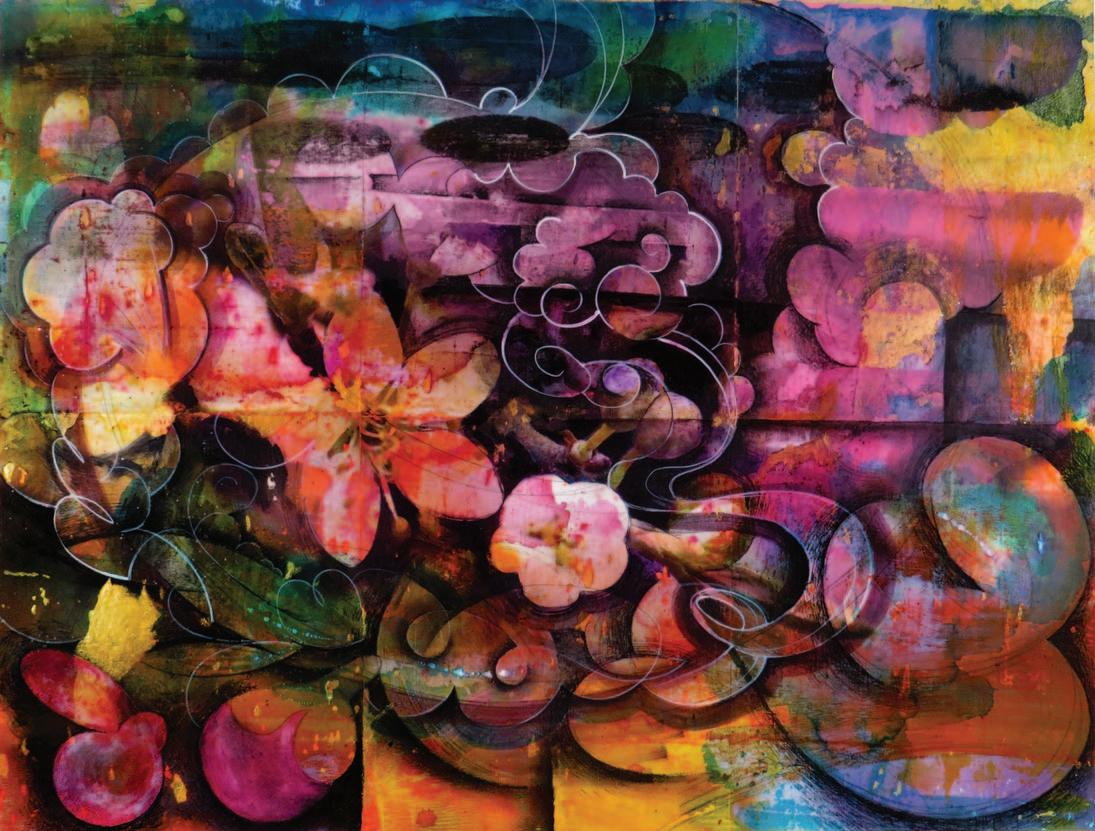 “Depression Cherry” 18 x 24 inches mixed media on wood panel
“Religare” 48 x 36 inches mixed media on canvas
“Wade Out” 18 x 24 inches mixed media on paper
“Depression Cherry” 18 x 24 inches mixed media on wood panel
“Religare” 48 x 36 inches mixed media on canvas
“Wade Out” 18 x 24 inches mixed media on paper
I was often labeled a prolific artist who wanted to work all the time and was always busy. When COVID hit, I slowed down to reevaluate and reflect where I was with respect to my art. I realized I was just doing art as work. I had lost my enjoyment and felt disconnected and wondered why my art no longer made my heart race. Just as I desire to inspire my students, I am searching for my own authenticity. I want to find people, places, and
things that inspire me, and am always in the process of determining how art connects to my heart.
His path forward may once again be influenced by his earliest experiences. Murray recalls his childhood when he played on his grandfather’s farm, and how his aunt inspired his love for all Asian art, including Zen and Asian gardens. He loves landscaping, gardening, planting trees, and placing rocks, and is considering landscape design architecture as the next chapter in his life.
Murray lives in Niskayuna with his wife, Kerry Tymeson, an elementary school teacher, an d their son Jackson who is a senior ma joring in both Education and Anthropology at Skid more College.
You can learn more about the artist at his website, www.christophermurrayart.com
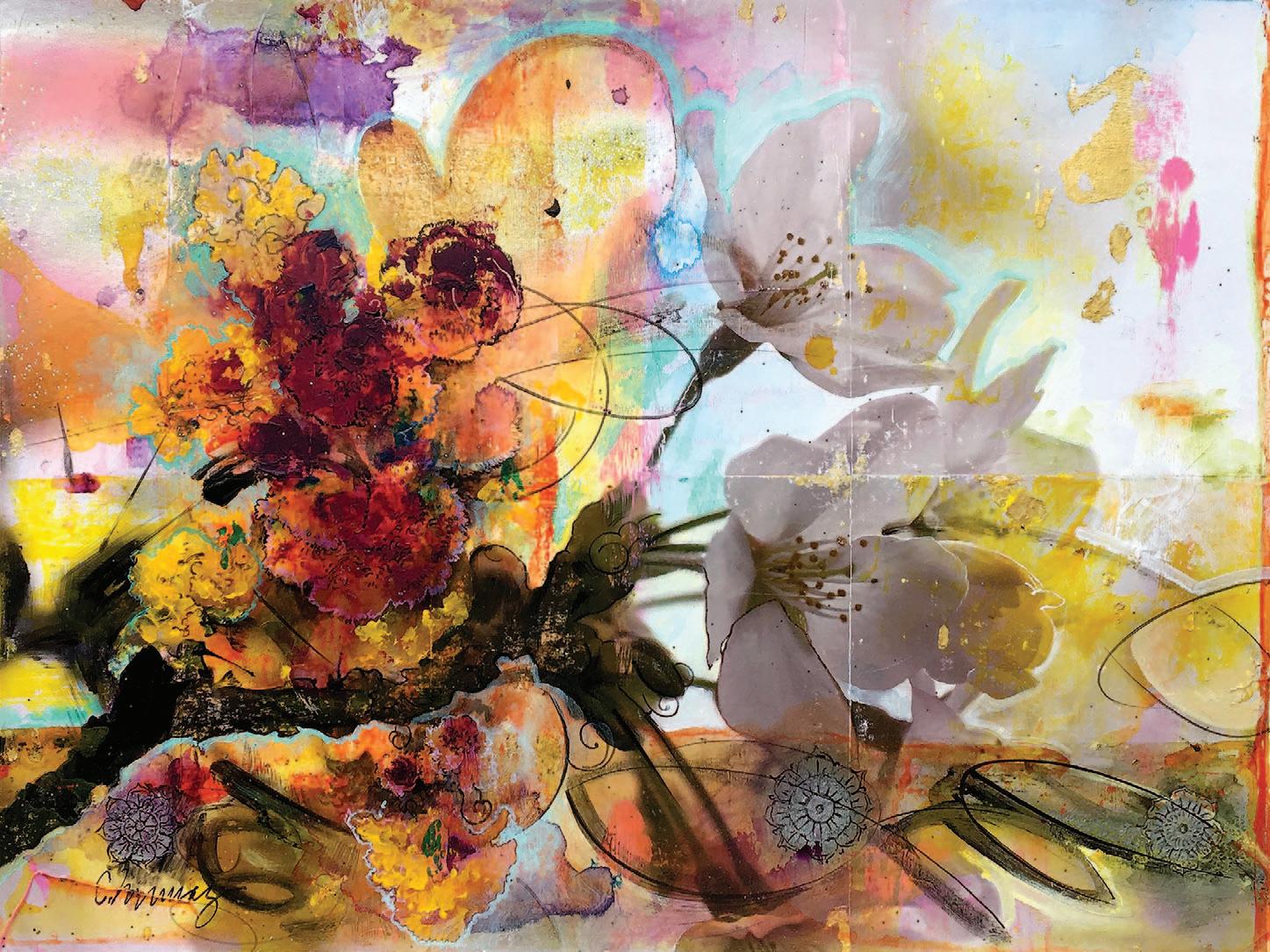
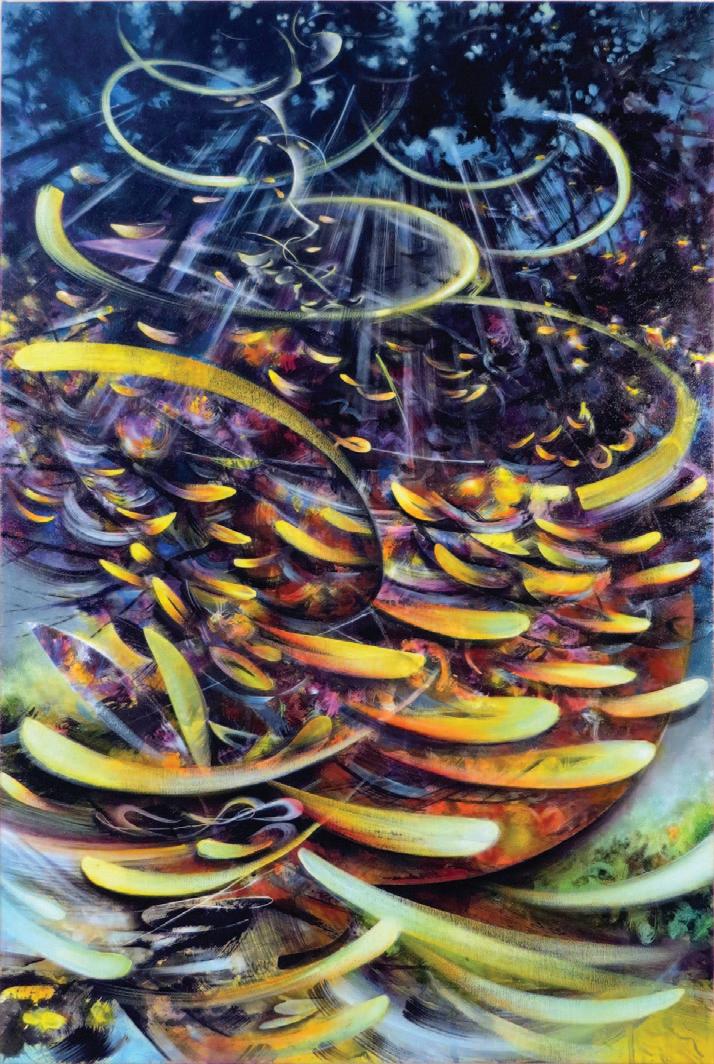
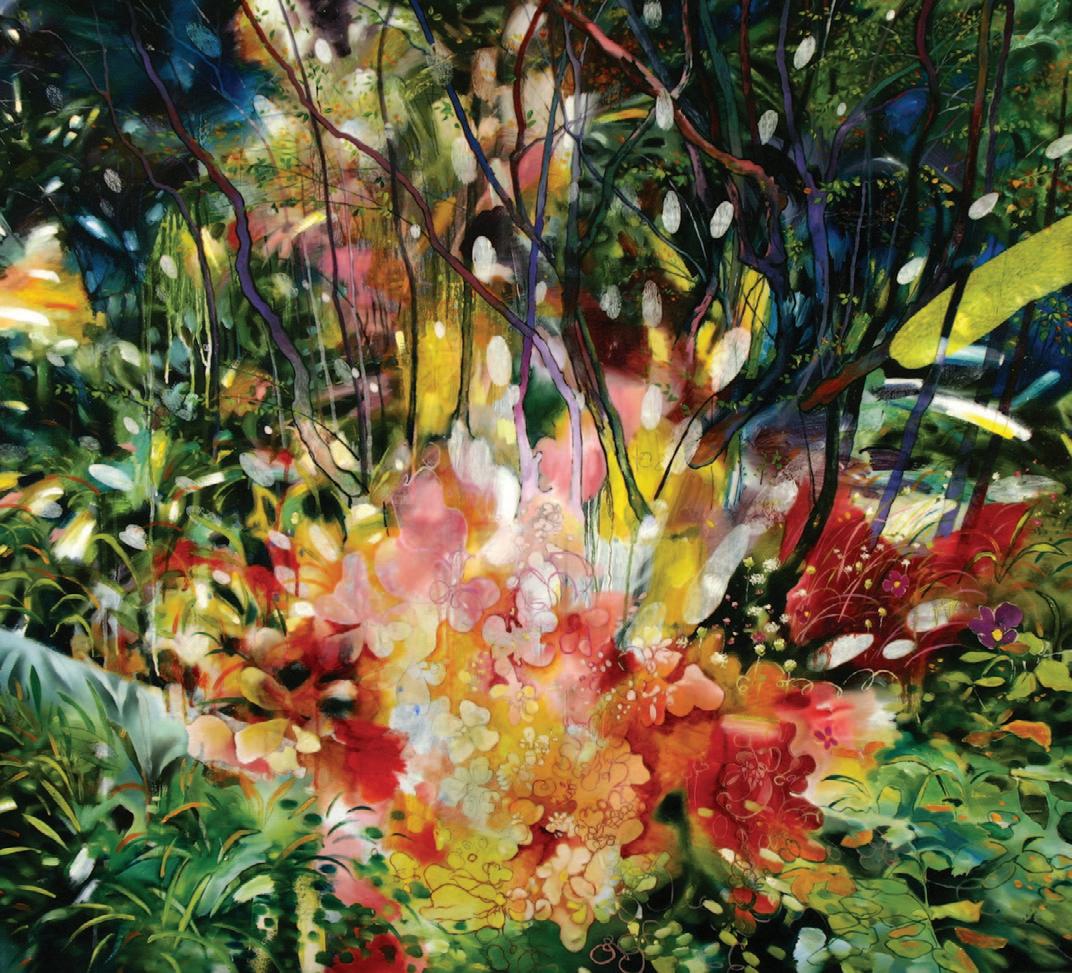
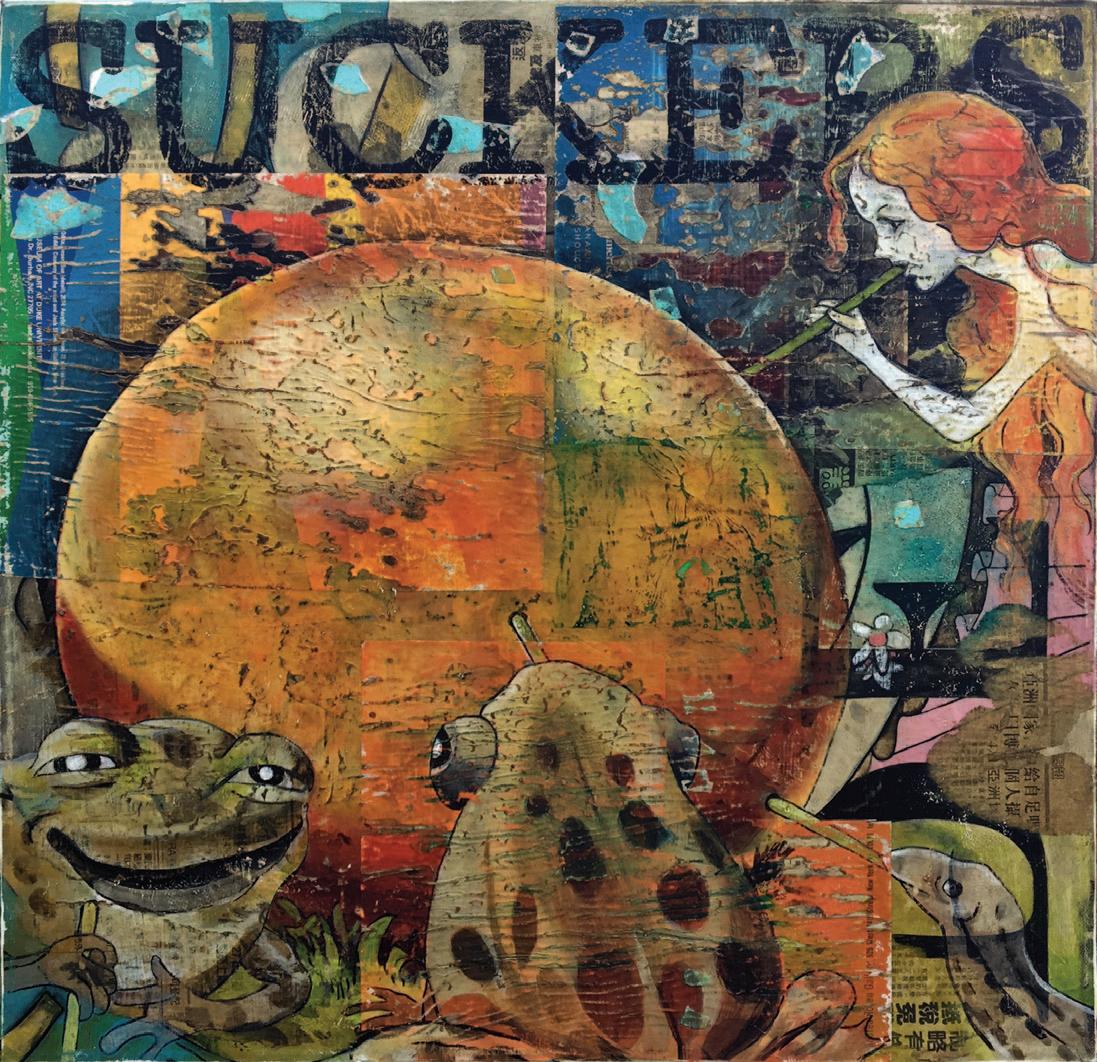
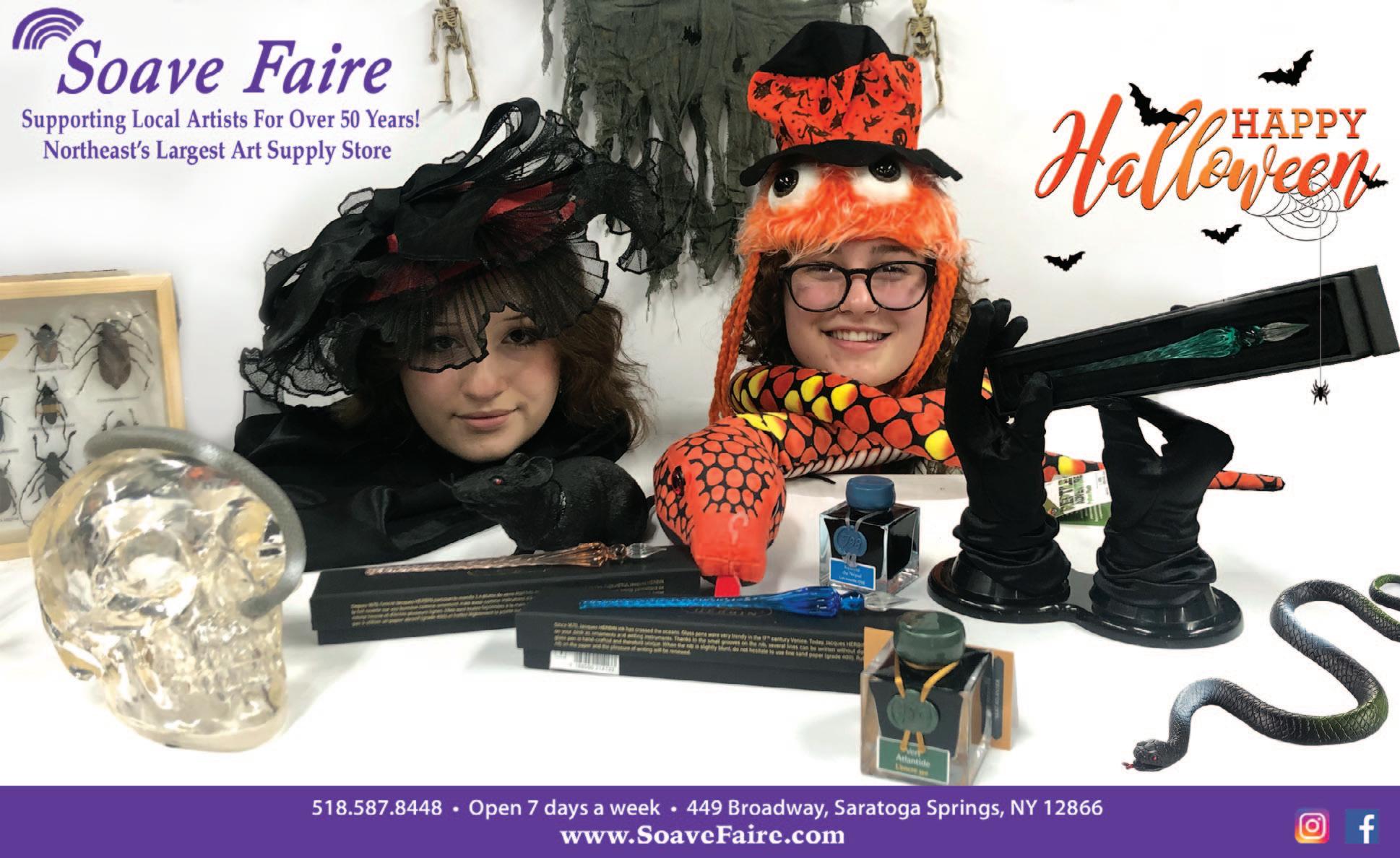
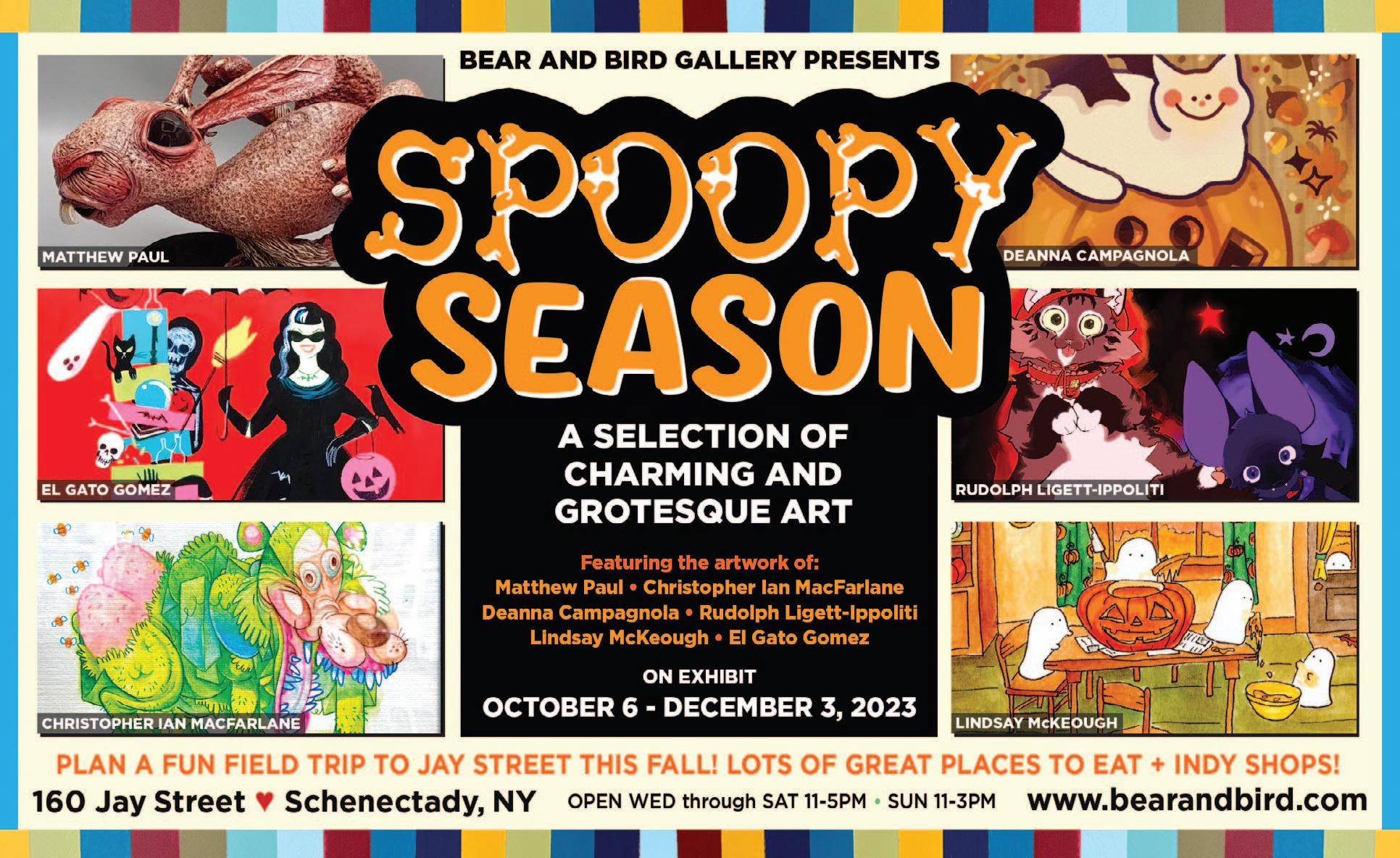
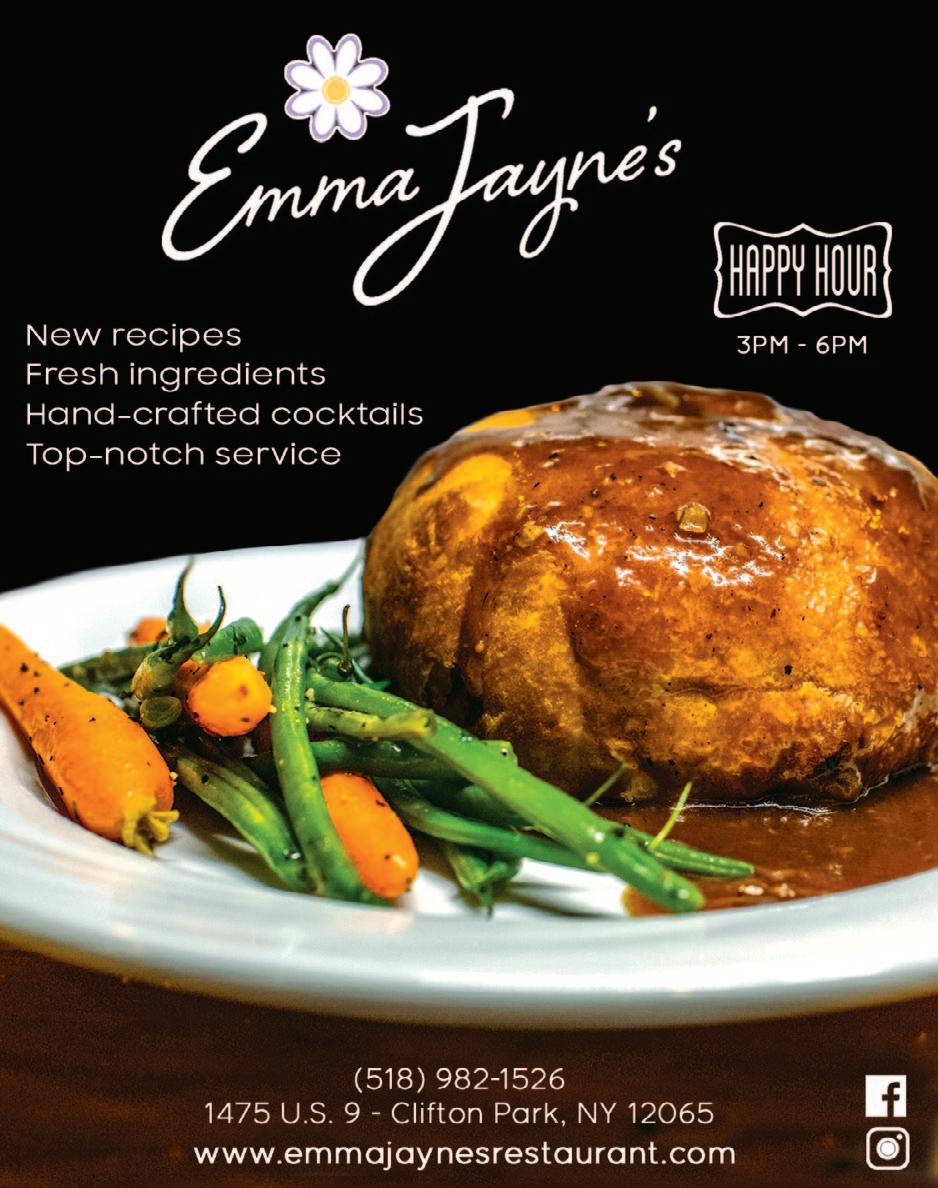
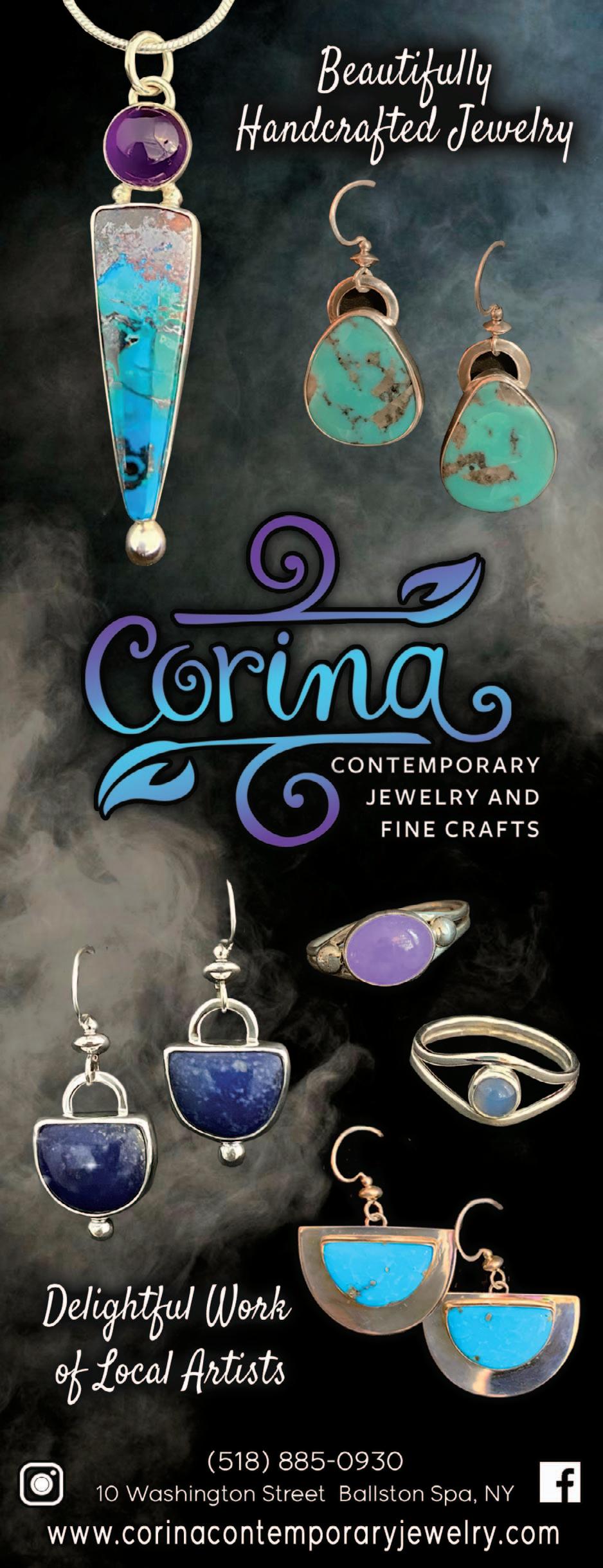


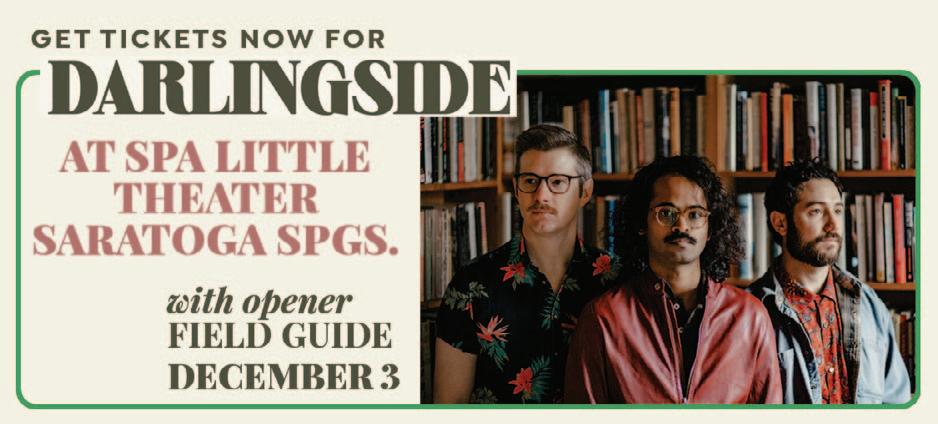
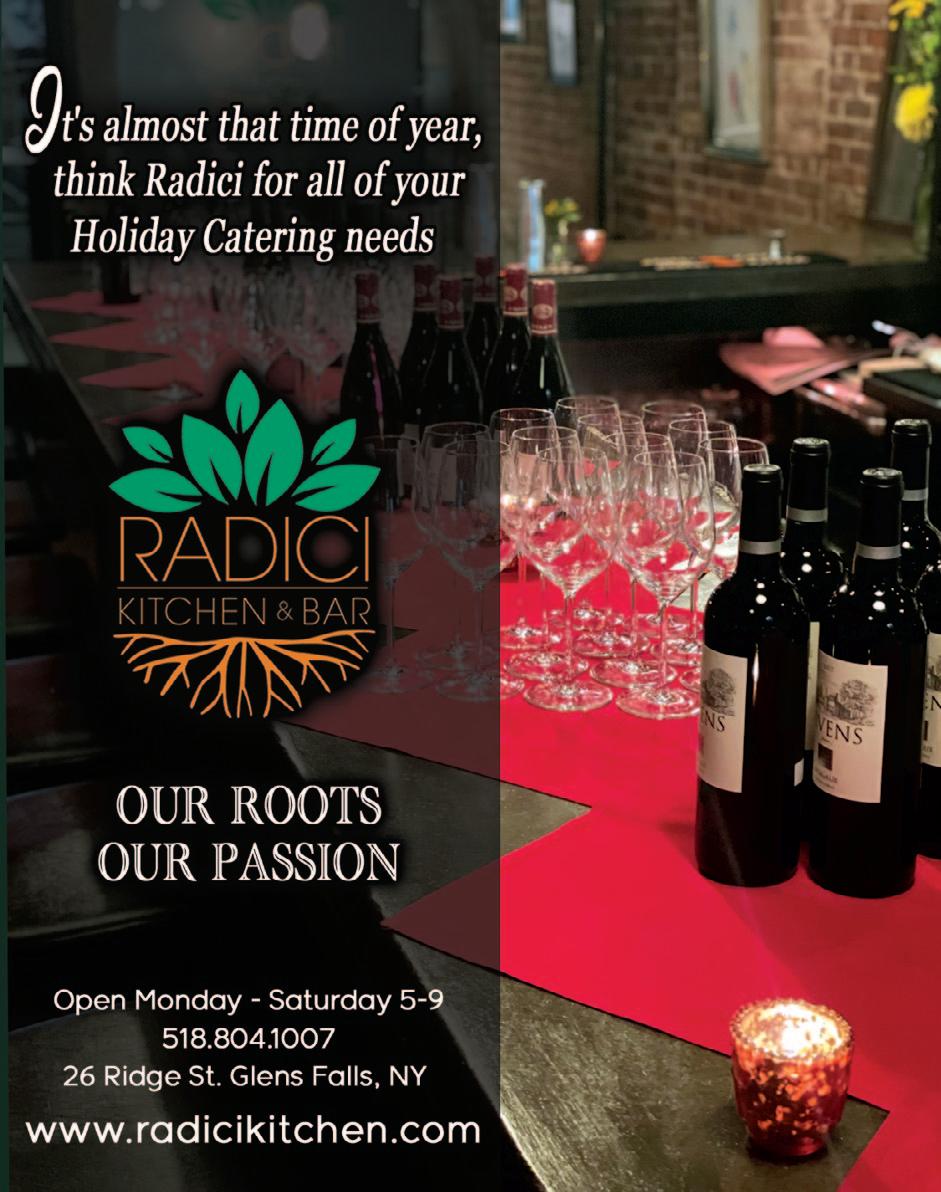
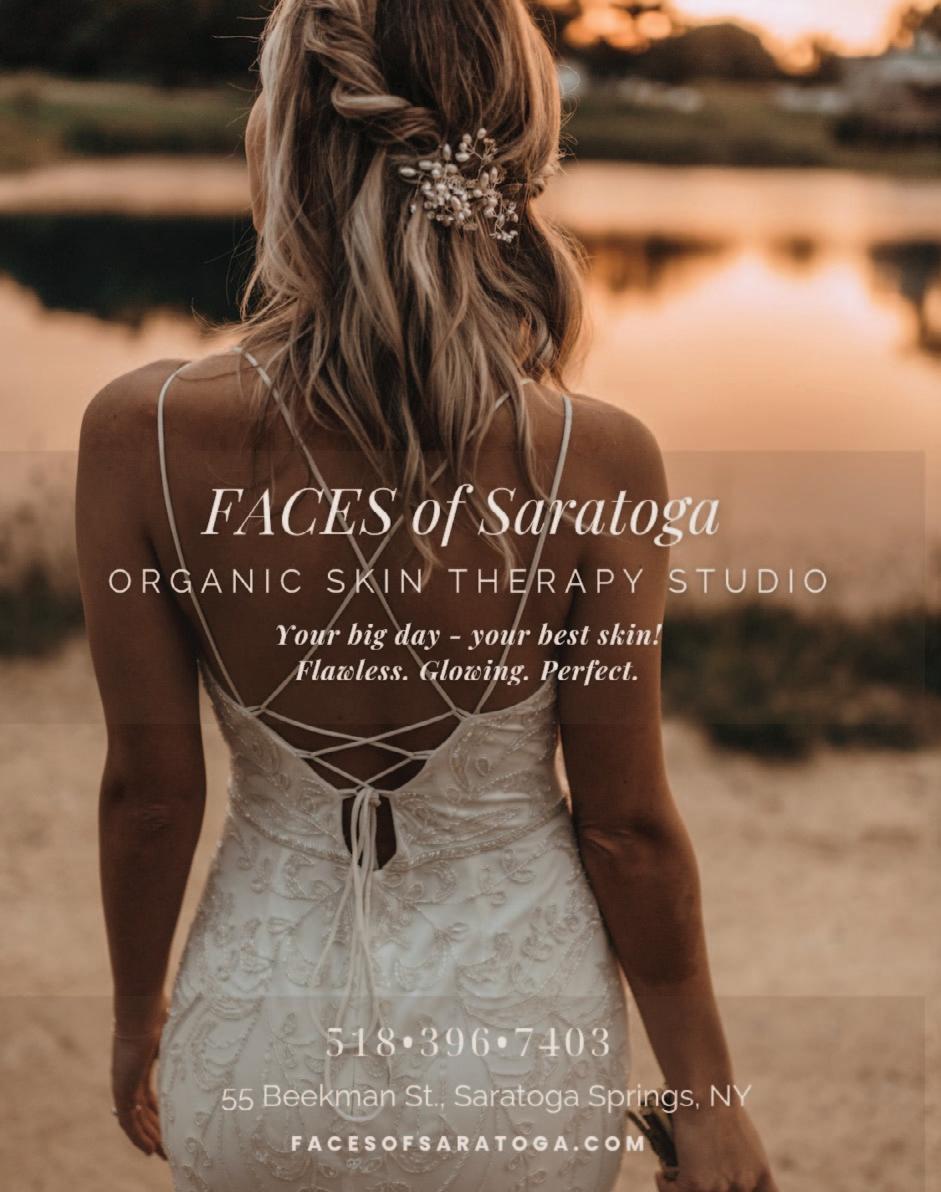
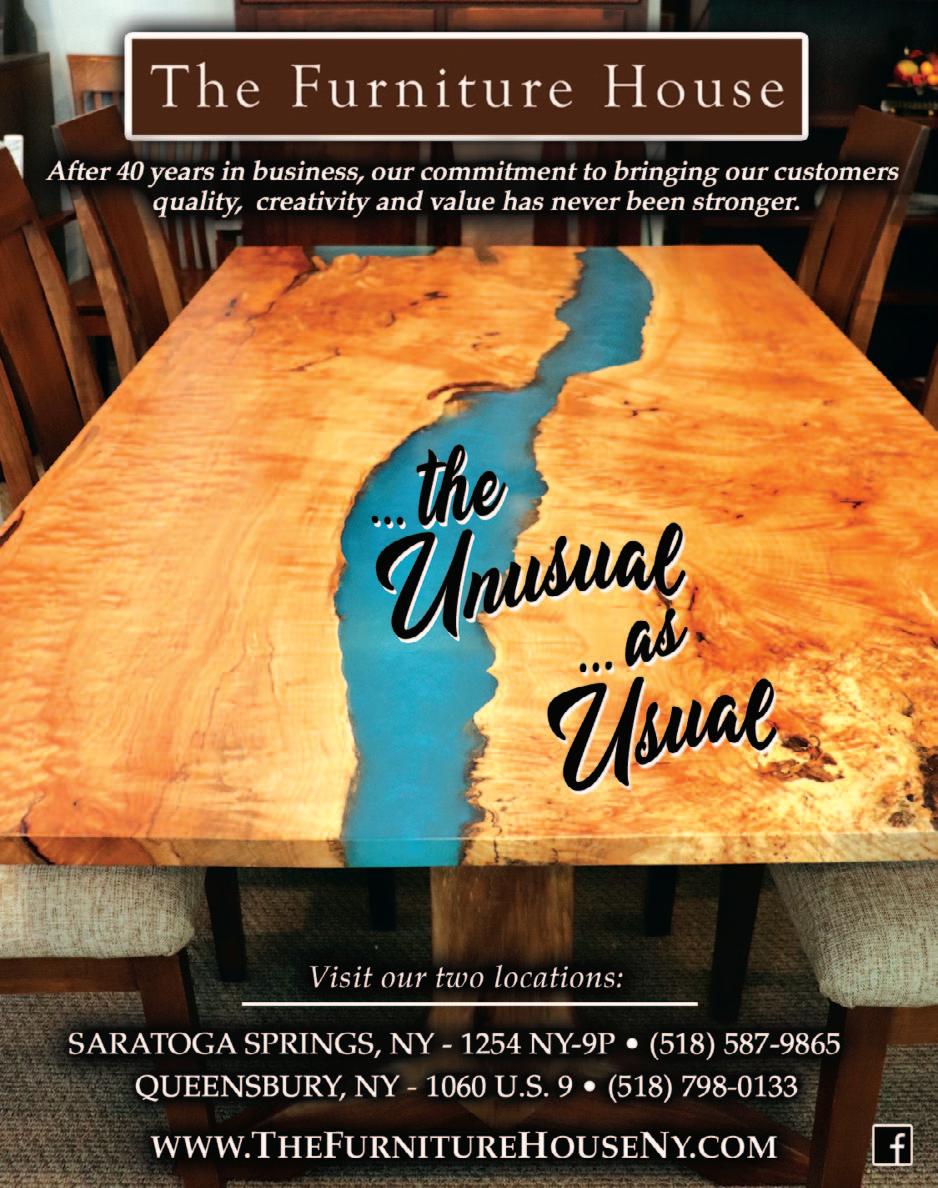

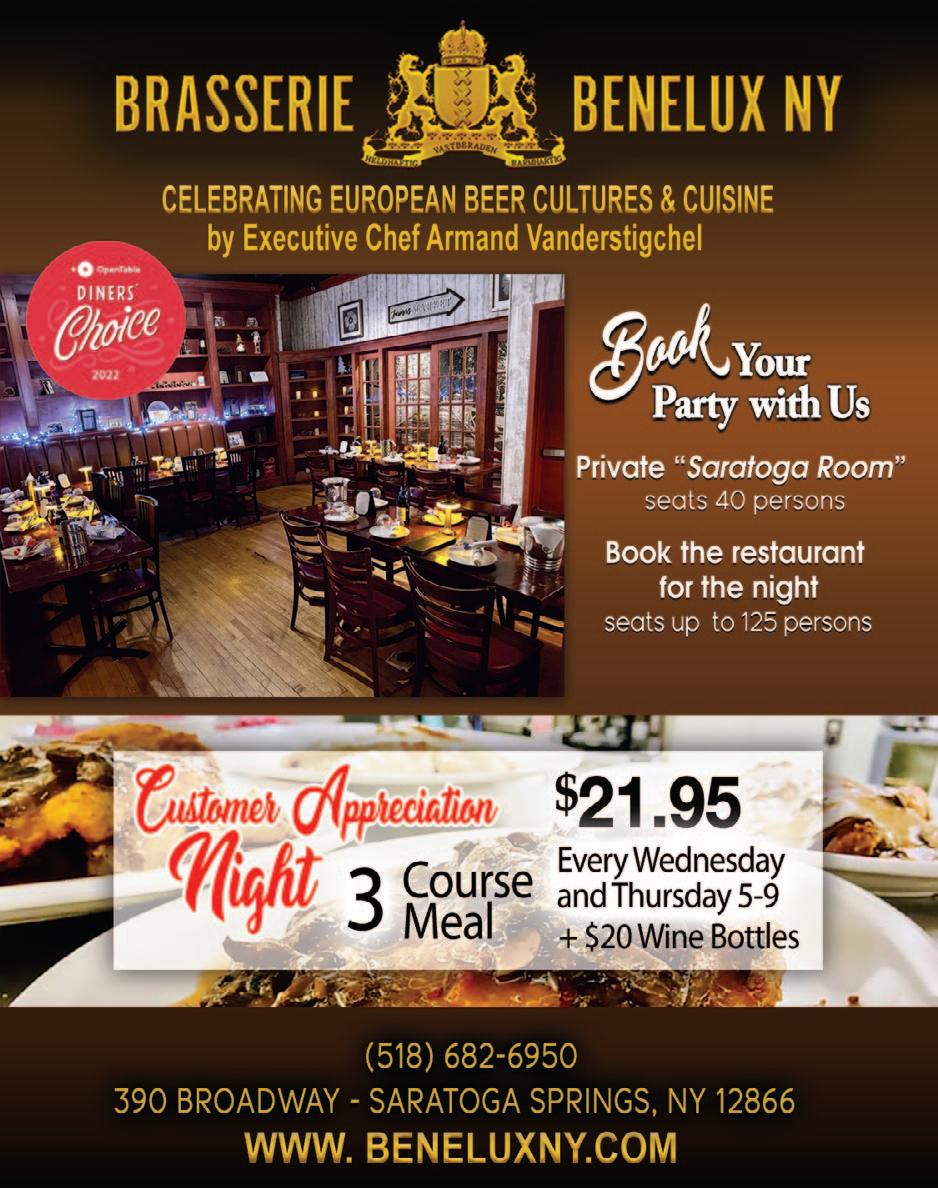
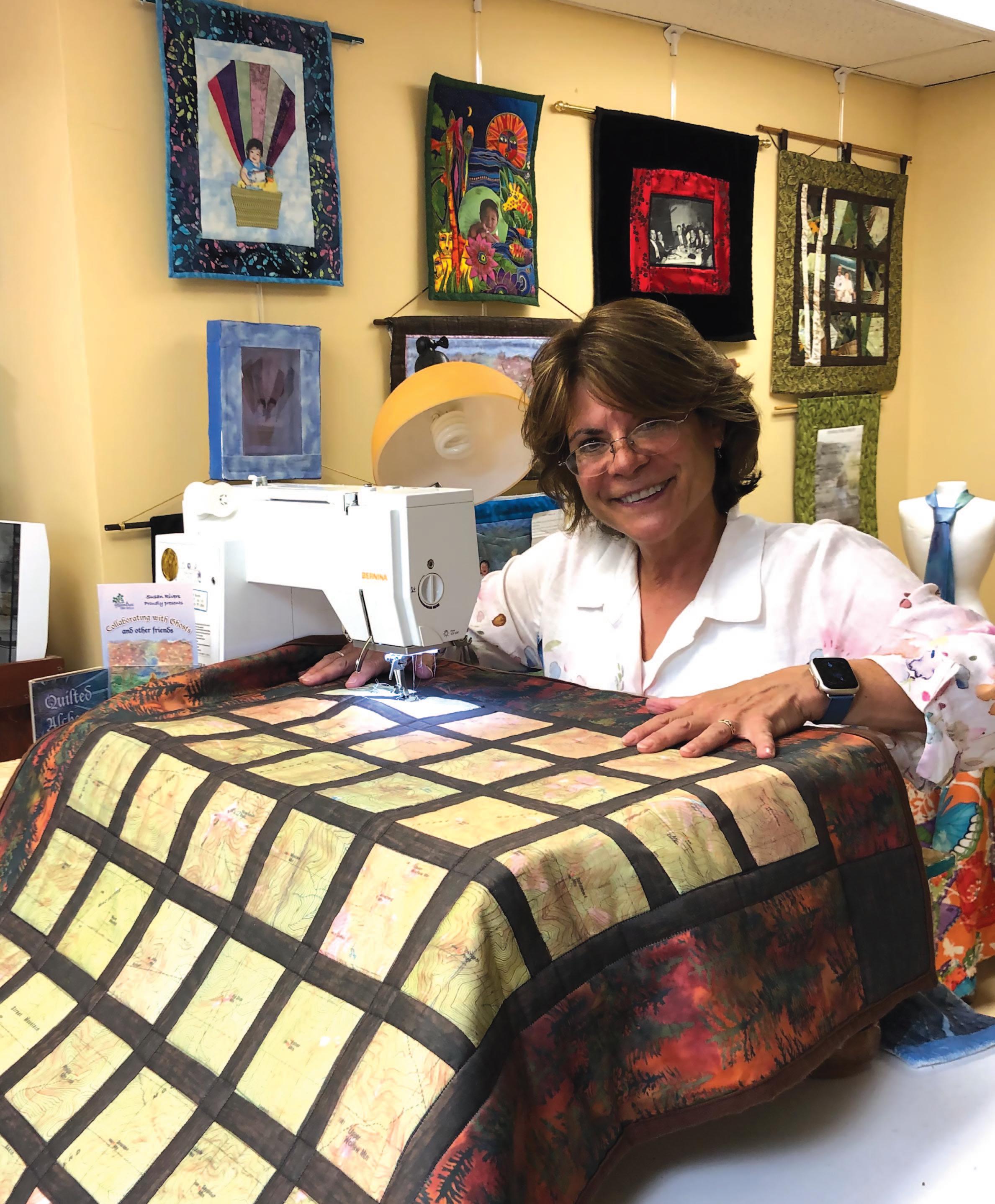
 by Carol St.Sauveur Ferris - photos by Stephanie Sittnick
by Carol St.Sauveur Ferris - photos by Stephanie Sittnick
These days capturing special moments in life is as easy as grabbing your cell phone and snapping a photo on the spot. Then the image is shared with family and friends on social media platforms and saved in the Cloud where it may or may not be seen again, all but forgotten. For fiber artist Susan Rivers, capturing special moments often begins with a cell phone image as well but rather than storing it away, it is creatively re-imagined with layers of fabric to be remembered and cherished forever.
A lifelong New Yorker, Rivers was born and raised in the Bronx and had the privilege of growing up with active grandparents in her life whose influence is still felt years later in significant ways. One grandfather worked in the garment district of New York and the other was a pharmacist. Though their occupations were as different as night and day, a young Rivers was fascinated by both, observing and absorbing their unique characteristics over the years, which she now draws from in her own work!
Between then and now, Rivers attended grade school and high school at PS109 and Bronx High School of Science respectively. College followed at both SUNY Binghamton and Rensselaer Polytechnic Institute earning her an undergraduate degree in political science and a Masters in environmental and urban planning. Her impressive career has included stints in the non-profit sector, municipal and state govern ment, private planning firms, and more recently at FEMA in Hazard Mitigation. Rivers credits her pharmacist grandfather for her
fas cination with science and the methodical step-by-step process his business required that she used as an urban planner, and now years later, in her fiber art.

While the world of technology was central to her career, Rivers’ love of fabric never waned. It was like that cozy blanket we wrap ourselves in that is comforting and fun, and it was a welcome outlet for her creative right brain. She owes that love to her other grandfather who worked in the garment district, Henry Leo Grunbaum. His world was a feast for the eyes and wonderful to touch and feel. As a young girl, she was captivated by all the textures, colors, and patterns and would snatch all the scraps he brought home to make clothes for her dolls. Eventually. Rivers got a sewing machine and began to piece those scraps into quilts as well.
Now years later, these two very different inter ests and ways of thinking have magically intersected and became the foundation for her exciting second chapter as a fiber artist. Greentree Fiber Arts is the result of this unlikely pairing and was launched in 2010. Her venture owes its name to her Poppy, Harry Grunbaum, whose last name means “Greentree” in German and is a fit ting nod to the history of her love for fabrics,
fibers, and family. And “quilted alchemy” is how she describes her process of creating such beautiful artwork.
“Quilted Alchemy is a multifaceted approach to the legacy and innovation of quilting. An en chanting mixture of folk art, technology, and personal experience.”
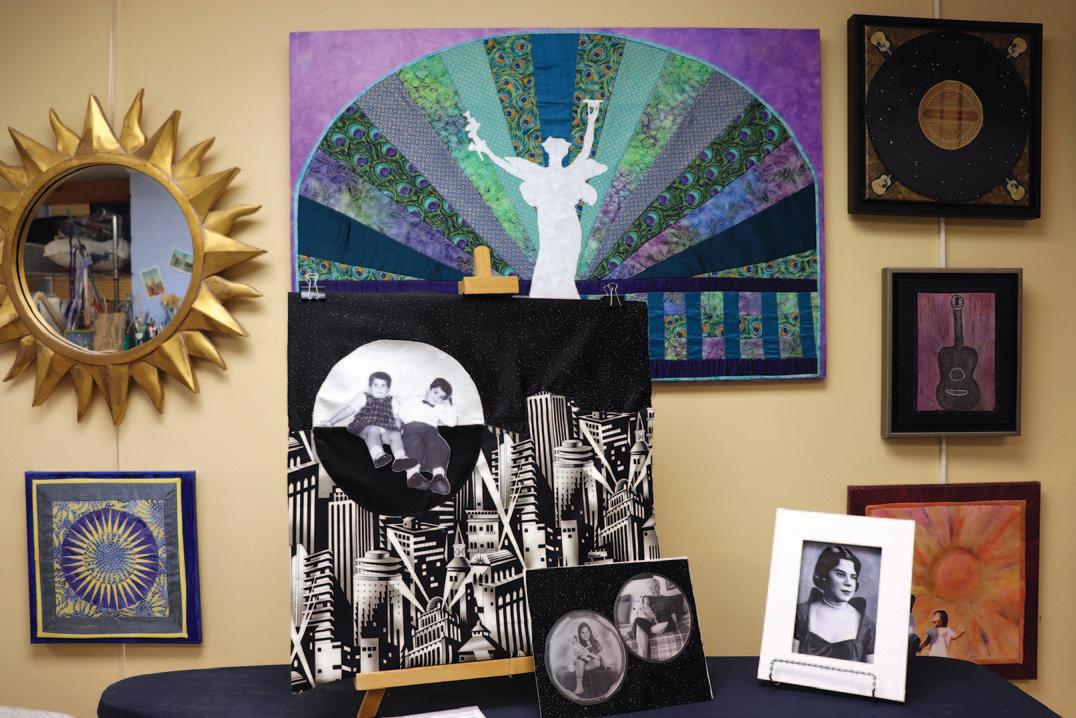
As you might imagine, her artistic medium is primarily fabric as is her canvas. Instead of brushes and palette knives as her main tools, Rivers uses some conventional and unconventional items including her computer, sewing machine, needles, and thread. Her compositions are more often than not rooted in memories and tell a story about the recipient of the piece or their loved one.
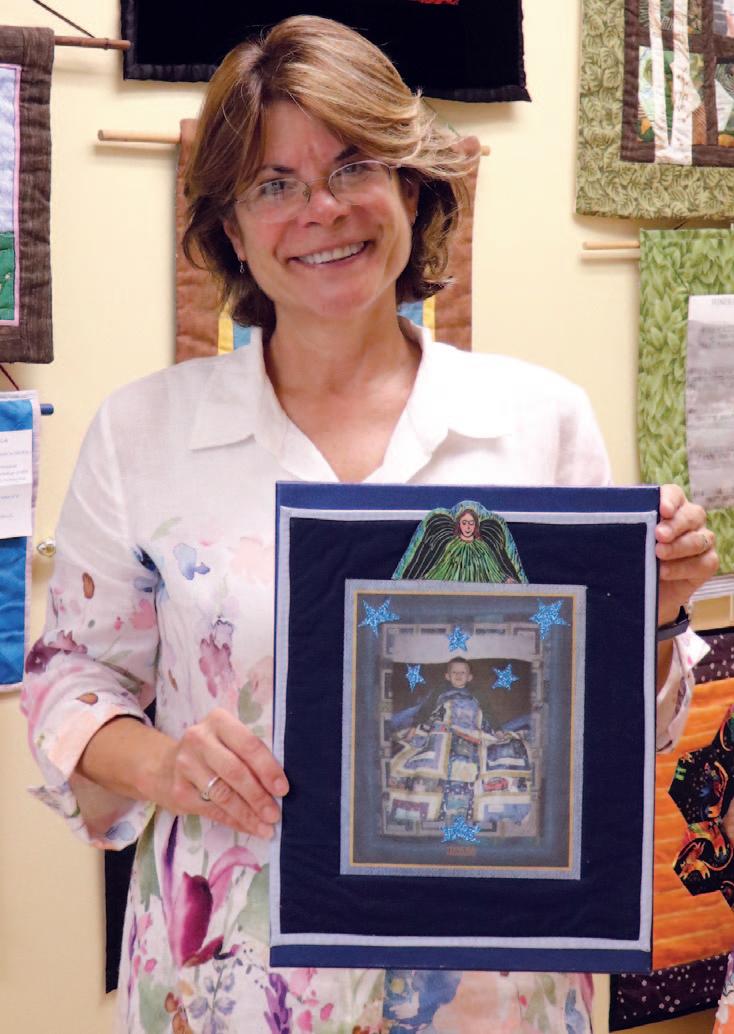

When she begins a custom project, Rivers clar ifies the who, what, and where details and then reviews the images that either she or her client
has selected for consideration. She also assembles fabrics, threads, and trims that will best convey the memories or tributes to be preserved. As with other artists’ mediums, their colors and textures speak to the emotion to be imbued and conveyed in each one-of-akind piece.
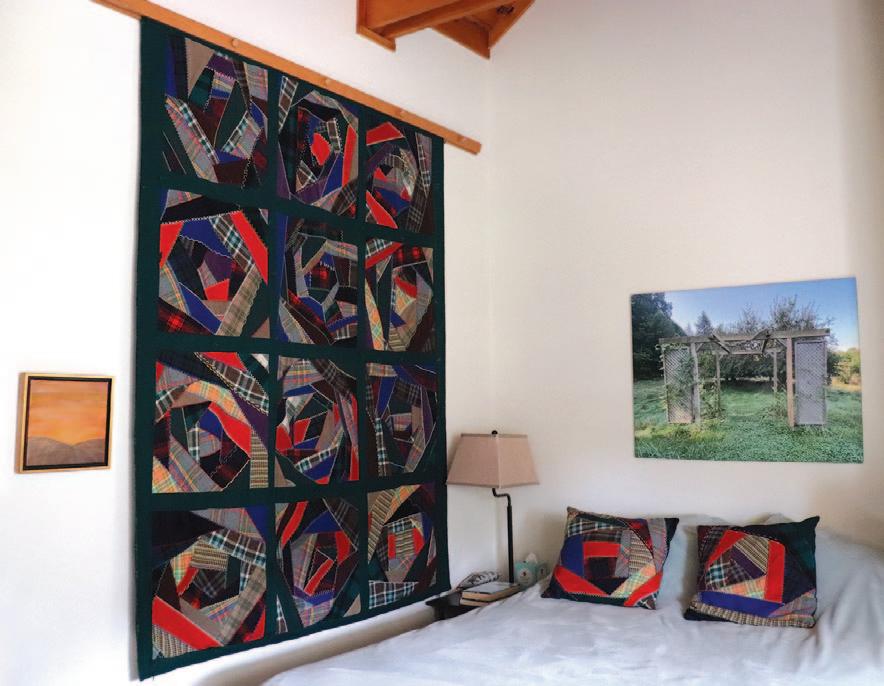
On the computer, Rivers edits and scales the images she intends to incorporate into a composition. She might add additional details to enhance them as well. The image(s) are then emailed to an online company like Spoonflower, which does print-on-demand products such as fabrics and wallpaper for independent artists like Rivers.
Prior to printing, she will have also selected one of Spoonflower’s stock fabrics, usually a highquality organic cotton, taking into consideration the texture and durability needed for the project. Or she may design an exclusive fabric that Spoonflower will print, selecting colors, and adding patterns, if warranted, for a truly oneof-a-kind piece. The final work of art can be framed but most of her extraordinary designs are fabricated into quilts and lap blankets, sa cred garments like intention garments, and decorative pillows.
As is often the case, today’s life happenings in spire tomorrow’s creativity. When a close friend’s child was diagnosed with cancer and had to spend many lonely days in a sterile hospital room at Sloan Kettering, Rivers decided to make a quilt that would be special and meaningful for him. Ryan was just four years
old at the time spending days that turned into weeks without his family, toys, books, and stuffed animals. Rivers lovingly designed and fabricated a cozy quilt for him incorporating pictures of his family, friends, and familiar toys so that he didn’t feel so alone.
“I loved the idea of adding images so that the child can see their family while they’re in the hospital struggling.”
Ryan would wrap himself in it and look at the pictures which brought him tremendous comfort during such an awful time; it gave his parents a little comfort as well knowing that he had something special to cuddle. Sadly, Ryan lost his battle and passed at age 12. But that little boy’s special quilt was the first of many Comfort Quilts that Rivers continues to lovingly create.
In fact, she received a grant that helped sub sidize many more quilts for patients at Sloan Kettering and the Albany Ronald McDonald House.

In addition to Comfort Quilts, Rivers also de signs and crafts one-of-a-kind Memory Quilts. Memory Quilts are designed for those left behind and capture the precious life of a loved one. Once again, with the same gentle heart and respect that is at the core of her being, Rivers studies the images a client will provide along with all the special bits and pieces of their loved one’s life and creates
beautiful quilts to be embraced and cuddled for years to come. While designing and crafting each piece, she will often listen to the music and songs that were significant in the life of the de ceased. According to Rivers, the music honors, celebrates, and connects her to the person, which helps inspire her work.
Interestingly, she has also been asked by fellow artists who are now sick or elderly to memorialize their own work in a quilt to be cherished by fami ly after they pass. With these requests, Rivers believes she has been given a gift because

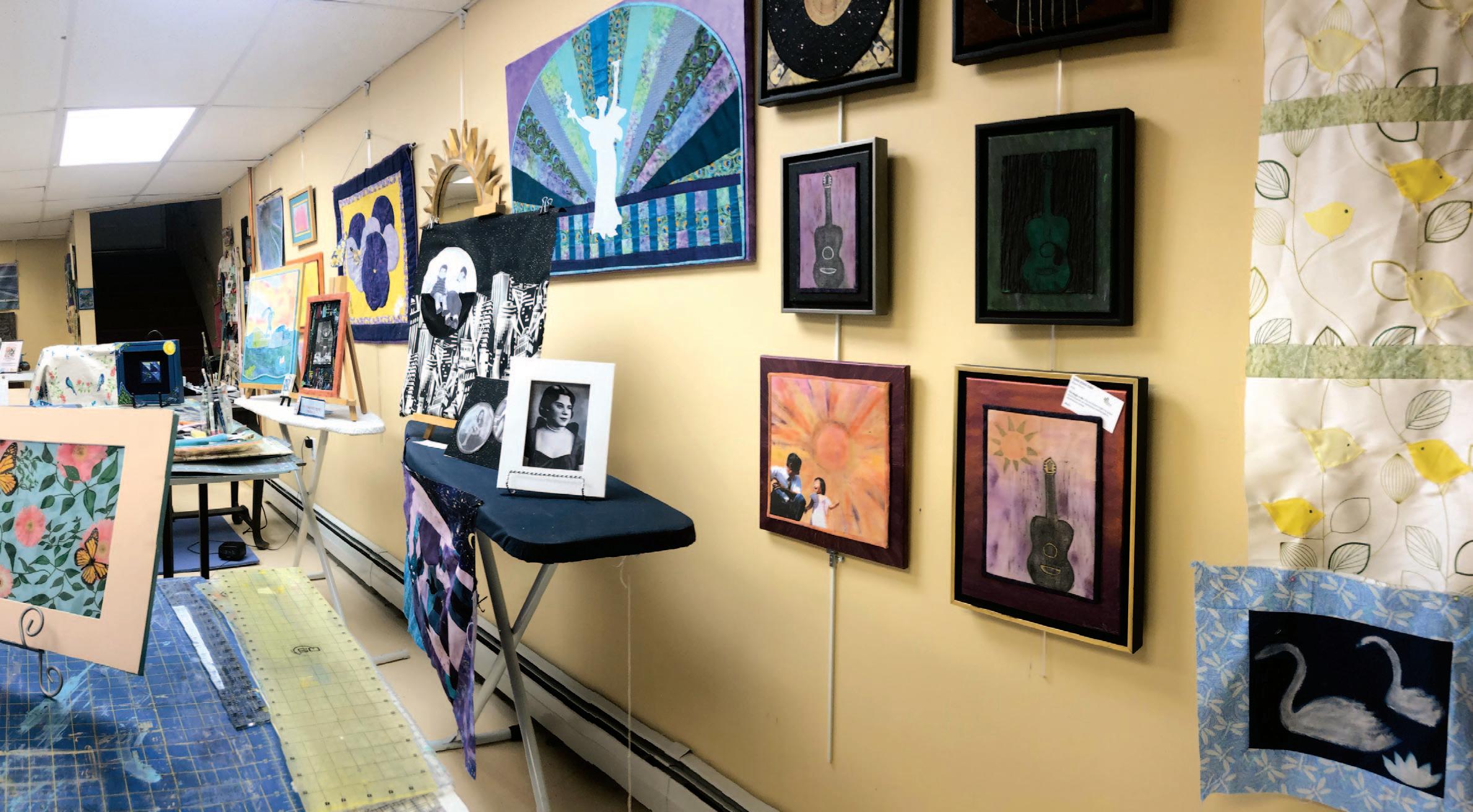
she feels as if she is still collaborating with them after they pass. She calls them posthumous partnerships or collaborating with ghosts.
Marilyn Ramsdale, a good friend and fellow artist, made one such request prior to passing in 2011. She asked that Rivers create a special
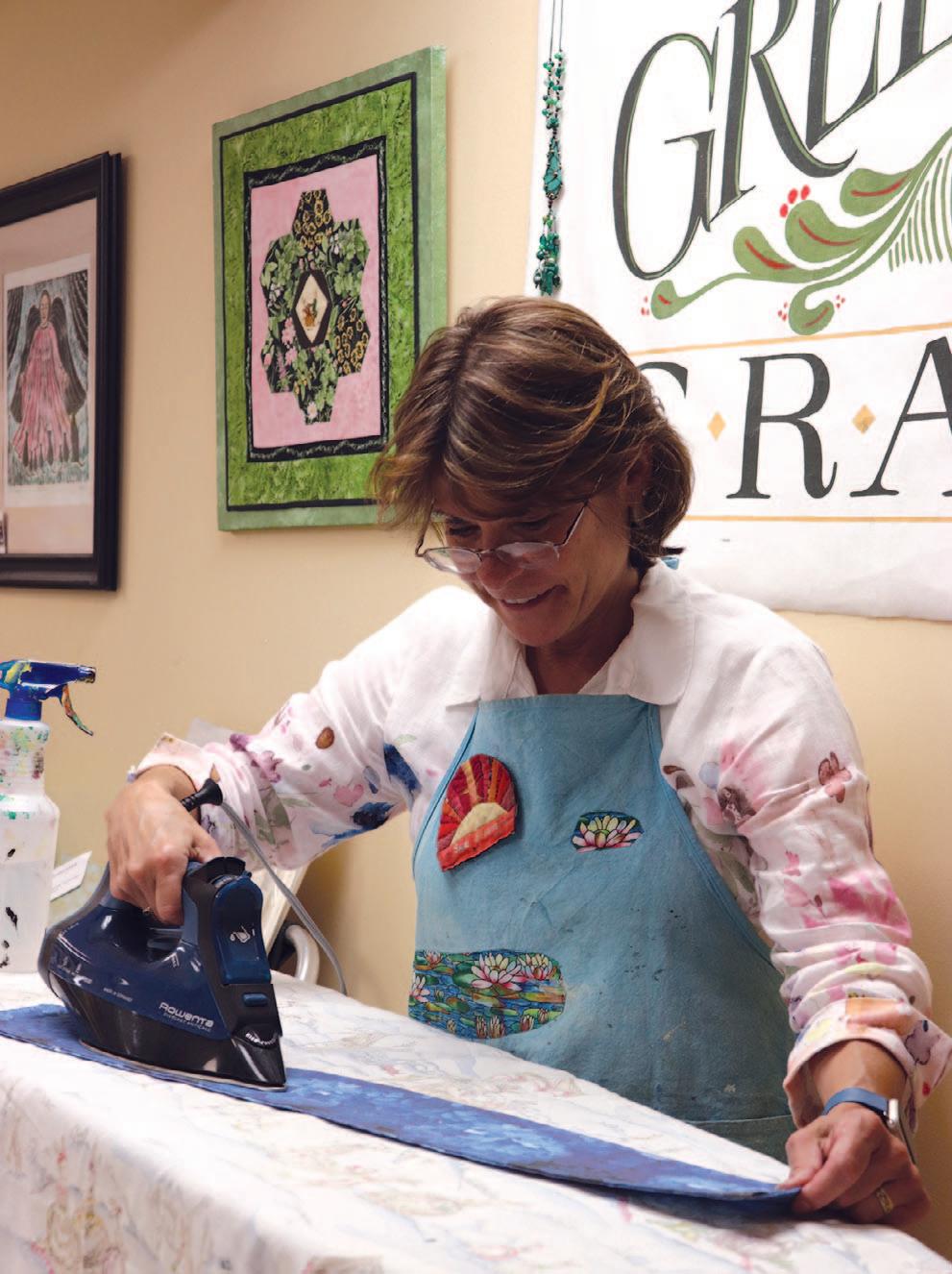
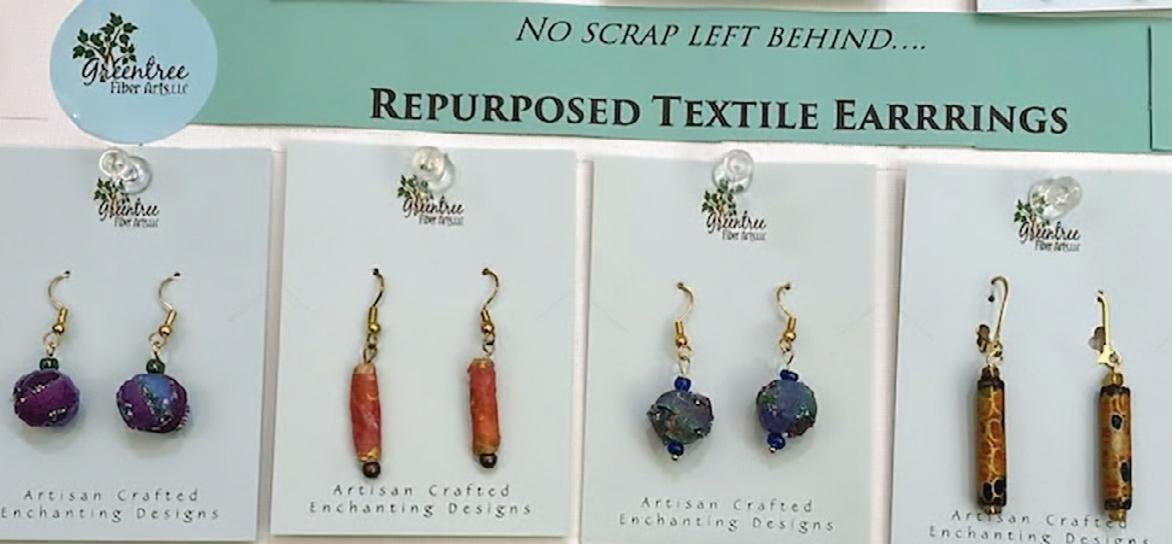
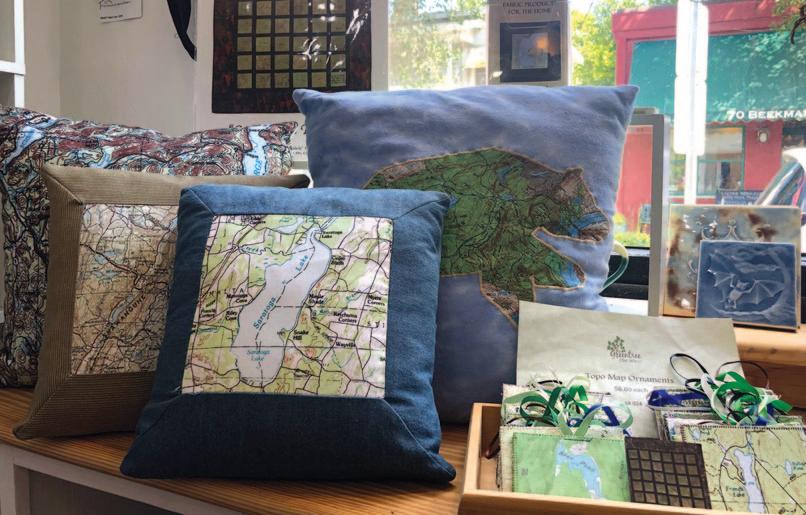
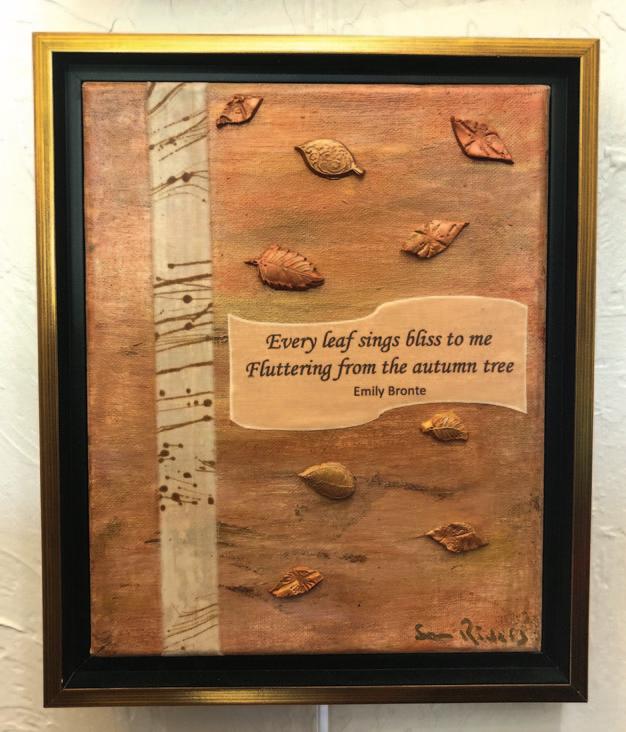
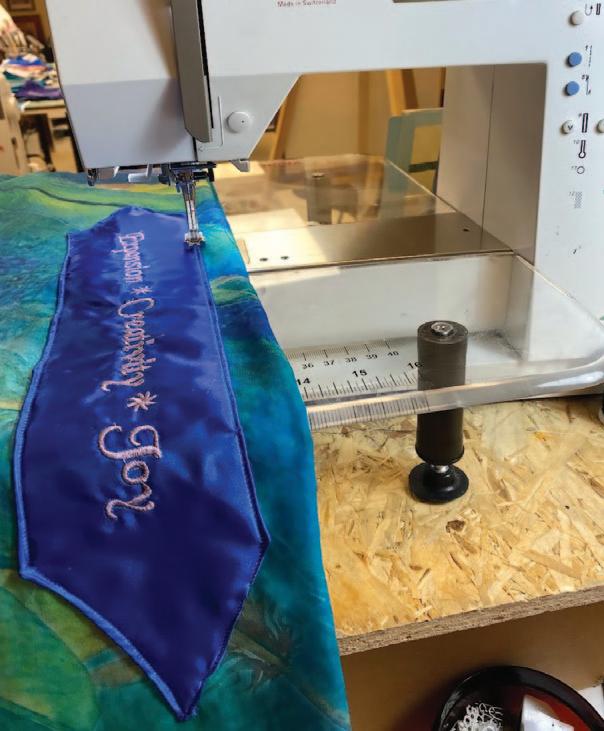
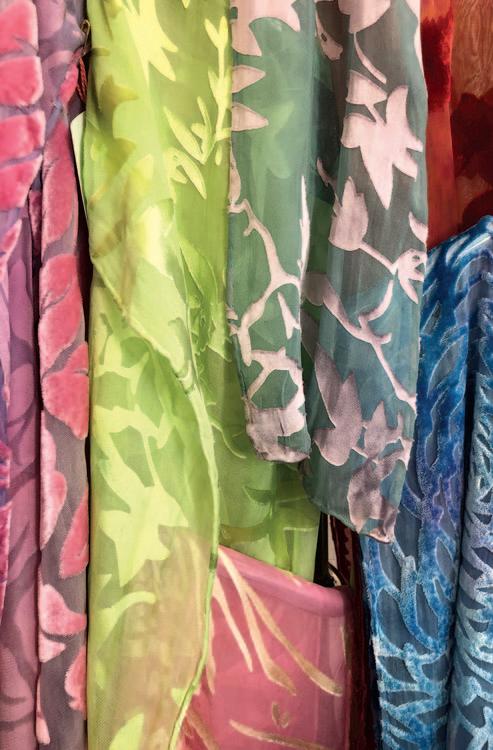
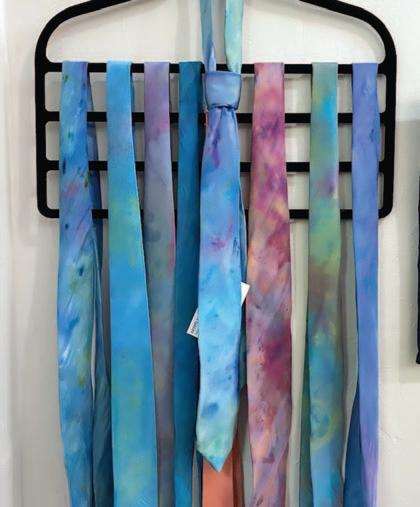
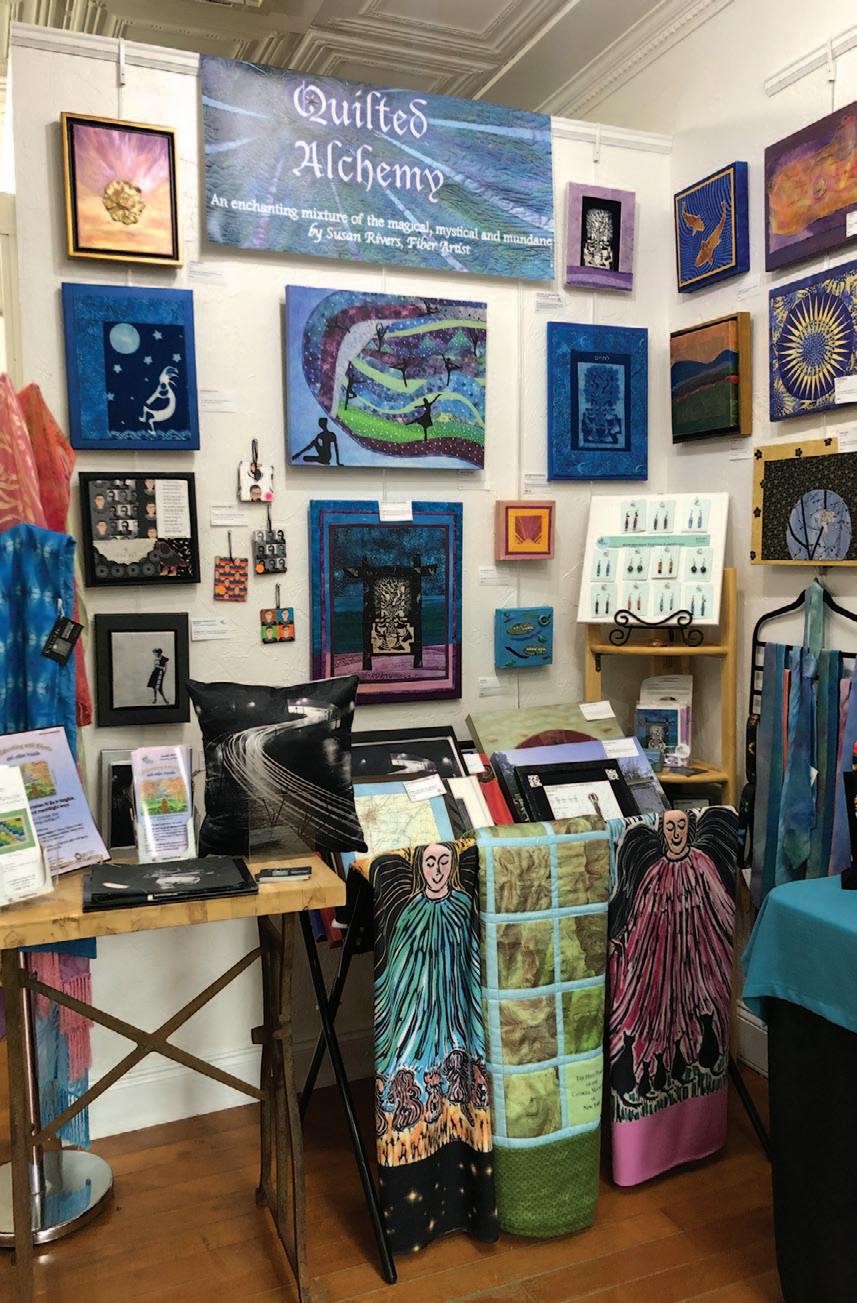

quilt to memorialize her work for her family. Rivers is in the midst of doing that now using many images of Ramsdale’s whimsical block prints and designing the fabric that will connect them. The result will be a unique piece showcasing her artwork but more importantly, it will provide Ramsdale’s family with very special memories.
Rivers also designs and fabricates custom gar ments she calls Intention Wraps which have special meaning as well. When beginning a wrap, she asks the recipient for three words that are
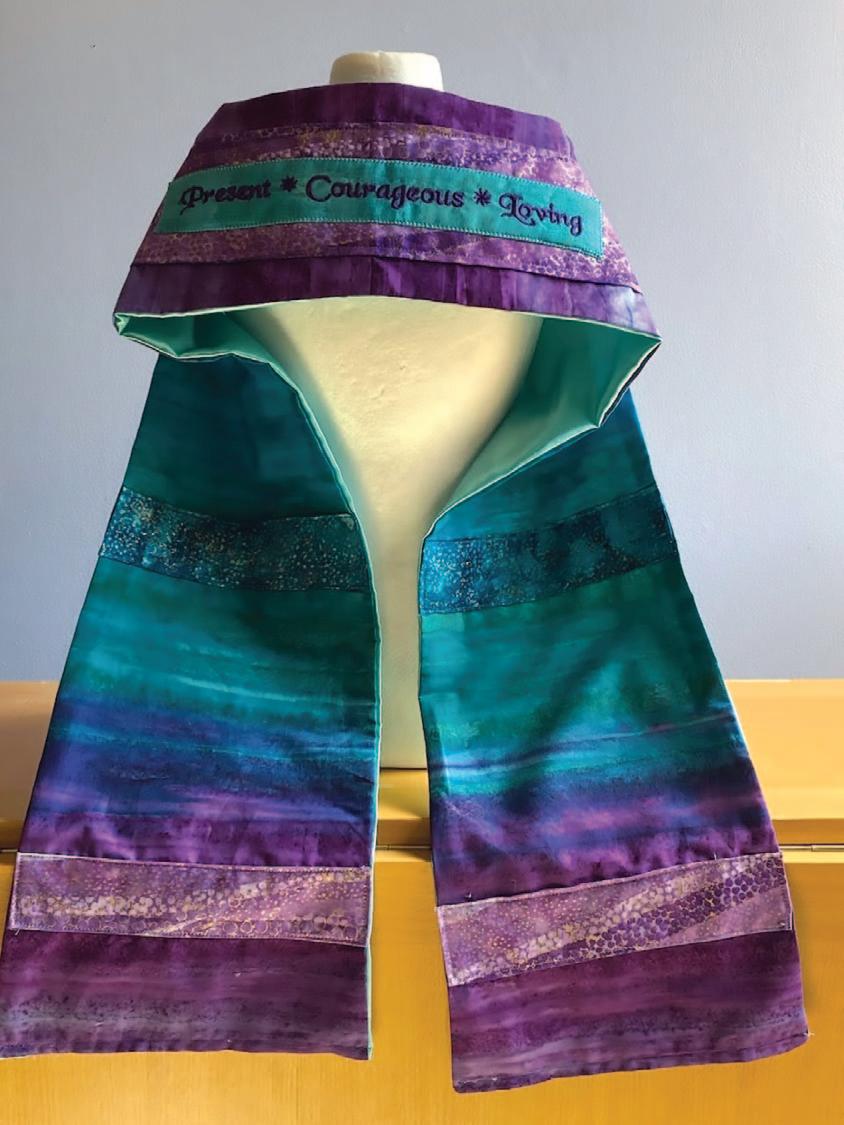
significant in their lives. They can be anything such as accept, em brace, and cherish. She then asks for things a person loves like butterflies, flowers, and birds, and she also asks for favorite colors. Rivers gathers that information and more to start her creative alchemy process. Then the magic happens. The result? A beauti ful wrap designed and fabricated with intention.
When asked if she teaches quilting classes, Rivers shares that she offers drop-in demos and classes that are an extension of her Collaborating with Ghosts concept. The concept is reflective of the same process she works through with her custom pie ces. Would-be quilters learn how to
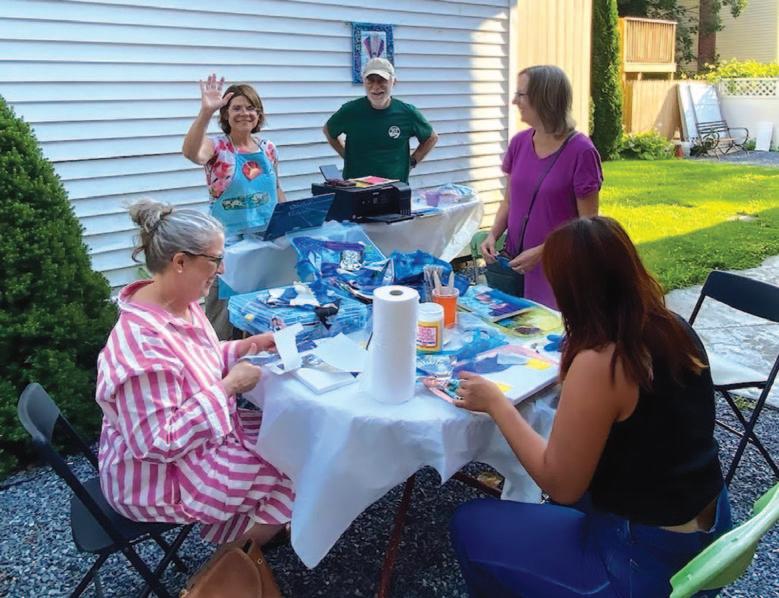
create their own fabric memoirs using pictures and the bits and pieces that define their loved one’s life to be incorporated into a treasured quilt or lap blanket.
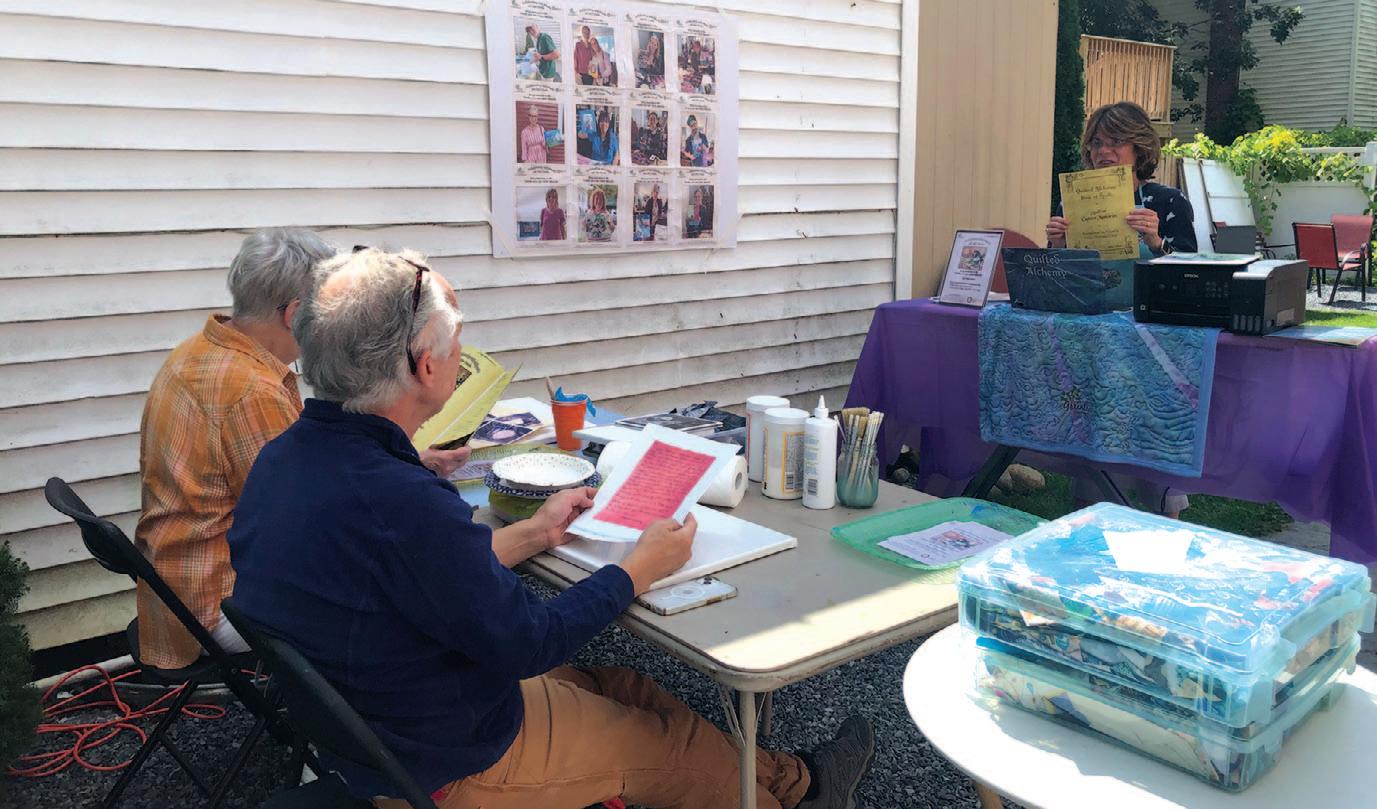
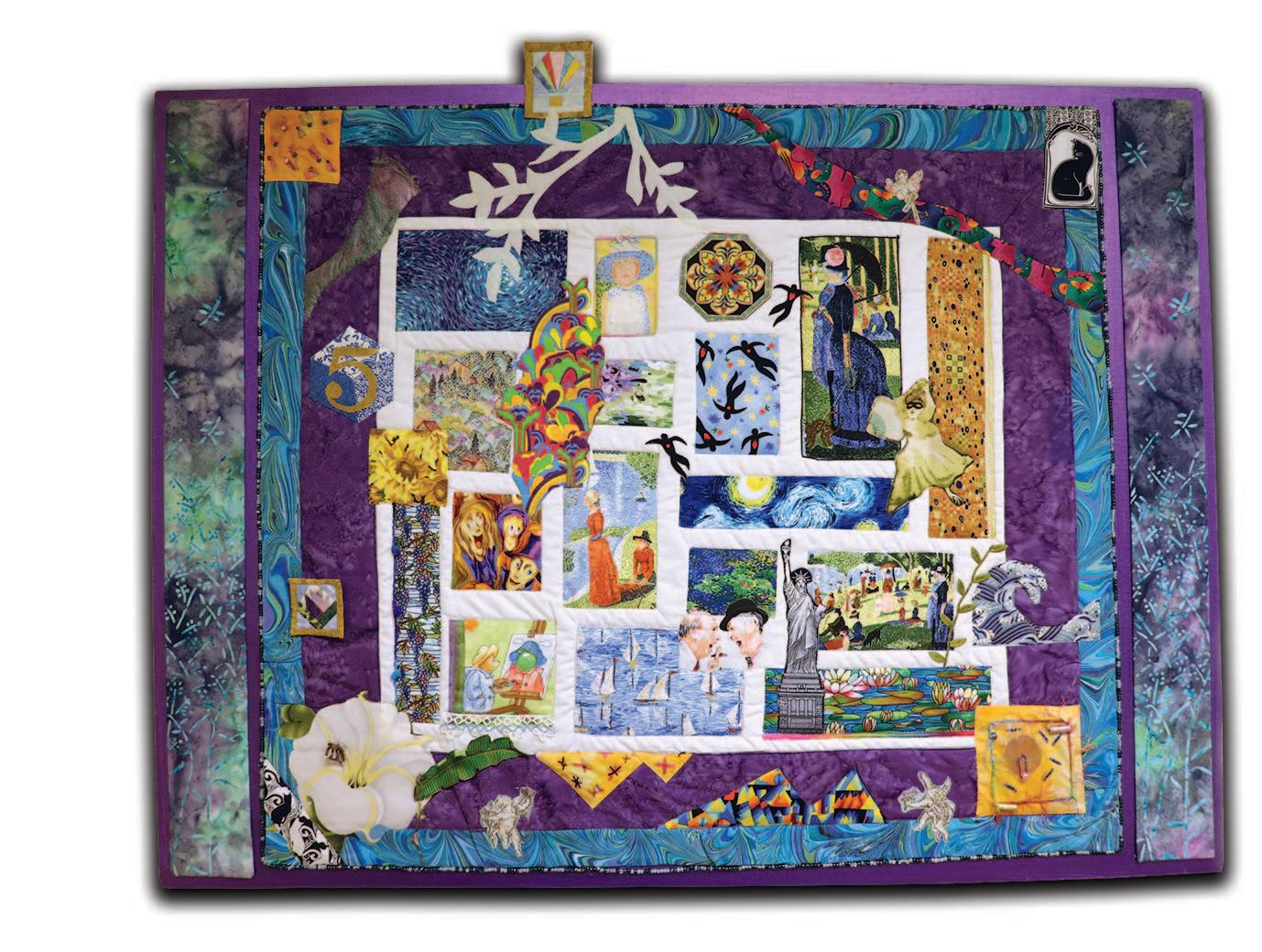
“Creating with fabric is much more than cut ting up material and sewing it back together. It is a personal expression that can convey a celebration of joy, be a catharsis for dealing with loss, or be meditative with purpose and peace in every stitch.”
Through her work, Rivers hopes to convey the fact that textiles, often under appreciated, are an important and historical medium in the world of art.
“Fiber Art is art.” Indeed it is... and so much more. Visit www.greentreefiberarts.com to see and purchase her pieces and fabrics, or better still, see them in person at: The Cottage of Art & Design, 73 Beekman St., Saratoga Springs, NY.
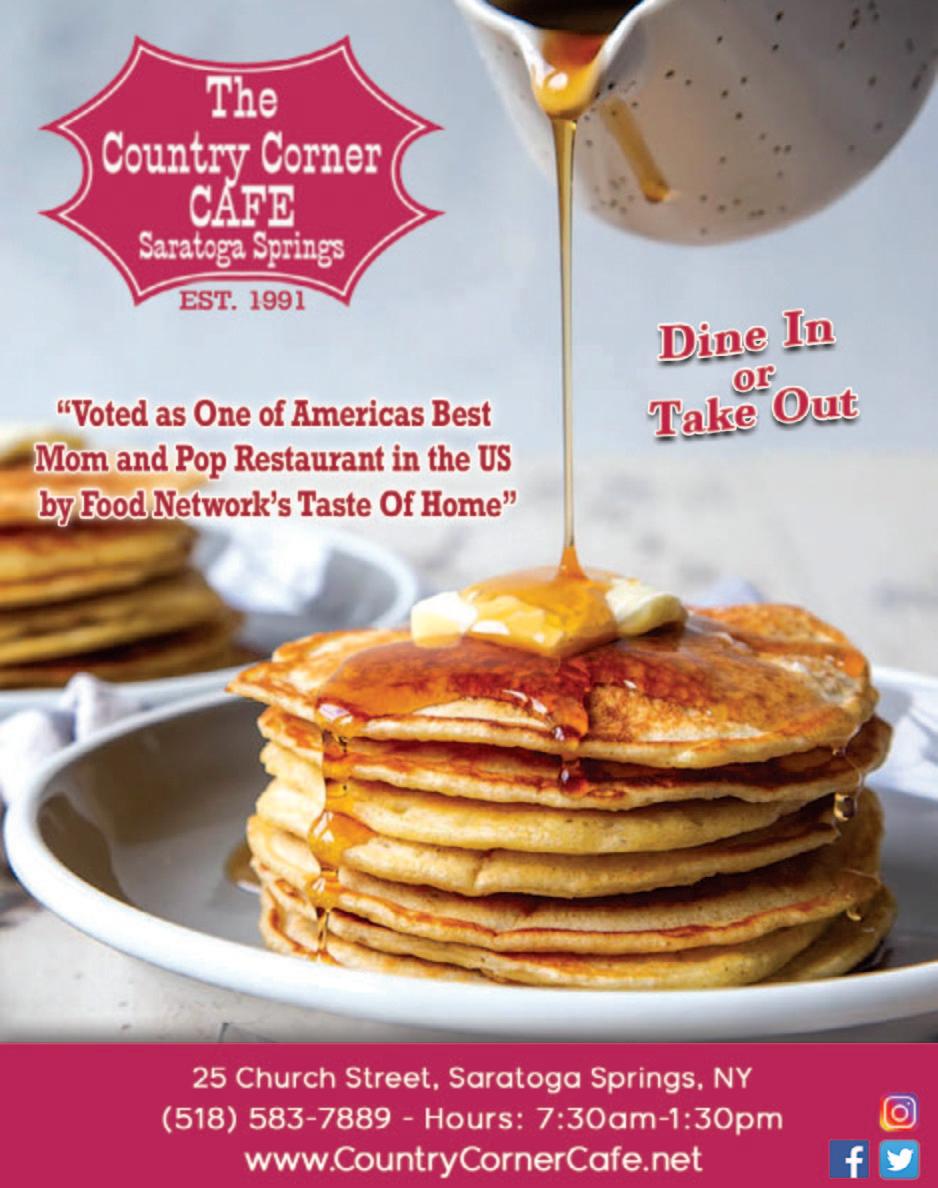



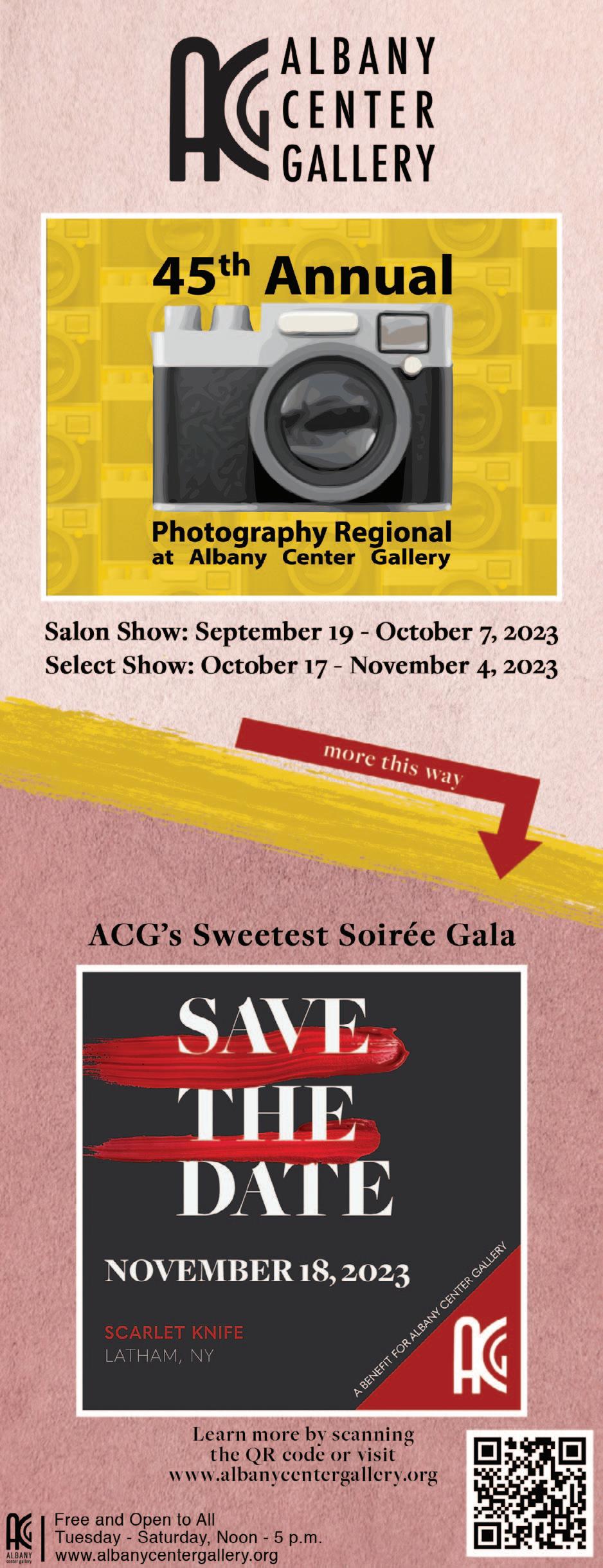

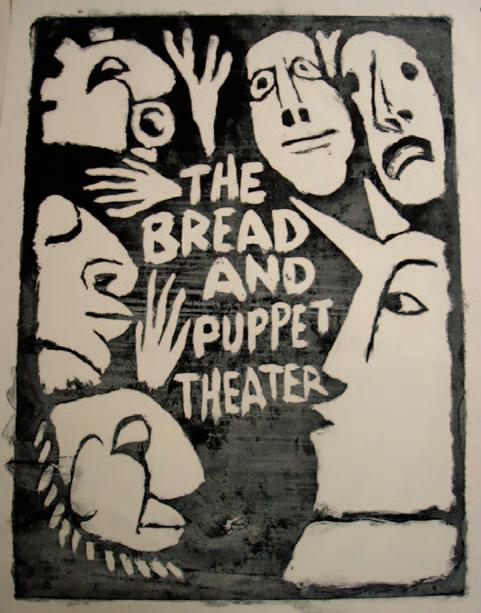
 by Chandler Stevens
by Chandler Stevens
Puppetry.
It’s a performance art that hearkens back to the 5th century BC in Greece, and yet this unusual place we are about to present has its roots in German Expressionism...because of one imaginative German with a vivid imagination and a work ethic that tries to keep up with his mind.
By definition, puppetry is the making and manipulation of puppets for use in any kind of theatrical show. At its most basic, the puppet is a figure but that figure can be a representation of human, animal, or even abstract in form. But of greatest importance is that the puppet must be moved or operated by a human and not by any kind of mechanical aid. To use an example cited in Britannica, a doll is not a puppet, so the child who plays with a doll as if it were a representation of a living baby is not presenting a puppet show; however if she “performs” before her parents and friends making the doll walk along the top of furniture while she vocally acts the part of a real baby, she is then presenting a puppet show, however primitive it may be.
Puppet shows appear to have existed in nearly every civilization. In addition to records of them existing in 5th century Greece, there are numerous records found of puppet theater in Asia. In the United States, there are records of Indigenous People using puppet-like figures in their rituals, and so it goes throughout nearly every civilization. Although a primitive instinct, it has pre-dated written drama everywhere in the world.
The essence of puppet theater and perhaps the one that sets it apart from other theatrical productions is that it is impersonal. It’s a “thing” rather than a person sharing this characteristic with actors who wear heavy masks or are heavily made up which then constitutes a mask. The puppet is not unlike the stock characters of Greek and Roman drama, the masked characters of the Commedia dell’arte of the Renaissance, circus clowns, witch doctors, and even the Mummers.
The genre of this unusual theatrical performance lacks any personality, so the audience has to work harder to find any rapport between themselves and the puppets. Therefore, imagination is put to the test at every turn of the presentation.
Fast forward now to 1963, a tumultuous time in American history. A time of protest, war, hippies testing boundaries, and rising up as
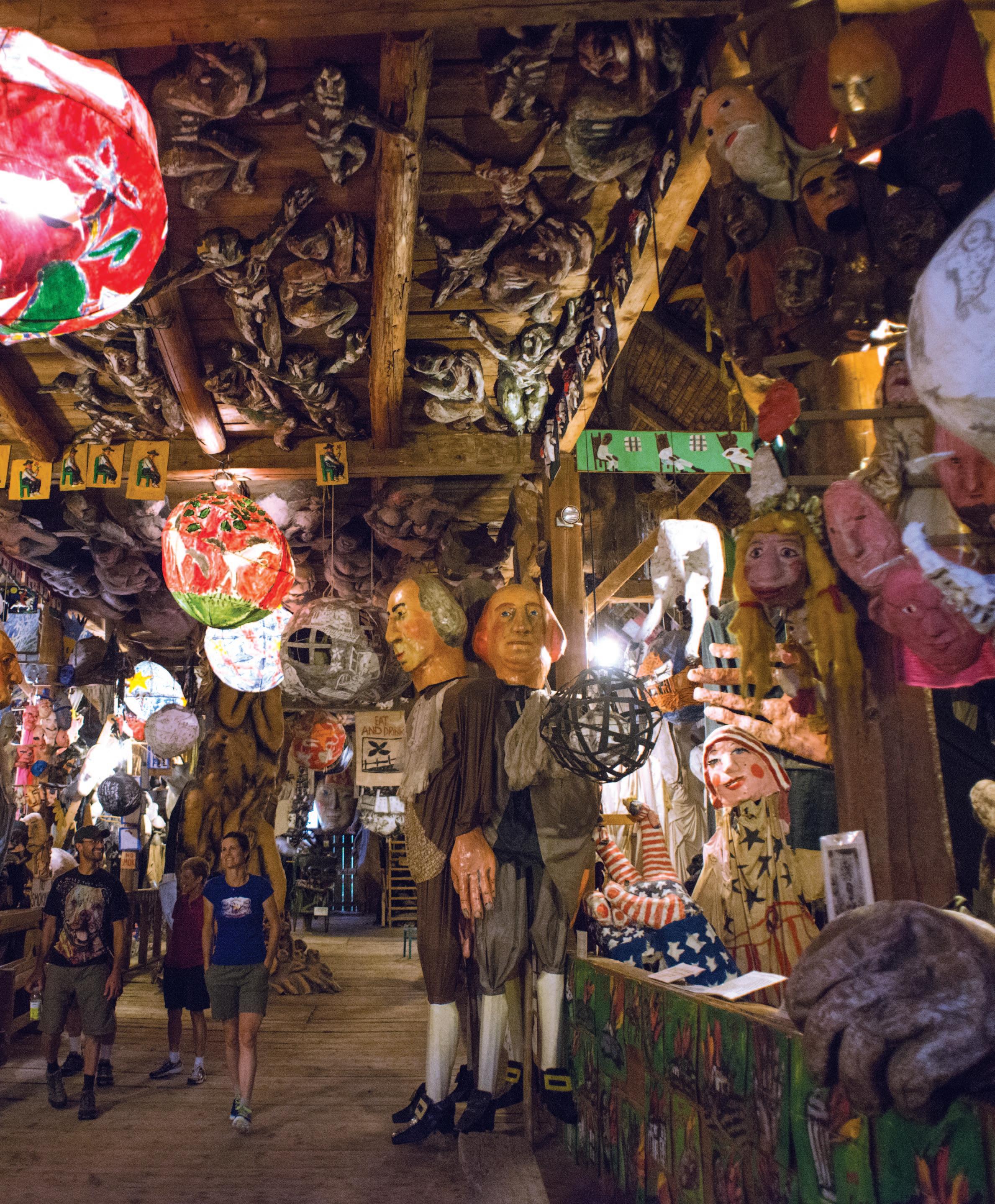
many voices became one. Peter Schumann had been a sculptor and dancer in Germany before moving to New York in the early ‘60s. Along with his wife, Elka, they founded The Bread and Puppet Theater in 1963 in New York City, its unique name coming from their baking of fresh bread which they distributed to their audiences prior to each perform ance. Within a very short time the theater company became known for what The Buffalo News called, an “anarchic, noncommercial, participatory, and politically charged approach to art.” The shows were all different but had in common the fact that the puppets were all giant specimens of folk art, often so overreaching that they frightened the audience.
After a decade of filling seats and turning heads with his giant puppets at street parades in New York and garnering at tention throughout the United States, Schumann was offered a position at Goddard College in Plainfield, Vermont to become the college’s first theater-in-residence. In 1970 Peter and Elka moved to the Northeast Kingdom where they eventually made their home in the tiny town of Glover, population just 1100.
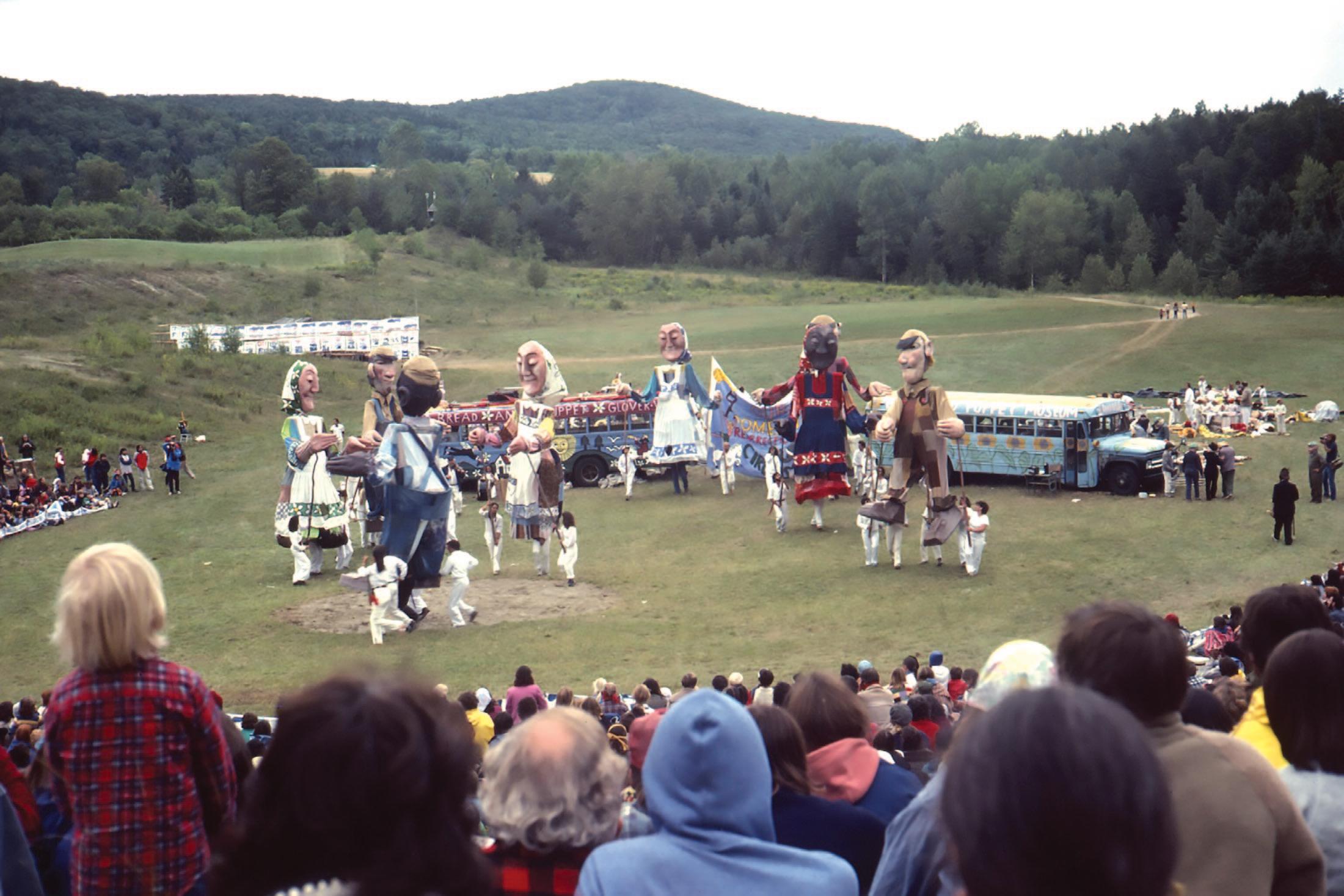
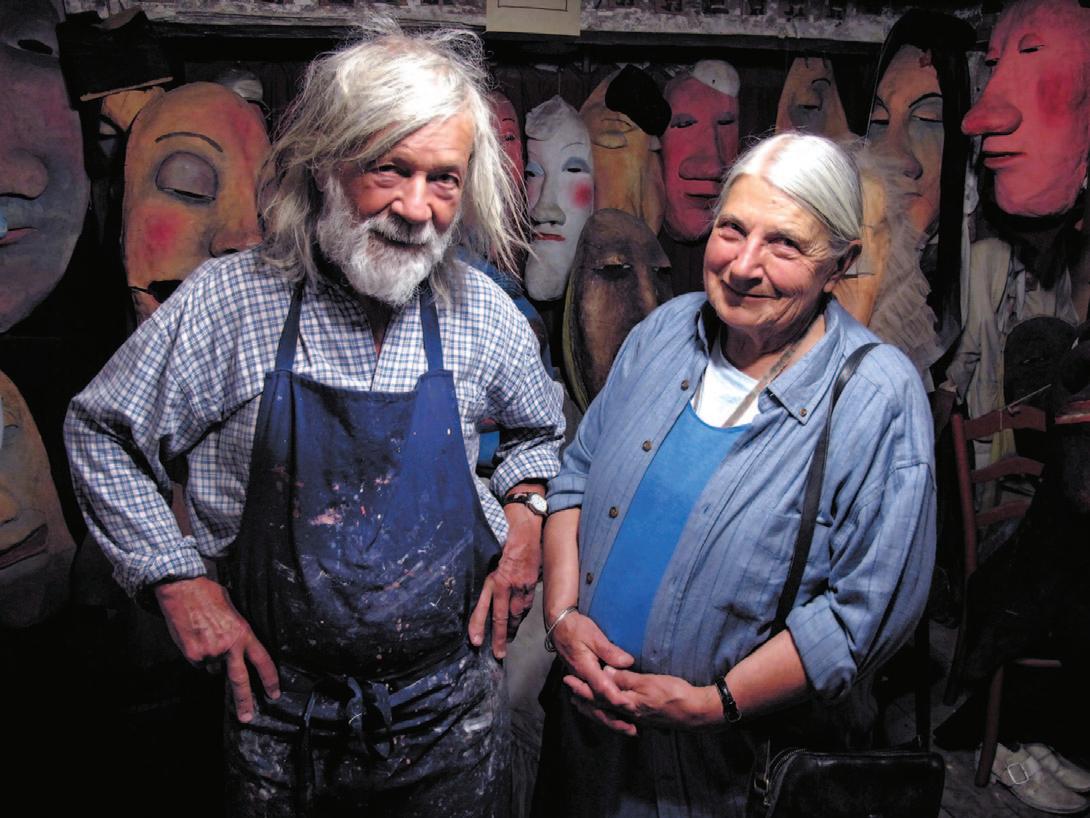
Just a few years into his tenure at Goddard, Schumann developed his most famous work, The Domestic Resurrection Circus. This was a com bination of some 50 performances over two days encompassing vaudeville comedy laced with sharp political commentary. Along with the company’s trademark giant puppets, the Circus became a yearly tra dition until its last year in 1998 attracting more than 30,000 people in attendance.
But Bread and Puppet Theater has not ended...not by a long shot! Since 1998 a smaller circus is performed by the company every weekend in summer, never at a loss for political fodder and its irreverent finger- pointing at our human condition; still, freshly baked bread with a dipping sauce is circulated throughout the audience before every show begins.
Schumann, who is now 83 years old is still active as a painter, and al though Elka died two years ago, he continues his work in Glover and the theater...and the museum!
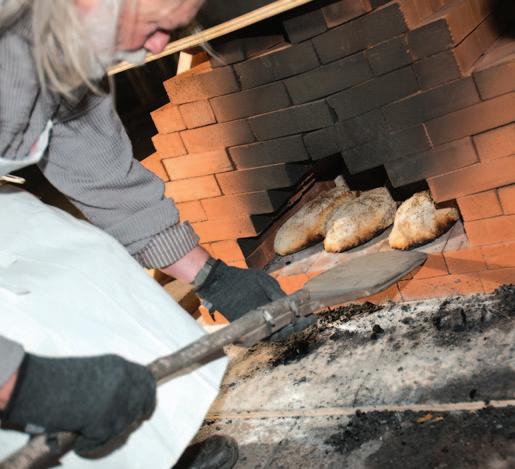
Yes, there is indeed a Bread and Puppet Museum. The 150 year old rickety hay barn was transformed into a museum for veteran puppets, sort of an independent living facility for over-sized and much-loved seniors. It is one of the largest mu seums of giant puppets, masks, graphics, and paintings in the world and represents all of Schumann’s rants from his days in the streets of New York protesting the Viet Nam War, the rats in the neighborhood, and the police; to poverty of the poor, arrogance of those who supported wars, and still his belief of the glory in this world.
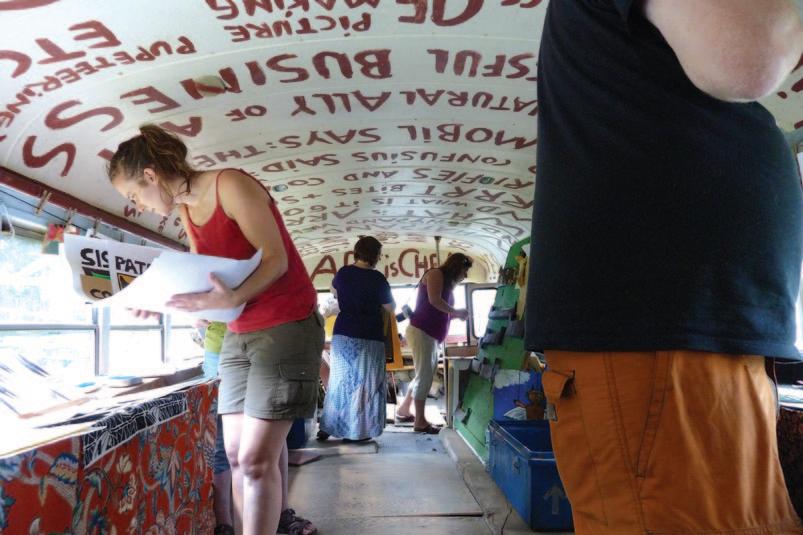

Within the fragile old walls of the museum, the puppets continue to “work.” Grouped ac cording to size, they recreate scenes from shows of the past and become their own artistic
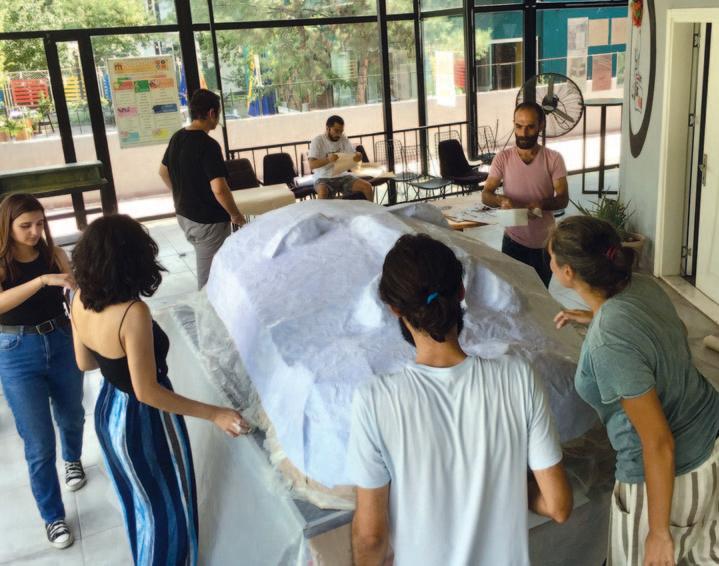

compositions with banners and paper mache re liefs. Over the years, the barn has grown ex ponentially as the collection has expanded now filling two floors and spilling out into the woodshed, the Cheap Art Bus across the road, and onto the walls of the Paper-Mache Cathe dral behind the barn. Like any good mu seum, there is a store chockablock with Bread and Puppet’s posters and publications for sale. Yet unlike most good museums, admission is free with donations being welcome. The hip pie may now be 83, but his ideals have not changed much. He is still for the people and es chews capitalism.
The contents of the Museum represent more than a half-century of Peter and Elka’s hard work, energy, and ongoing creativity. While
Schumann is the artist, the actual detailed pro duction of each puppet is largely the result of a monumental effort produced by a talented, dedicated group of puppeteers. They are joined in this by the local community as well! A com munity of neighbors, friends, and apprentices who build the puppets and the masks, ap plying layers of paper mache over Peter’s sculpted clay models.
Simple materials like cardboard, poplar saplings, and clothing garnered from rummage sales complete the large-size figures. During the
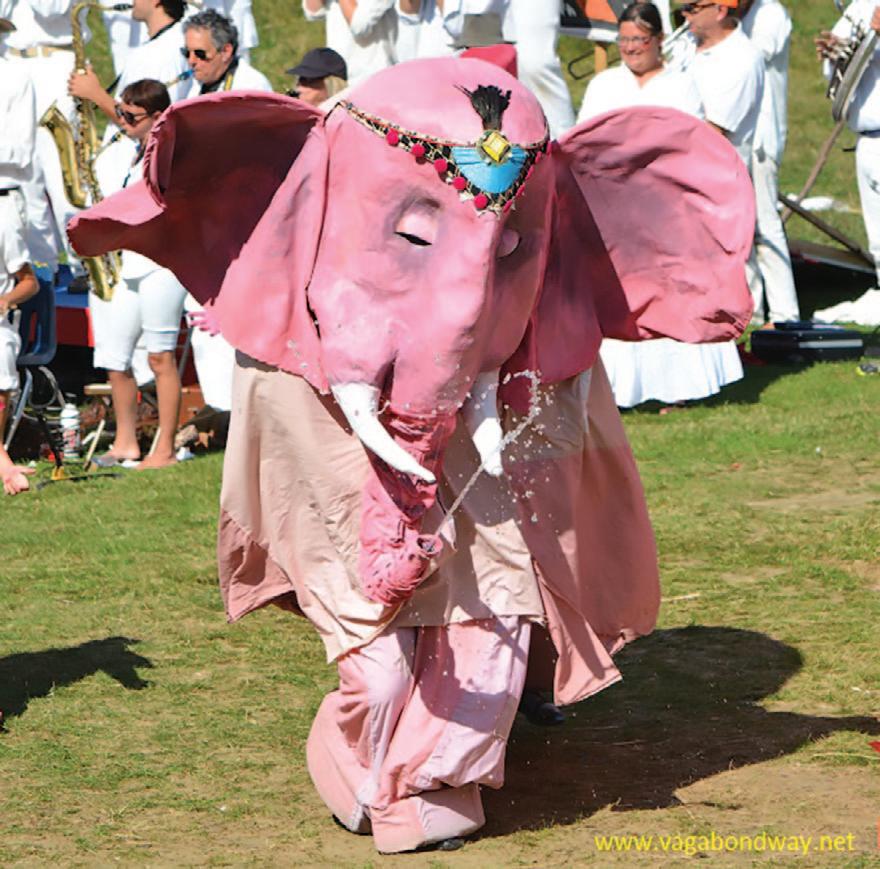 Photo by James Poolner
Inside the Art bus Photo by James Poolner
2021 Domestic Resurrection Circus
Adam Cook explaining different cardboard puppetry techniques...
Photo by James Poolner
Inside the Art bus Photo by James Poolner
2021 Domestic Resurrection Circus
Adam Cook explaining different cardboard puppetry techniques...
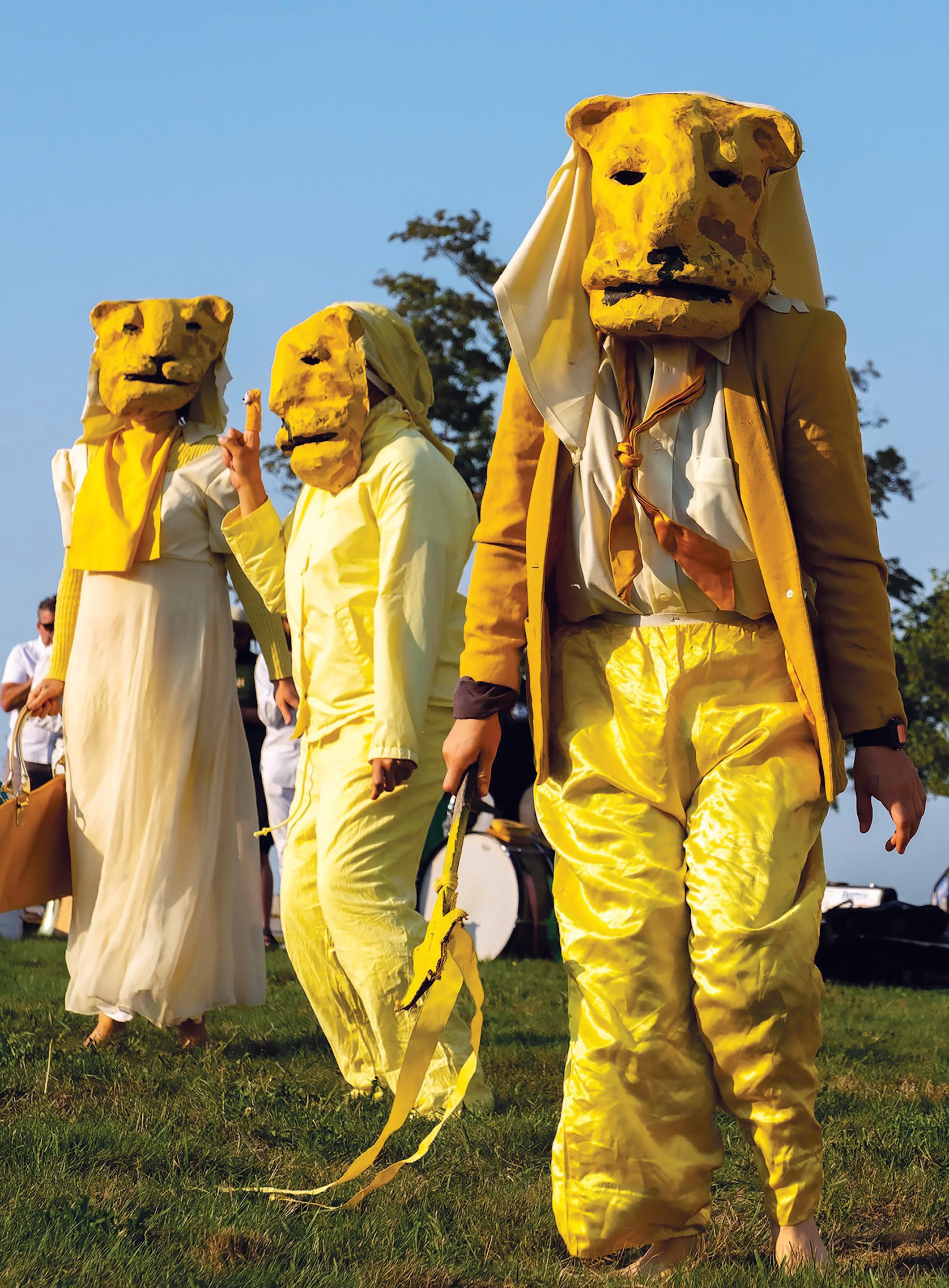
summer months, visitors may observe work going on in the front yard of the Museum next to which is the clay oven where Schumann bakes his famous sourdough rye bread.

Yes, It is unique indeed, but it blooms where it is planted and has been perfectly planted in the North east Kingdom. The museum will be open daily 9AM-6PM until November 1st this year and before and after all evening per formances. Yet another reason this museum is unlike others stems from the fact that most museums are about preservation, and this one is resigned to the fact that eventually there will be deterioration, and the mammoth puppets will one day, as will we all, go back
to our original material. Therefore, it is suggested you come NOW. Why wait and perhaps risk disap pointment at seeing something that doesn’t exist elsewhere?
The sign at the entrance says it all, “Enter at your own risk. Just open the door and turn on the lights when you arrive, and when you leave, close the door and turn off the lights.”
Apparently, the puppets take it from there.
To reach the theater and museum at 753 Heights Rd. in Glover, contact www.breadandpuppet.org It’s about 177 miles away, but you won’t be sorry! (802) 525-3031








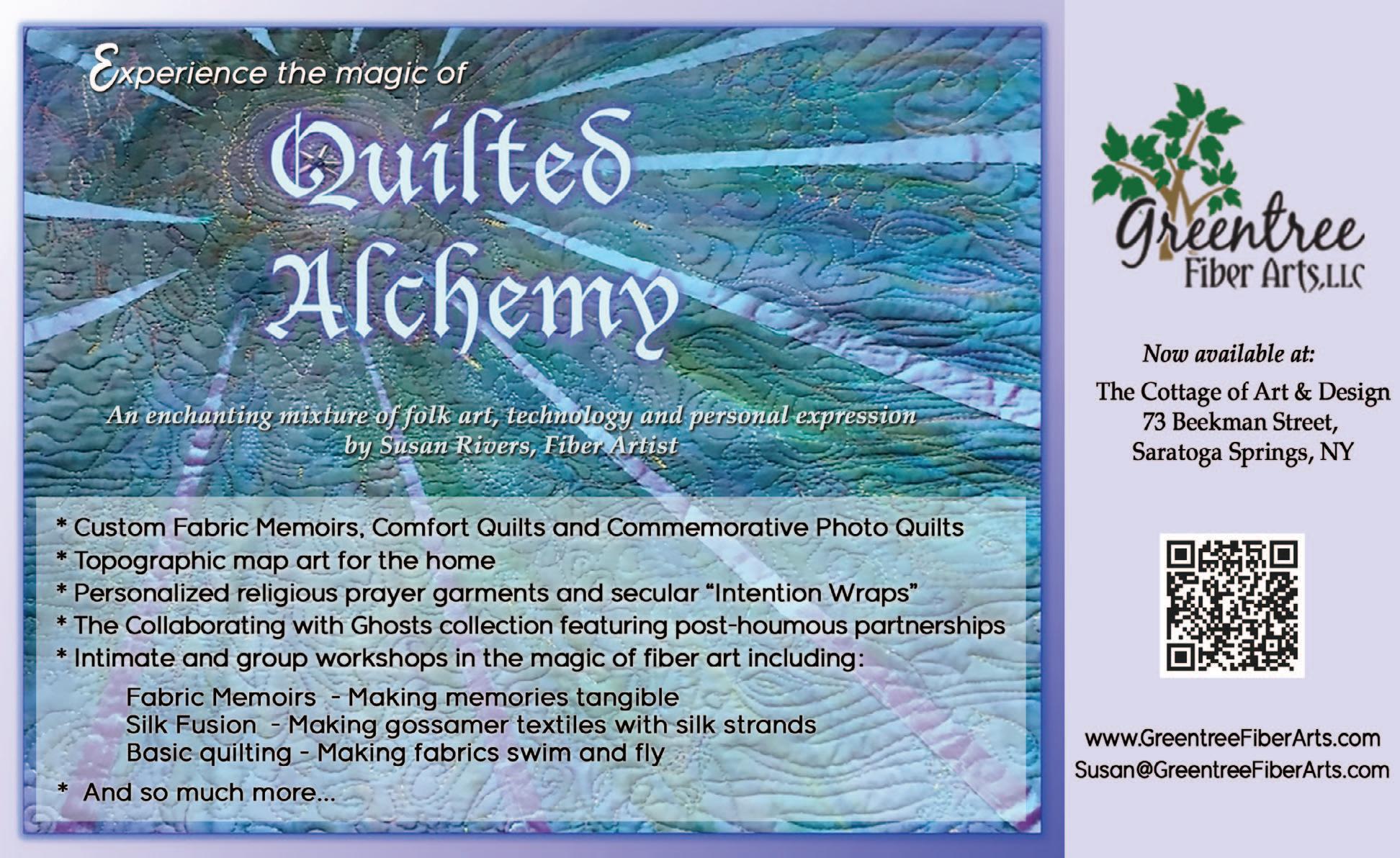

 by Karen Richman
by Karen Richman
It wasn’t supposed to turn out this way.
It was going to be so easy. We had it all figured out, and it was foolproof.
Except for one thing: the three fools who were about to pull this off were all nine years old. That was comprised of me, my friend, Elaine who lived across the street and went to parochial school and had to wear plaid jumpers and saddle shoes, and my friend, Jane who was very timid, never had an original idea of her own, and just sort of followed us around doing whatever we told her to do and going with the flow. So we weren’t exactly Ma Barker’s gang when it came to committing crimes, even childish ones.
But this was serious stuff. This was Halloween, and there was a whole lot of candy at stake. Not just that, but back then there was no such thing as midget-size candy bars, those ridiculous one-bite wonders that people throw in kids’ bags today. Nope, these were big regular-size bars. Big Hersheys that came in boxes of twelve, wax lips and wax teeth in indi vidual wrappers, Baby Ruths, Butterfingers, Milky Ways, 3 Musketeers, not to mention the fun stuff like Pez dispensers with cartoon heads, candy necklaces, and atomic fireballs. Some of the homes in our neighborhood didn’t buy Halloween treats, they made them! De licious, crunchy popcorn balls and caramel apples that were bright red and so sticky that when you bit into them, they stuck to the roof of your mouth. But, boy they were fun. That was Halloween candy at its
finest, and we were in search of the biggest, the best, and the mother of all heists this Halloween.
We figured we needed three costumes that were very roomy and very long, so people couldn’t really tell who was under them complemented by elaborate masks that slipped over our heads with elastic. I came up with the idea that since my hair was short and kind of straight and Elaine had reddish curls and Jane had a long ponytail, we should tightly pin our hair up with bobby pins. I told my parents that I would be trick or treating with Jane and Elaine, and since long ago these friends had been deemed “safe” by my parents, and I had passed a similar test with each of theirs, we figured we had checked all the boxes. We decided to meet at Jane’s house to get dressed and ready because her father worked nights, her baby brother would be asleep, and her mother suffered from a “perpetual headache,” so she would be more interested in lying on the couch reading Photoplay than worrying about us three kids getting ready to rid the neighborhood of all their candy.
In keeping with the “rules” we had established, we all had sheets or capes of similar sizes and adequate face coverings. So I was a ghost (original, huh?), Elaine was a witch, and Jane was a fairy princess. When we were all properly covered with headgear firmly in place to cover our faces, off we went with large shopping bags (we judged pillowcases not nearly big enough for what we’d be hauling in) for the anticipated larder.
The first house produced some of those big Hershey bars, and we were even asked if we would prefer them with or without nuts. “Yes!” Elaine shouted, ever the smarty pants. Lo and behold, the homeowners gave us each both! We were off and running! When we finished the three-block area that comprised our neighborhood, we ducked behind a tree and quickly switched costumes, and off we went again. A couple of neighbors gave us the fish-eye, one even remarking, “Weren’t you here already?” but we shook our heads and gave a muffled “Uh-uh, nope.” Third time around, our shopping bags were full to bursting, and now folks were beginning to push aside their curtains, look out the window, and not always answer the door, so we headed for my house to count the booty.
We were met at the door by my father who had the keys to the Chevy Bel Air in hand. “Get in, girls,” he said sternly. “We’re going for a ride.” I put on my cutest innocent voice and said, “Where we goin’, Daddy?” The response was swift.
“We’re going to return candy to the neighbors who have run out. Then we’re going to the police station which is collecting candy to take to the orphanage in town, and you will turn in ALL your candy.”

We were too deflated to protest as he summed up his ire with, “The next time you try this, at least tell Elaine to change her parochial school jumper and saddle shoes. It was a dead giveaway everywhere you went, the neighbors told me.”
Happy Halloween, everyone. Just remember, one trip only!
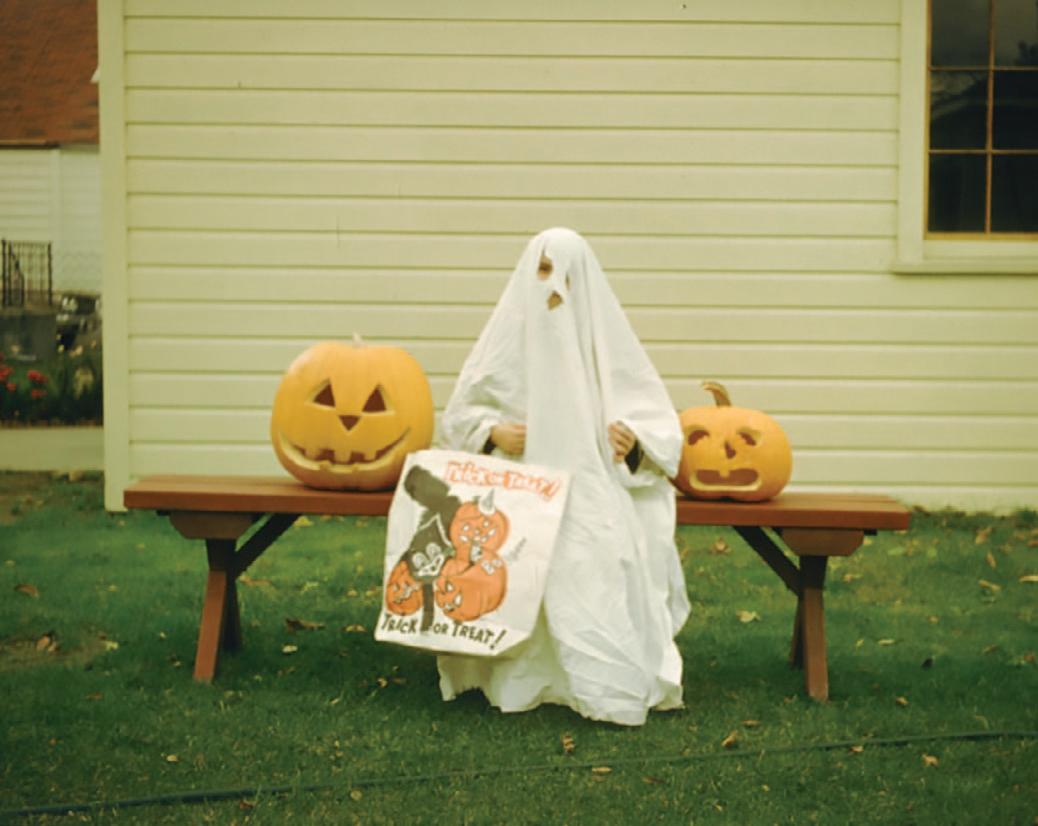

Crystal Cobert-Giddens, LE
Humans have been tracking the Moon, observing its changes, and notic ing our connection with its monthly ebbs and flows since we ob served that bright orb in the sky. Sleep, our emotional cycles, health, and our love life have all been linked to the Moon.

The Moon exerts a strong gravitational pull that causes the changing tides in our oceans and seas. This gravitational pull is at its strongest during the New Moon and Full Moon. Considering we humans are made up of 70% water, it only makes sense that the Moon would have a similar impact on us “water beings”. It's believed that during the New Moon and Full Moon, our emotions, like the tides, are pulled to the surface and that our feelings are bigger and somewhat unpredictable…just like the oceans tides.
Several studies have shown that people experience 30% less deep sleep during the Full Moon as compared to the rest of the month. Why? Some researchers believe our internal biological rhythms may be linked to the Moon's cycle.
Lack of restorative sleep can have pronounced effects on your overall mood and can cause irritability, impatience, and elevated levels of cortisol.
If we believe that the Moon has an affect our sleep, our mood, and our emotions, how can we work with these cycles and align with the flow of nature?
What looks to us like no moon (or a dark moon) happens when the Moon is positioned in alignment between the Earth and the Sun. We don’t see the illuminated side of the Moon that’s facing the sun, so it appears dark.
How does the New Moon affect us?
This low-light phase can make us feel tired, introspective, and ready to indulge in some much-needed introvert time.
How to make the most of this phase:
Now is the time to put on some fuzzy socks, get warm and spend some
time with yourself. Read a book. Write in your journal. Take time to reflect on how you’re feeling and honor any desire to stay home, cancel plans, and not return texts. Schedule a facial or a massage.
WAXING CRESCENT MOON
“Waxing” means that the illuminated portion of the Moon is increasing. In the waxing crescent phase, only a crescent-shaped sliver is visible to us.
How does the Waxing Crescent Moon affect us?
After relaxing, recharging, and reflecting in the New Moon, you’re ready to go forth with light and increased energy.

How to make the most of this phase: Thank the universe in advance for all the beautiful things you know will be coming your way. Write down your intentions.
FIRST QUARTER MOON
The Moon is at a 90-degree angle to the Earth and Sun. We see half the Moon illuminated and the other half in shadow. In the first quarter, we see what appears to be the right half of the Moon.
How does the First Quarter Moon affect us?
This balance of light and shadow reflects the obstacles you’ll start to encounter as you bring your intentions to life.
How to make the most of this phase: Go with the flow and gracefully accept redirection.
WAXING GIBBOUS MOON
Just like the Waxing Crescent Moon, the illuminated portion of the Moon is increasing towards the Full Moon.

How does the Waxing Gibbous Moon affect us?
This phase signals redirection, adjustment, and flexibility. Your plans are being challenged, and your patience is being tested.
How to make the most of this phase: Be flexible. Listen to your intuition and trust in your own innate wisdom.
FULL MOON
In this phase the Moon is full and bright. The Sun, Moon, and Earth are in alignment. The Moon is on the other side of the Earth, so we see the side that’s being illuminated by the Sun.
How does the Full Moon affect us?
The Sun and Moon are in opposite zodiac signs during this phase and you may feel tension and extra “crazy energy” as these opposite energies pull on you.
How to make the most of this phase: Channel this heightened energy into projects and activities that light you up. If you’re receptive and open, you may see new opportunities stemming from your intention setting earlier in the month.
“Waning” means that the illuminated portion of the Moon is decreasing.
How does the Waning Gibbous Moon affect us?
As the light of the Moon decreases, our energy decreases. We feel satiated and grateful.
How to make the most of this phase: Sit down with your gratitude journal, send some thank you notes, and spread the love that’s rising inside of you. Take this time to reconnect with the humans you may have neglected (or snapped at) during your highen ergy/high-emotion full moon phase.
The Moon is at a 90-degree angle to the Earth and Sun. We see half the Moon illuminated and the other half in shadow. In the third quarter, we see what looks like the left half of the Moon.
How does the Third Quarter Moon affect us?
As the light continues to fade, you may feel the need to cleanse, release, and let go.
How to make the most of this phase: Forgive, release, and purge whatever is no longer serving you. Clothes, old makeup, toxic relationships. Make space.
The illuminated portion of the Moon is decreasing and we’re moving towards the New Moon. In the waning crescent phase, we see only a sliver of the illu minated Moon.
How does the Waning Crescent Moon affect us?
The light is almost gone and you’re ready for rest and recuperation.
How to make the most of this phase: Take some time to align yourself with calm, relaxed energy. Relinquish your need to control everyone and everything, and trust that all will be well.
FACES
55 Beekman Street, Saratoga Springs, NY 518-396-7403 triLiftofsaratoga.com
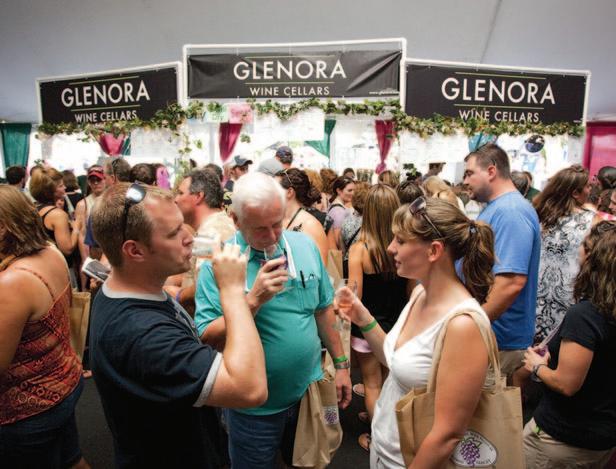
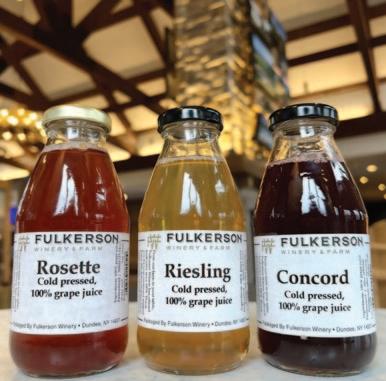
 By Chef Armand Vanderstigchel
By Chef Armand Vanderstigchel
The following morning after an enjoyable visit at Konstantin Winery in Keuka Lake, the pursuit of visiting more Finger Lake wineries continues. A quick breakfast is enjoyed at the Finger Lakes visitor center where a large variety of cooked to order sandwiches are offered along with local wines, brews, coffee, and unique non-alcoholic beverages under the moniker Finger Lakes Welcome Center's theme "Wine and Water," p ay ing tribute to the region's famous vineyards and namesake lakes. I en joyed the “Canal Side grilled Cheese” made with local Happy Valley Farm Cheese varieties & Pesto and for beverage the delicious non-alcoholic cold pressed Grape Juice varieties of Rosette, Riesling and Concord pro duced by the renown Fulkerson winery & Farm in Dundee, NY. They were so good I had to try three of the varieties!
The Taste NY Market at the Welcome Center, partners with over 1,800 New York State farmers and producers- a wonderful program!
The first winery of the day was the celebrated Fox Run Vineyards located on the West side of Seneca Lake in Penn Yan. There is a beautiful deck overlooking the vineyards and Seneca Lake. Directly connected
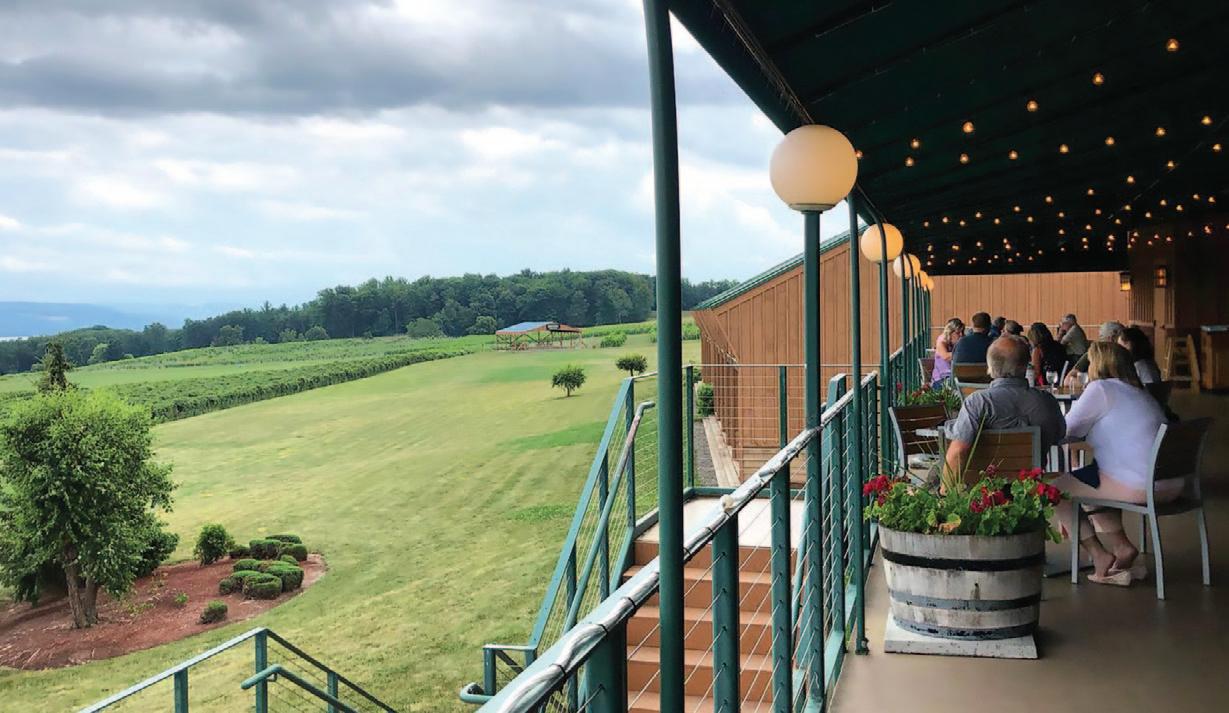
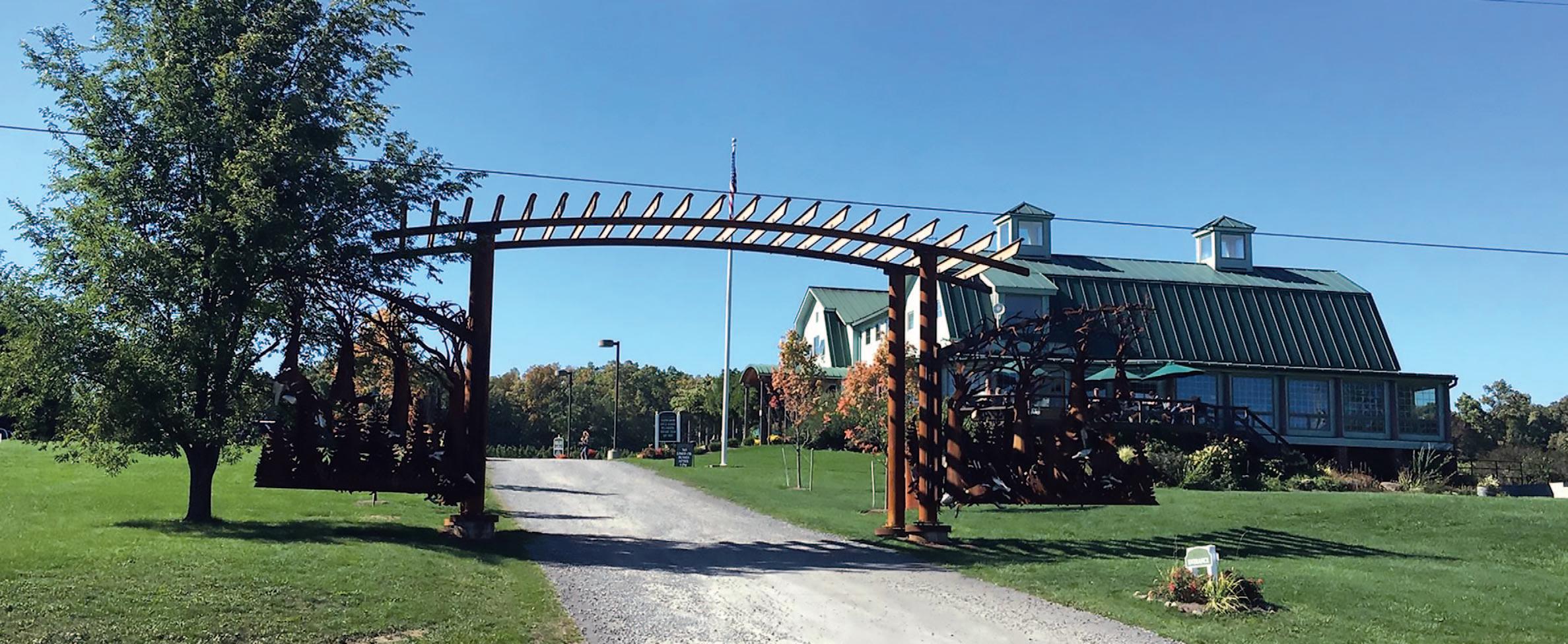
is the café which offers wine by the glass or bottle. Self-guided wine flights are available for purchase in the café or tasting room. The café menu is impressive with great Salads, Naan Bread Pizza, and a delicious Mac N’ Cheese skillet prepared with ingredients sourced from local businesses such as Muranda Cheese and Bostrom Farms.
Continuing down NY-14 which runs along the Lake Seneca the next stop is Glenora Wine cellars & Veraison restaurant. This is a beautiful winery resort located on Seneca Lake which opened its doors in 1977 as the first winery on Seneca Lake, pro ducing award-winning Finger Lakes wines and of fering year-round wine tastings and cellar tours.
There is an adjoined Inn for lodging and the restaurant Ve raisons is a from-scratch kitchen utilizing local.
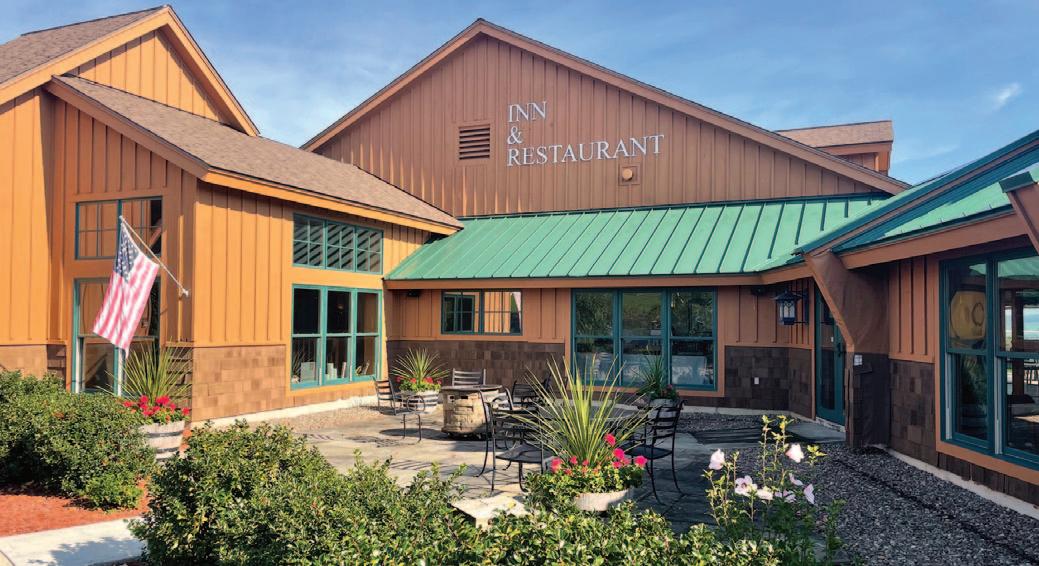
It is a perfect place for lunch with a covered deck overlooking the lake and an assortment of creative Burgers, Salads, and continental dishes.

Ensuing, I visit the showstopping facility of Lakewood Farm also located on the west side of Seneca Lake, with east- facing slopes gently lead ing down to the shores. Owned and operated by the Stamp family since 1951, the vineyard’s first grapes were sold to Welch's Grape Juice Company in 1955. As the economic climate for small commercial grape producers became challenging, the Stamps took the next step and started making wine from their grapes which supplies 15 varieties.
In 1965, when First Lady, Lady Bird Johnson initiated her program to beautify our nation’s roadsides, Frank and Lucy Stamp contributed by planting a row of roses along Route 14.
In 1974, with the roses in full bloom, Lucy Stamp sent a letter and photo graphs to Lady Bird Johnson. They received a response from the First Lady, commending the Stamps for their “contribution to a more beautiful America.”
Each of the wines now features a rose on the label-the wine bottles are amongst of the most beautifully designed and eye-catching in the region. The modern tasting room and the wine-ma k ing fa cility is a show-stopper upon your arrival in terms of design and visuals of the fermentation tanks seen through the window. Adjacent to the tasting room is a beautiful lawn with tables stretching out directly along the vines with walking access to the Lake.
The final reward heading south along Seneca lake is visiting Watkins Glen State Park and the iconic most photographed little Red Gazebo/Pier-house on the Seneca Lake pier overlooking the abundant body of water.
Finalizing the extensive wineries excursion, I walk off some wine-calories by visiting Watkins Glen State Park-the most famous of the Finger Lakes State Parks. It is considered a natural wonder with 19 waterfalls that cascade down the stream and rock formation. I hiked along the busy Gorge Trail which is visually stunning, while being careful of the slippery steps.
After a quick swim in the beautiful large outdoor pool in the park, I opted for scenic photo opportunities at the Seneca Lake Pier. Complimenting the beautiful Red Pier-house are many hotels and restaurants on the pier to explore and dinner cruise options.
The eastern road north along Lake Seneca is beautiful during sunset with abundant wineries, breweries, and little restaurants.
Navigating away from Seneca Lake in the direction of Seneca Falls to connect to the thruway 90 towards Albany, I stopped at “the Village Soft Serve” in the small town of Ovid near Lodi. Delicious Ice Cream made with local Milk from “Upstate Farms Milk Co.” It was hands down one of the best soft serves I ever tried and belated regrets for not going back for seconds.
The highlight of this trip for me was the pleasure of witnessing this region supporting, developing, and strengthening its cottage industries. By keeping them striving, it inspires new generations of culinary artisans, wineries, and breweries.
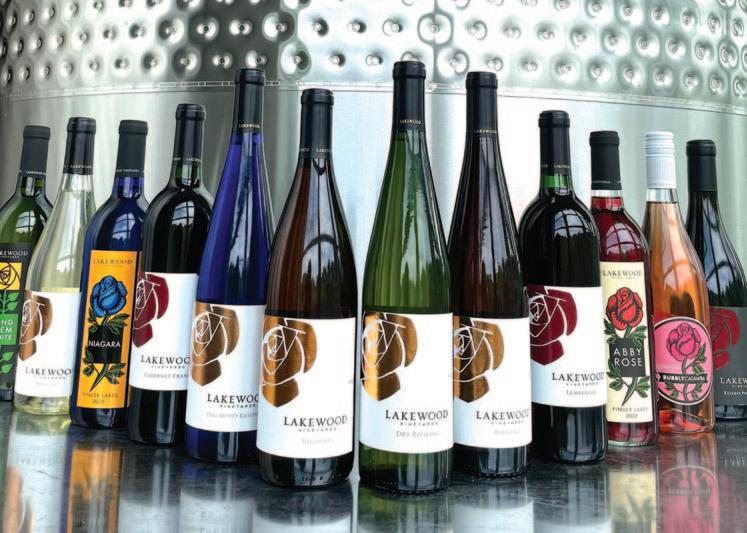
A trip to the Finger Lakes region will be one of your great decisions, followed by great memories and a reinvigorated appreciation of our beautiful state.

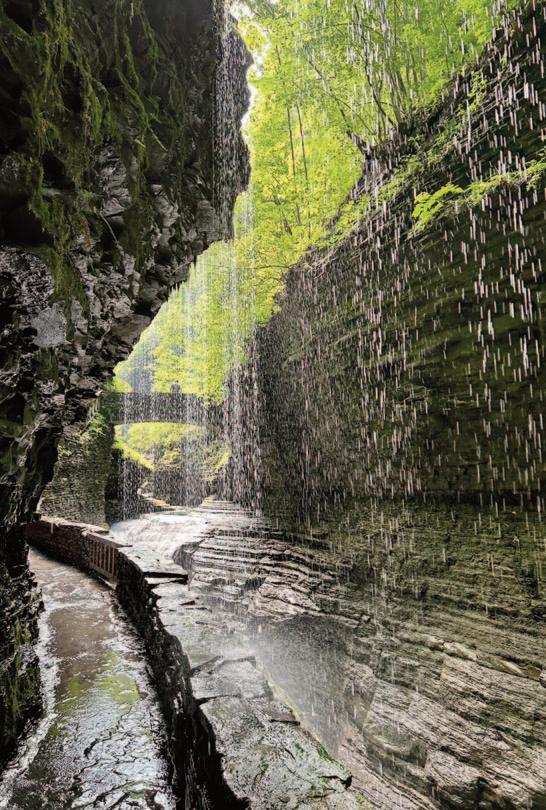
October 1 - 12 Delmar
Thomas Joseph Exhibit, ‘Ladies at Leisure Part 3”. Thomas Joseph is a physician who, in retirement, has taken up painting. This is his temporary exhibit, and sale, and it is one of the ways the shop meets its mis sion of connecting artists, their works and the Community. Merriman and Pfis ter’s Marketplace, 388 Kenwood Ave, Delmar. For more information, call 518-588-7268 www.merrimanpfister.com
October 1 - 14 Lake George MARRIAGE IS MURDER by Nick Hall. Ex- spouses Paul and Polly Butler used to write murder mysteries together. Now Hollywood has come calling for an original thriller based on one of their old detectives. Can they avoid killing each other long enough to come up with a new story? Find out in this murderously funny comedy!

Luncheon Shows: Tue, Wed, Thu
Luncheon Seating at 11:30 PM, Curtain at 1:00 PM
Dinner Shows: Wed, Thu, Fri, Sat
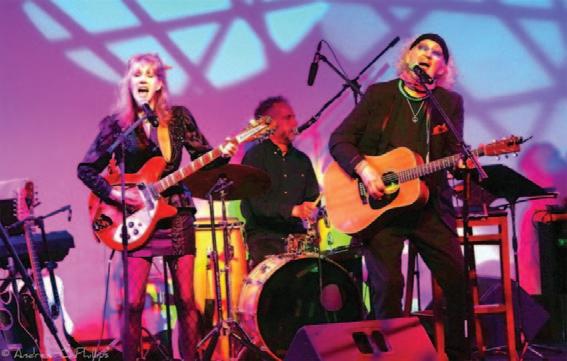
Dinner Seating at 6:00 PM, Curtain at 7:30 PM. Holiday Inn Resort Lake George, 2223 Canada Street, Lake George, NY 12845
October 1 Latham
Helen Frank. Please join us as we welcome our dear friend & artist Helen Frank to the Gallery for an afternoon of Art, con versation and wit! Sunday, October 1st 1:00- 3:00pm. Morningside Gallery, 588 New Loudon Road, Latham, NY 518- 783- 8763 www.morningsidegallery.com

October 1 - 7 Albany
October 1 - 27 Saratoga Springs
American in Paris: watercolor paintings of Europe by artist Matt Chinian. Show runs through October 27. Eden Compton Studio & Gallery, 79 Beekman St., Saratoga Springs


October 1 - 15 Schuylerville
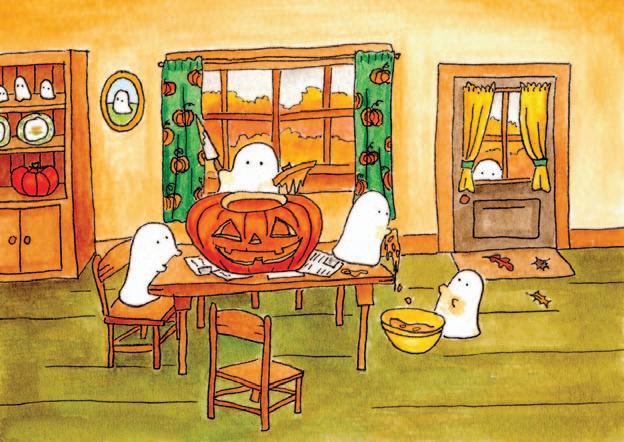
Landscapes - Robert Moylan + Mikel
Wintermantel + William McCarthy + Nancy Magnell + Valerie Craig. The Saratoga Springs and Adirondacks area in upstate New York is widely known for the near picture-perfect natural views that range from calming farm lands and meandering rivers and creeks to the dra matic backdrop of the High Peaks region in the Adirondacks. Autumn is arguably the best time of year to experience the landscapes that New York offers and as we creep into the early Autumn season of 2023. The Laffer Gallery, 96 Broad Street, Schuylerville, NY
October 1 - 21 Clifton Park
The Blooming Artist Gallery presents our newest exhibition, Interpretation. This exhibit, featuring the works of all local artists, serves as a manifest realization of the art of interpretation. This exhibition remains until October 21st; come visit us during our gallery hours Tuesdays - Saturdays or by appointment to view this collection!
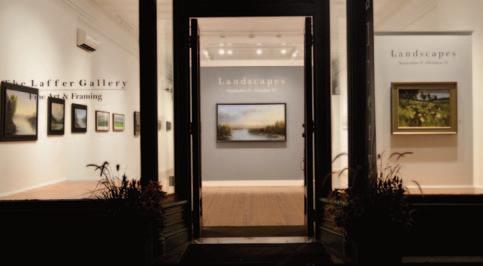

45th Annual Photography Regional at Albany Center Gallery - The exhi bition will begin with a salonstyle show that includes all su bmis sions. It is on display through Saturday, October 7, 2023. The sub mitted work will be juried, and re -installed as the Photography Re gional Select Show, which will be on display from Tuesday, October 17 through Sat urday, November 4, 2023. Artists’. The exhibits are free and open to the public. Learn more at albany centergallery.org
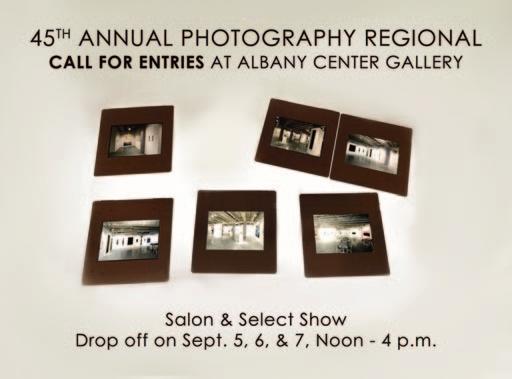
October 6 - November 8 Glens Falls
LARAC's Annual Juried Show. Juror: Jenny Hutchinson. A juried selection of artwork. October 6th @ 5pm: Opening reception for For Reasons Unknown, At LARAC's Lapham Gallery, 7 Lapham Place, Glens Falls.
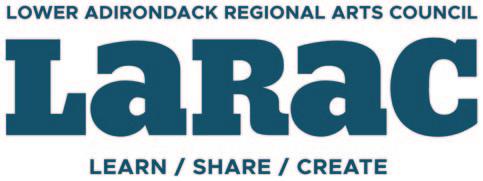
October 6th @ 6pm: Opening reception for the Northeast Feltmakers Guild. At LARAC's Mountain Gallery, 21 Bay Street. Show Dates: October 6th - November 8th
October 6 - December 3
Schenectady
Bear and Bird Gallery Spoopy Season: A selection of Charming and Grotesque Art. Get into the Fall spoopy season with this unique art exhibition, which will be hosting 6 local and national artists whose work will walk the line of spooky-cute and creepygross. Affordable original artwork and prints to add to your personal collection! Featuring the artwork of Matthew Paul, Christopher Ian MacFarlane, Deanna Campagnola, Rudolph Ligett-Ippoliti, Lind say McK eough and El Gato Gomez. Bear and Bird Gallery, 160 Jay St M, Sch enec tady, NY 12305
October 14 Glens Falls
Aztec Two-Step 2.0 featuring Rex Fowler, Dodie Pettit & friends. The story of Rex Fowler and his band Aztec Two-Step is inter twined with the history of folk/rock music in America. Originating from a chance meeting at an “open mic night” in Boston in 1971, then taking their name from a poem by beat poet Lawrence Ferlinghetti, Rex and his former music partner Neal Shulman went on to record four albums on Elektra & RCA Records, helping to usher the music of the 60’s into the 1970s and beyond. The Park Theater, 14 Park Street, Glens Falls, NY 12801 518-792-1150

